
Admin
-
Posts
7,469 -
Joined
-
Last visited
Content Type
Profiles
Forums
Events
Store
Gallery
Community Map
Posts posted by Admin
-
-
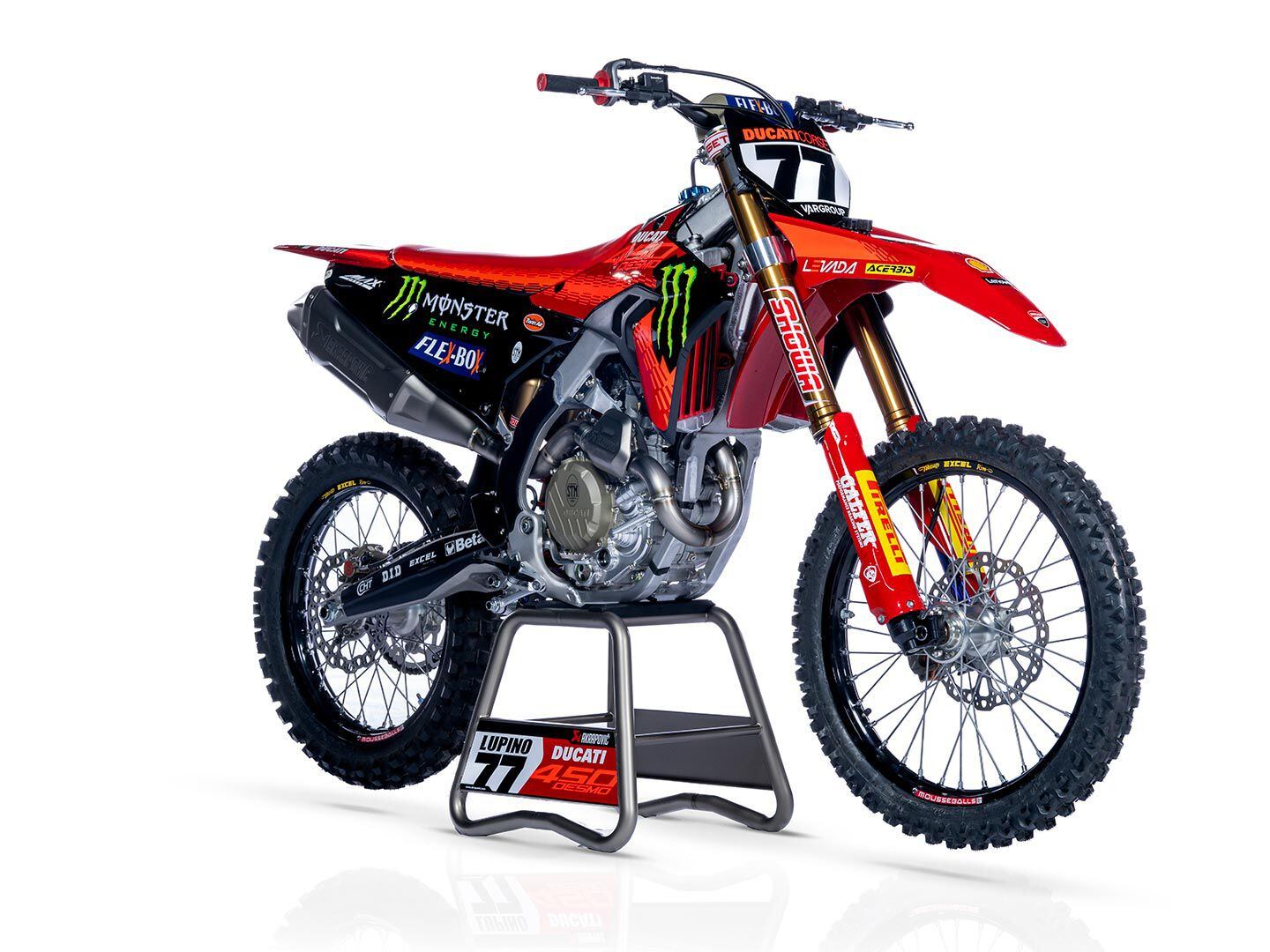
Ducati’s Desmo450 MX racer will go into production in 2025. (Ducati/)A clean sheet. Twenty engineers around a table with the same goal in mind: creating a new milestone for Ducati in a segment it hasn’t explored yet. Strategically it means growth, practically it requires courage. At Madonna di Campiglio on the occasion of Campioni in Pista, Ducati launched the Desmo450 MX in a world premiere.
The Philosophy
The 20 engineers started from scratch because Ducati’s style is not to copy other existing bikes. “The work started with the close analysis of the competitors. In off-road the technical regulations are the same for the last 20 years so our competitors have reached the state of the art in this segment,” Ducati Corse Off-Road technical manager Davide Perni said. “But we wanted to create something unique and we did it in the Ducati way.”
The goals given by Claudio Domenicali, Ducati CEO, were clear. “Strategically Ducati speaks to customers that look for very high-quality products with a medium-high positioning. Passion and sports are part of the brand DNA. Opening to the off-road market, we want to reach a younger audience that can fully enjoy the off-road machine and eventually become the future customer of the Multistrada or the DesertX.”
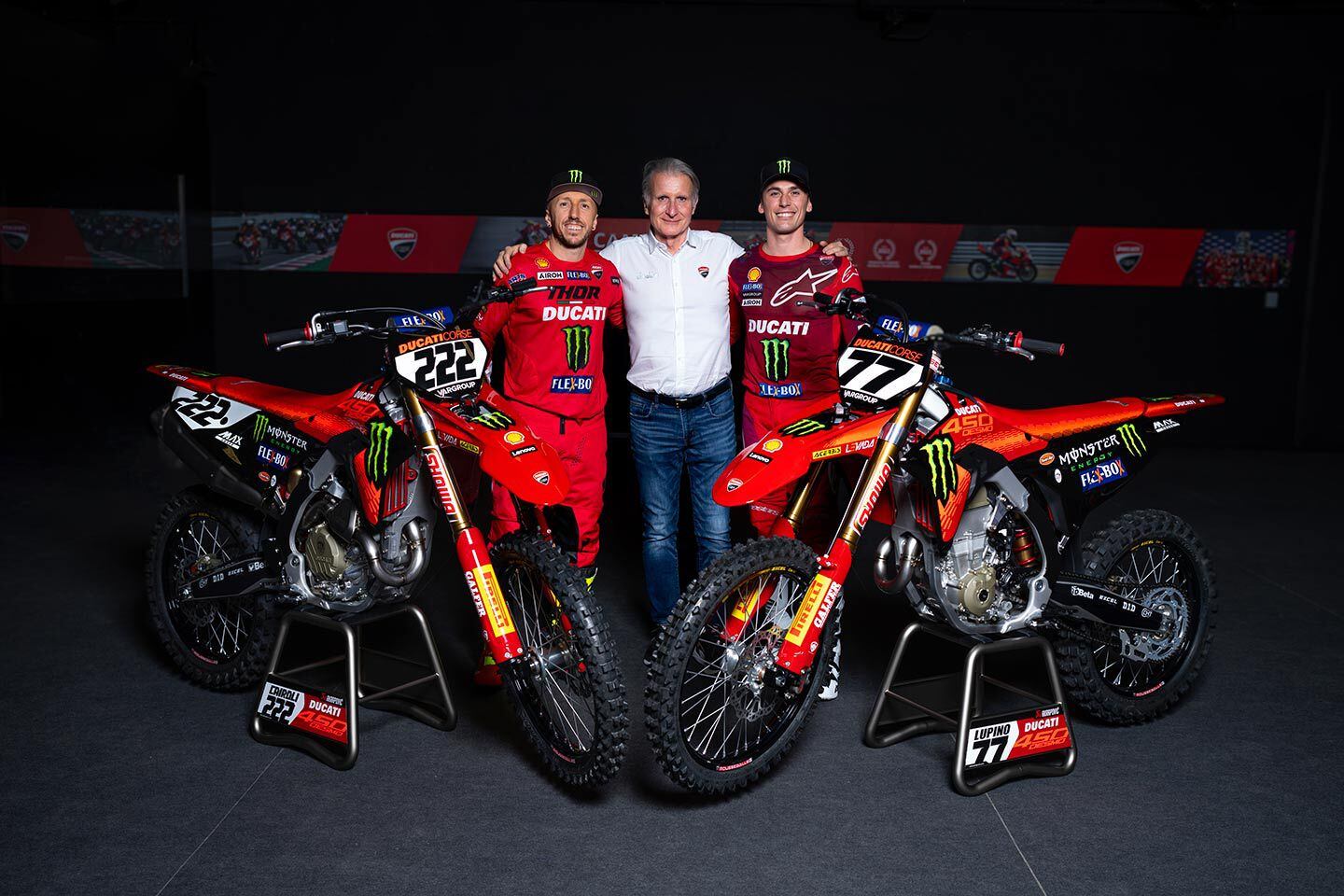
Davide Perni with Antonio Cairoli (left) and Alessandro Lupino (right). (Ducati/)The intention at the start of the project was very clear: to build a bike for young, passionate Ducati customers that is light and performs.
“We are really satisfied,” Perni continued, “because with the Desmo450 MX we have created something different. It’s a prototype closer to a MotoGP than a SBK to understand the way.” The engineer cannot reveal too many details, but he does give us an idea of the incredible work done.
The Chassis
“The chassis is quite unusual in terms of production process,” he said. “It was a challenge starting from a white sheet of paper. The first question was: steel or aluminum? The challenge was to find the right compromise between lightness and stiffness.” In the end the final configuration is aluminum.
The Engine
Desmodromic valve actuation, Ducati’s signature in terms of valve train technology, is the heart of the MX bike. “Desmo works well, but it may be heavy,” Perni explained. “This is not completely true. For sure it is a bit complicated, but for us it is the routine and we were able to use the advantages.”
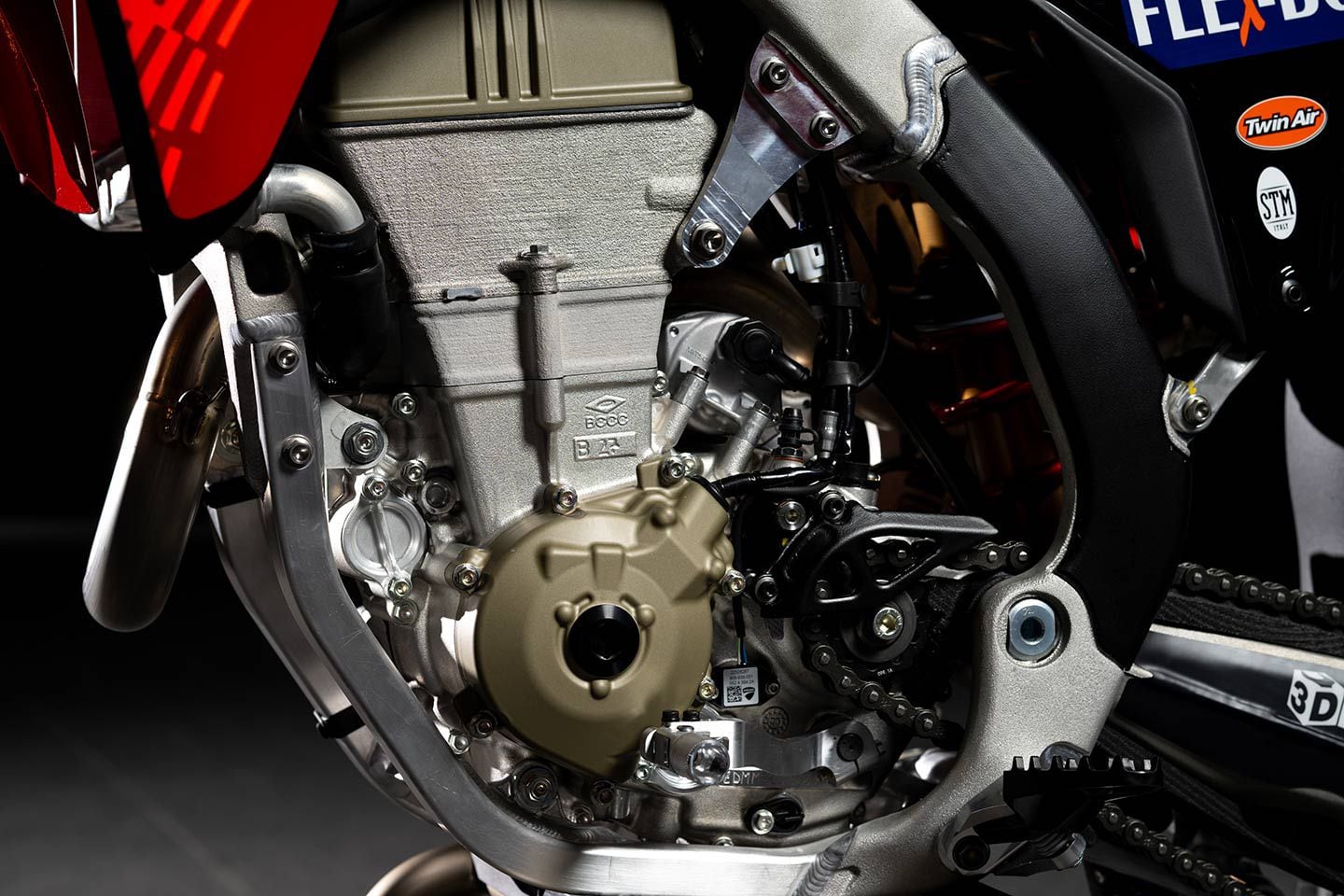
It’s right there in the name: The Desmo450 MX will use a desmodromic valve train. (Ducati/)A fact for consideration is that this is a racing engine, not a production engine. “We wanted to create a racing engine but with the quality and durability of a street-legal engine,” he said, “to give our customers a good bike with a reasonable cost of maintenance. In MXGP we don’t have limits in terms of fuel consumption and emission, you don’t spend too much energy in low rev, this is an advantage of the desmo system. Then of course we have friction and other things but the balance is positive.”
From Racing to Streetbikes and Vice Versa
The connection between Ducati Corse and Ducati production is very close. The two R&D exchange information. “Working with the desmo system,” Perni related, “we could have access to the data in terms of design and performance of both the MotoGP and the production departments. We are working very closely also for the fuel. In MXGP we use the same fuel used till last year in SBK, and we are working on the eco fuel.”
The Timeline
The model is called internally “21J”: the project was started three years ago in 2021. Considering that the Italian brand was exploring a completely new segment, it took more time to study, build, and develop the prototype.
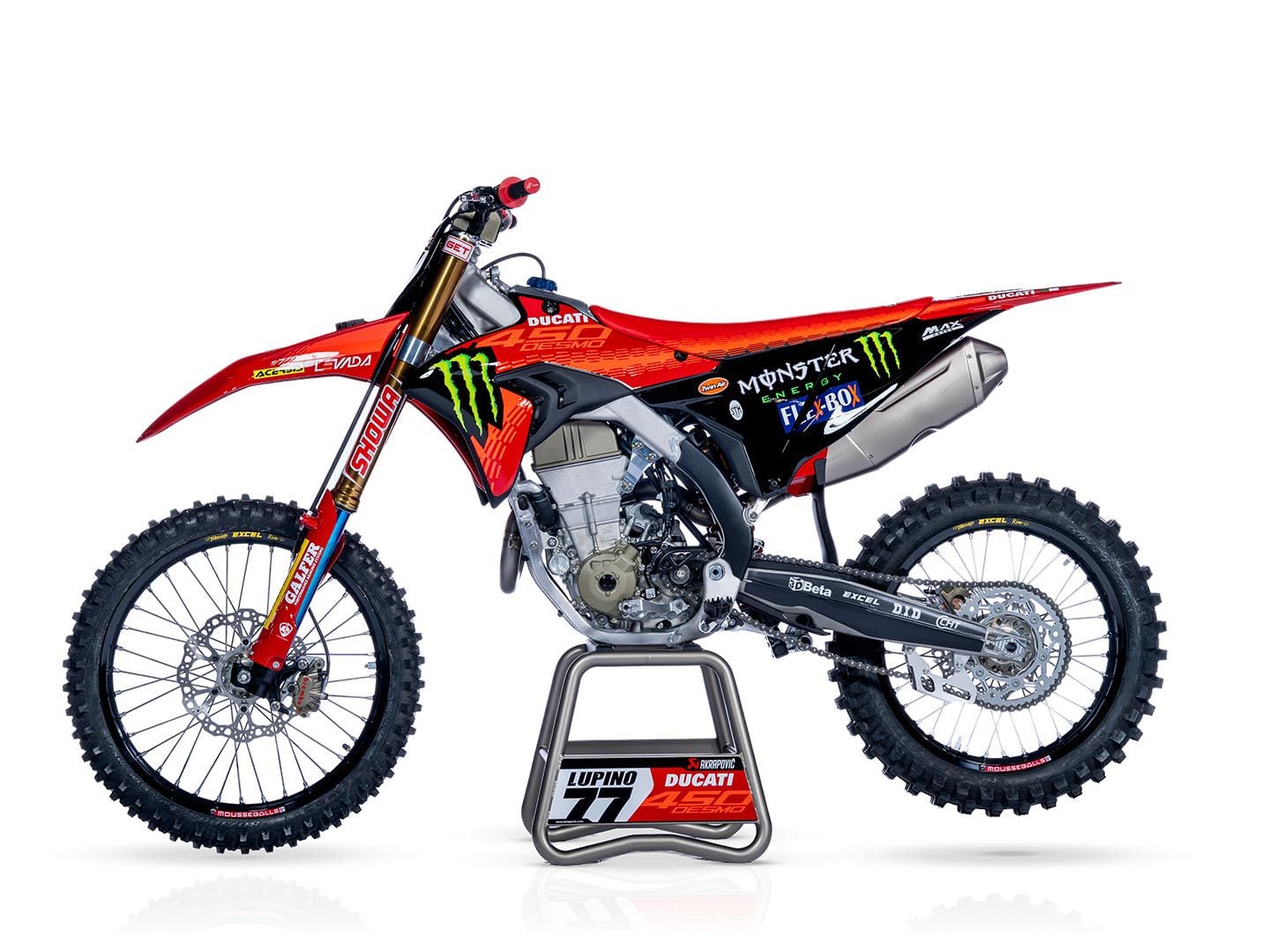
While it is still considered a prototype, the Desmo450 MX looks production-ready. (Ducati/)Nine-time world champion Tony Cairoli joined Ducati in autumn 2023 when the project was already in motion. “We started from scratch, but of course Tony’s huge experience for us is very important. We don’t expect him to know the diagram of the distribution of a KTM engine,” the technical director joked. “What we expect from him is his experience: his feeling on the bike and also direction of the development. We expect from him to find the limit of the current bike to develop it the right way. We are young in off-road so the riders’ experience and feedback is fundamental.”
The Riders’ Feedback
Antonio Cairoli doesn’t need a presentation, he is the Valentino Rossi of European motocross with nine world titles—he won six of them consecutively between 2009 and 2014. He retired from full-time professional motocross competition at the end of the 2021 season. He was named Red Bull KTM Factory Racing team manager in 2023, and has now decided to take his post-racing career in a different direction.
“After so many years spent with a brand and so many successes,” Cairoli said, “it was not an easy decision. But in the end I was convinced by this project. It’s a big change but I am a big fan of Italian manufacturers in motorsports so I convinced myself—an Italian racer and an Italian manufacturer.”
Tony won’t race this year, but he doesn’t hide that he might be back on track: “I miss racing.” The Ducati off-road project gives him the opportunity to be a protagonist of the project development. “The bike feels really good. At the moment there is no plan for me to race. It’s been two years, I am not racing at the highest level. It will come. My goal is to develop the bike—but it is fun to ride, so you never know.”
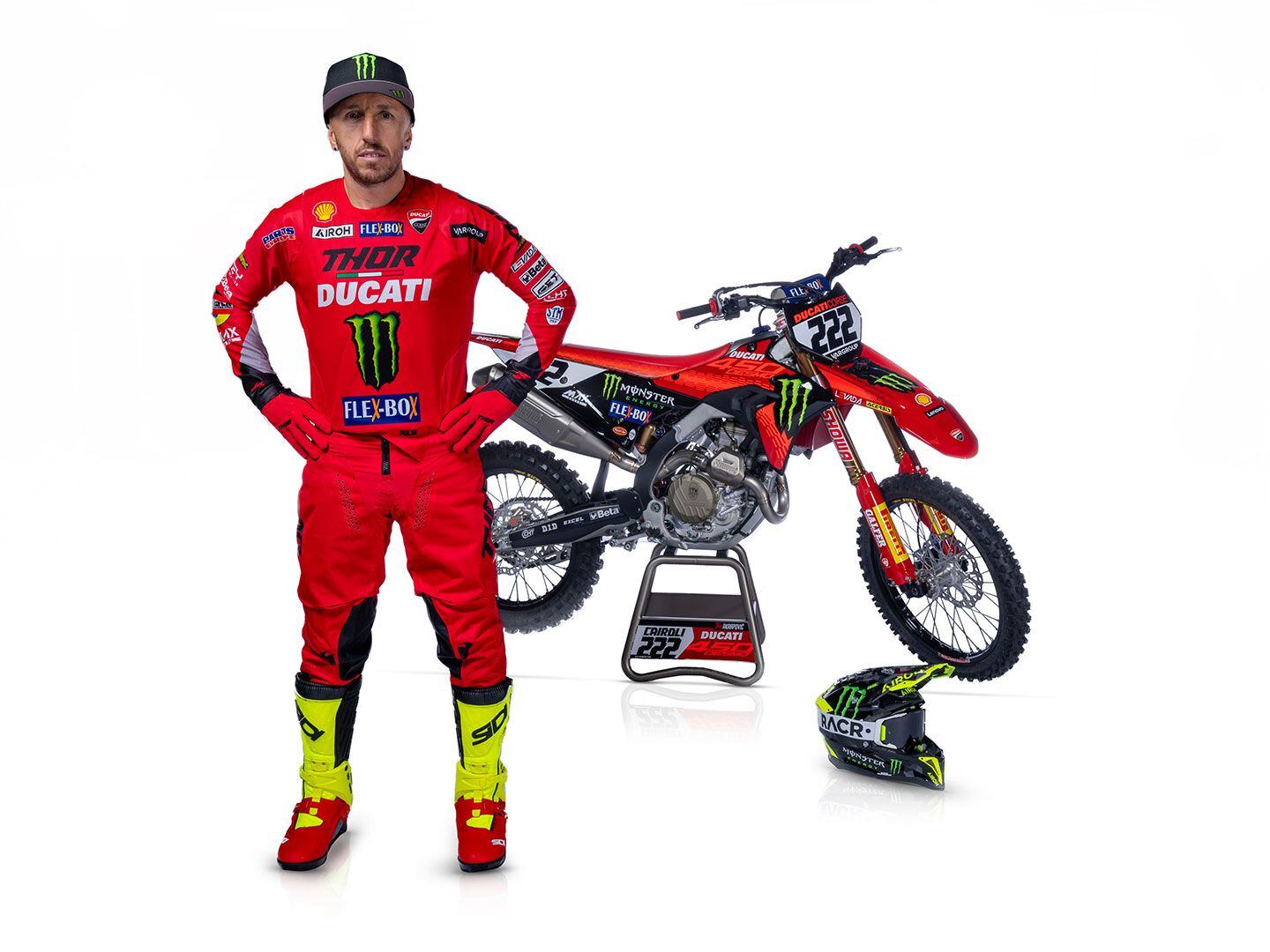
A nine-time MX champ, Cairoli is taking on a new challenge with Ducati Corse and the Desmo450 MX. (Ducati/)Alessandro Lupino was born in Viterbo in central Italy on January 15, 1991. In his long sporting career he became Italian champion eight times in addition to winning the European and World titles in the 85cc class in 2006.
In 2014 he joined the Fiamme Oro sports group of the state police, and in 2021, together with Cairoli and Mattia Guadagnini, he won the Motocross of Nations, bringing Team Italy the world title.
December 2023, he began his collaboration with Ducati Corse on development of the new Desmo450 MX model, and in 2024 he will take part in all rounds of the Italian Motocross Pro Prestige MX1 Championship with the Ducati Corse R&D.
“Ducati’s professional way to work is amazing,” Lupino said. “I have been impressed by the bike. I didn’t expect a prototype to be so good. The engine is good—fun to ride, we can go much faster than what we are doing now. The feeling is to have everything under control. The bike is easy to ride and comfortable, and the engine feels unlimited. The first impression was that the bike was born ready to race.”
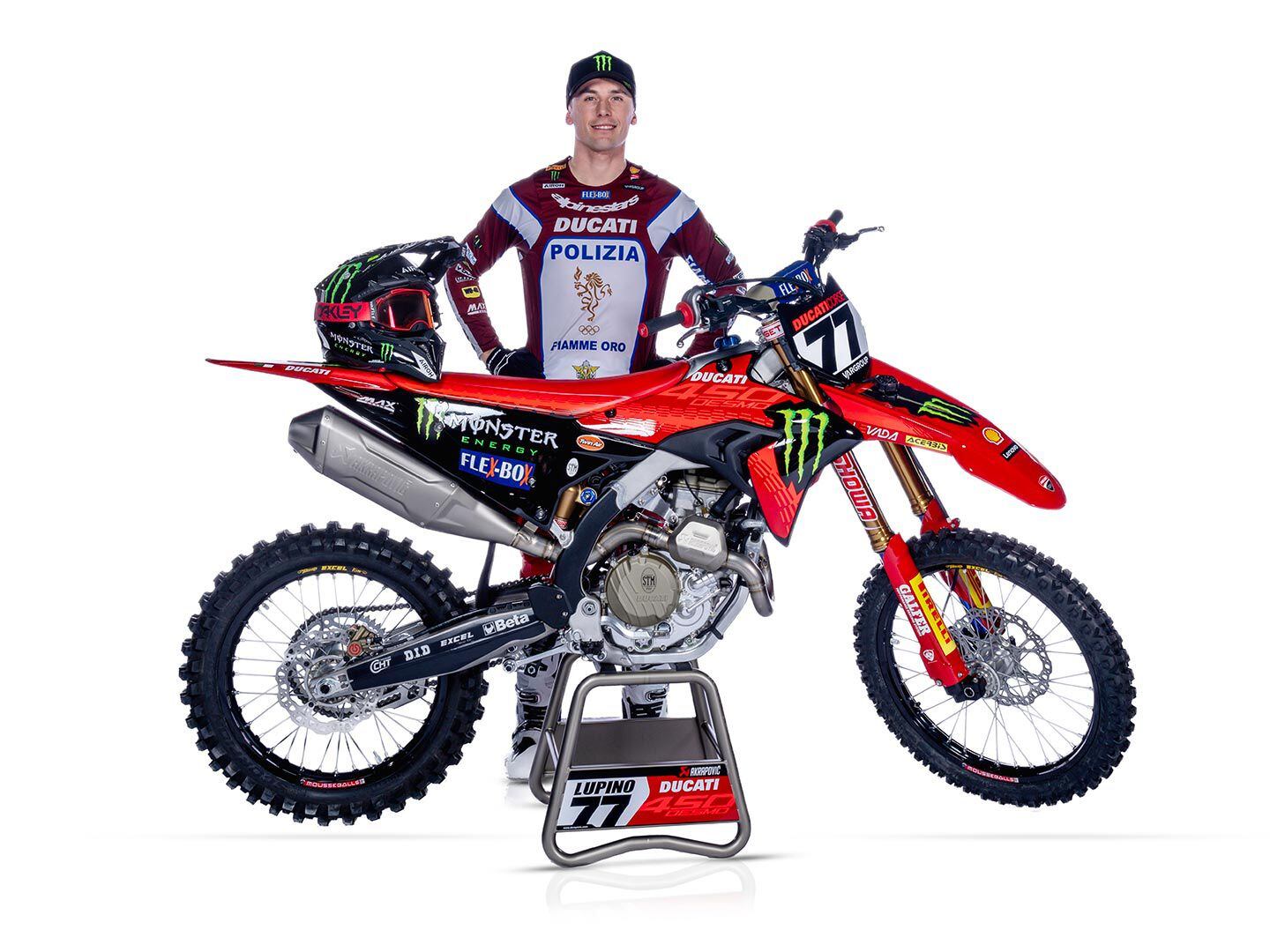
Lupino will be on the start line with the Desmo450 MX March 16 for the Italian Motocross Pro Prestige MX1 Championship. (Ducati/)The Racing Program
The Ducati Desmo450 MX will take part this year in the Italian Motocross Pro Prestige MX1 Championship, which will start on March 16 and 17 in Mantua with Lupino as the rider. The main goal for 2024 will be to further develop the new model through racing activity, with the support of the nine-time world champion.
The target is to join the MXGP Championship in 2025. The bike will be on sale in the second half of 2025.
Ducati cannot make missteps considering the credibility of the brand, so once the bike is proven to be competitive as it seems already, then the next steps will be to enter Supercross—the US market is just as important as Europe. And then maybe we will see Ducati in the Dakar Rally.
-
Suspension and rear subframe adjustments are now a part of the package.
-
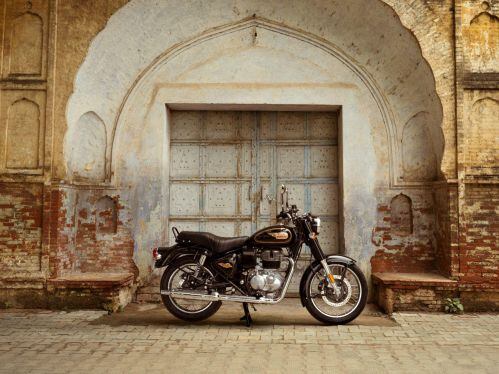
Royal Enfield Introduces The Legendary Bullet 350 (Royal Enfield/) Royal Enfield Press Release:
Royal Enfield announced today an exclusive addition to its North American product line – the 2024 Bullet 350. The only motorcycle in continuous production for over 92 years, a very limited run of just 100 units will be available for preorder exclusively in Canada beginning January 31, 2024 at 1:00pm ET, giving Royal Enfield motorcycle enthusiasts the chance to own their own piece of motorcycle history.
A Royal Enfield icon since 1932, the Bullet 350 has long been a cornerstone of Royal Enfield’s 123-year history as one of the company’s earliest and most popular bikes. While it will retain all the nostalgic design elements of the original Bullet, including the iconic thump of the 349cc engine, numerous upgrades have been made to optimize performance and improve rider experience to make it ideal for all riders who crave the legacy, from the daily commuter to the road trip adventurer.
“The Bullet 350 is the longest-running motorcycle model in continuous production anywhere in the world, so it was important to us to ensure this renowned motorcycle makes the transition into yet another century of impassioned riders,” says Yadvinder Singh Guleria, Chief Commercial Officer for Royal Enfield. “By pairing all of the style and nostalgia of the original Bullet with updated performance elements, from city rides to scenic journeys, the 2024 Bullet goes the distance.”
The 2024 Bullet is powered by the same 349cc fuel-injected, air/oil-cooled, single-cylinder engine platform found in the newest versions of Royal Enfield’s Meteor, Classic and Hunter models. With low-end grunt and smooth power delivery, the engine is capable of taking riders on soul-stirring journeys without losing any of the personality Royal Enfield loyalists have come to love. A primary balancer shaft cuts down on vibrations, while an optimized 5-speed gearbox ensures gear shifting is smooth and crisp.
“The Bullet is a motorcycle that has resonated with the general public for decades, so our goal was to create a bike that retained all of the character of the original Bullet while still meeting the needs of today’s riders and enthusiasts,” said Royal Enfield Chief of Design, Mark Wells.
Released in two distinct variants to appeal to a variety of riders, and especially those with an affinity for the brand, the Bullet 350 will also be available in three stylish colorways. The Bullet Standard – available in Standard Black or Standard Maroon – is finished with hand-pinstriped tanks embellished with chrome and gold badges, and will retail at CA$5,899. The second variant, the Bullet Black Gold, is embellished with copper pinstriping and blacked-out engine and components, and will retail at CA$6,199. Both variants come equipped with dual-channel ABS and rear disc brakes.
The 2024 Royal Enfield Bullet 350 will be displayed at the Toronto Motorcycle Show, Booth #1137 from February 16-18, 2024. Also in attendance will be Gordan May, Royal Enfield’s resident brand historian, who will be presenting on the history of the Royal Enfield Bullet. May will also be available for media interviews upon request.
The limited run of the 2024 Bullet 350 will be available to the Canadian market for online pre-order starting January 31, 2024 at 1:00pm ET. Learn more about the 2024 Royal Enfield Bullet 350 and pre-order at royalenfield.com/ca/en/bullet-350.
-
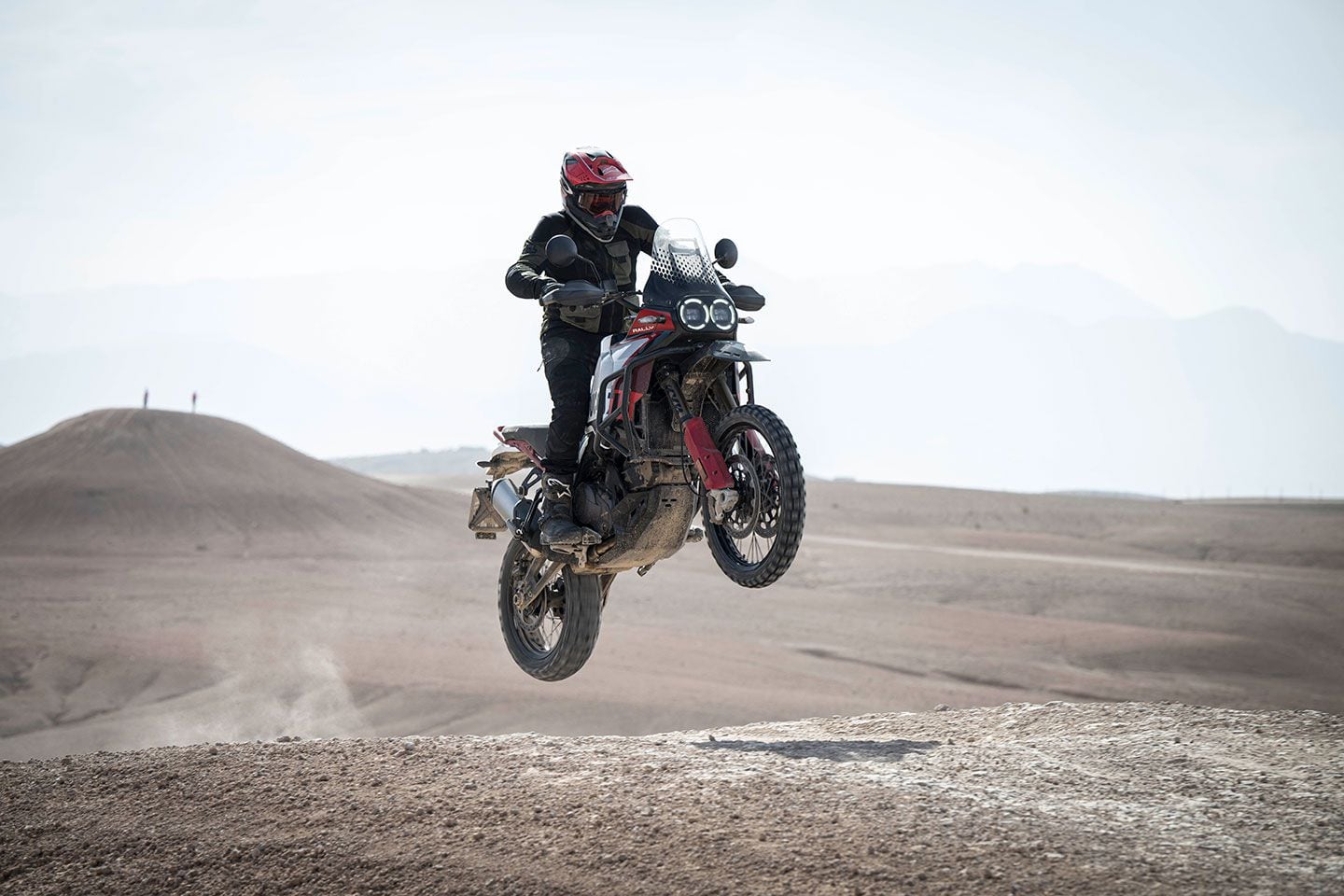
Ducati’s DesertX Rally is fitted with larger, longer-travel suspension. (Ducati/)Not one to stand still for a second longer than absolutely necessary, Ducati has upped the adventure bike ante once again with the DesertX Rally, a high-spec and genuinely race-capable development of the excellent DesertX.
The Rally is truly a DesertX on steroids, a road-legal ready-to-race bike with beefed-up, long-travel KYB suspension and little in terms of componentry and intent to separate it from the machine that won the twin-cylinder class of the recent Iron Road Prologue at the Erzbergrodeo. Its styling cues shift somewhat from desert raider to enduro—note the high-mount front fender—while paintless “mass-colored” plastics and a forged carbon skid plate signal a tougher, more durable machine that is expected to take a few hits.
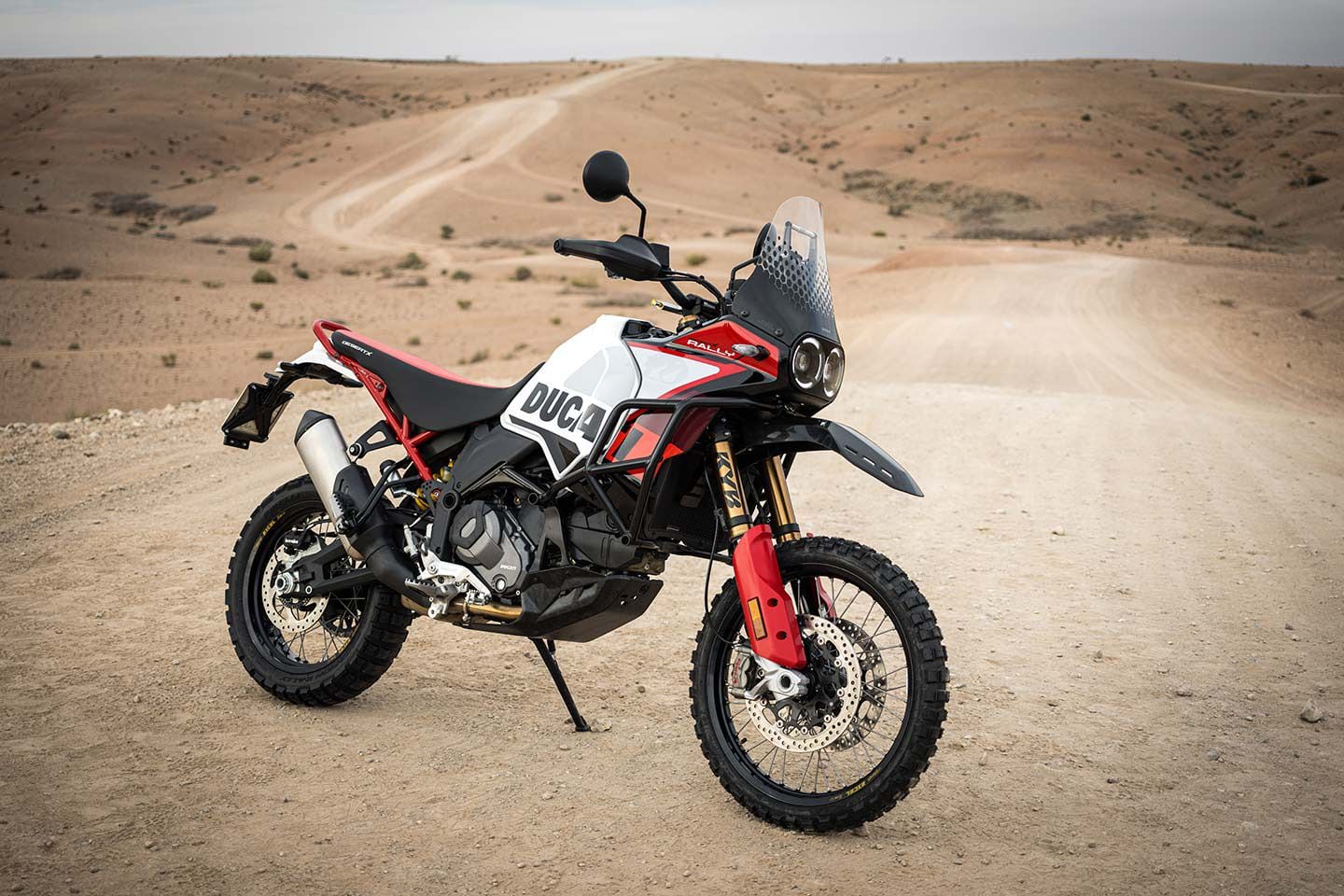
Two days in Morocco proved the mettle of Ducati's DesertX Rally. (Ducati/)Like the base DesertX, the Rally is powered by the eminently versatile 937cc Testastretta 11° L-twin, which produces a claimed 110 hp at 9,250 rpm and 68 lb.-ft. at 6,500 rpm. Ducati’s DQS quickshifter is standard, and service intervals are every two years or every 15,000 kilometers (9,321 miles), with valve clearance checks at 30,000 kilometers (18,641 miles). On the electronics front, there are six riding modes stemming from four power modes, three levels of engine-braking, eight traction control settings, three levels of cornering ABS, and switchable wheelie control. So plenty to play with.
I’d not ridden a DesertX for six months, but on our two-day test in the wilds of Morocco, the new Rally felt instantly familiar, with easy-to-understand switch gear and those myriad modes and rider aids at my fingertips. In the congested streets of Marrakech, I selected Urban mode, then opted for Sport mode on the asphalt road out of town, and when we hit the dusty trails, Enduro followed by the full-power Rally mode as the pace got hotter. All done, thank you very much, in a moment and on the move with eyes still on the view ahead.
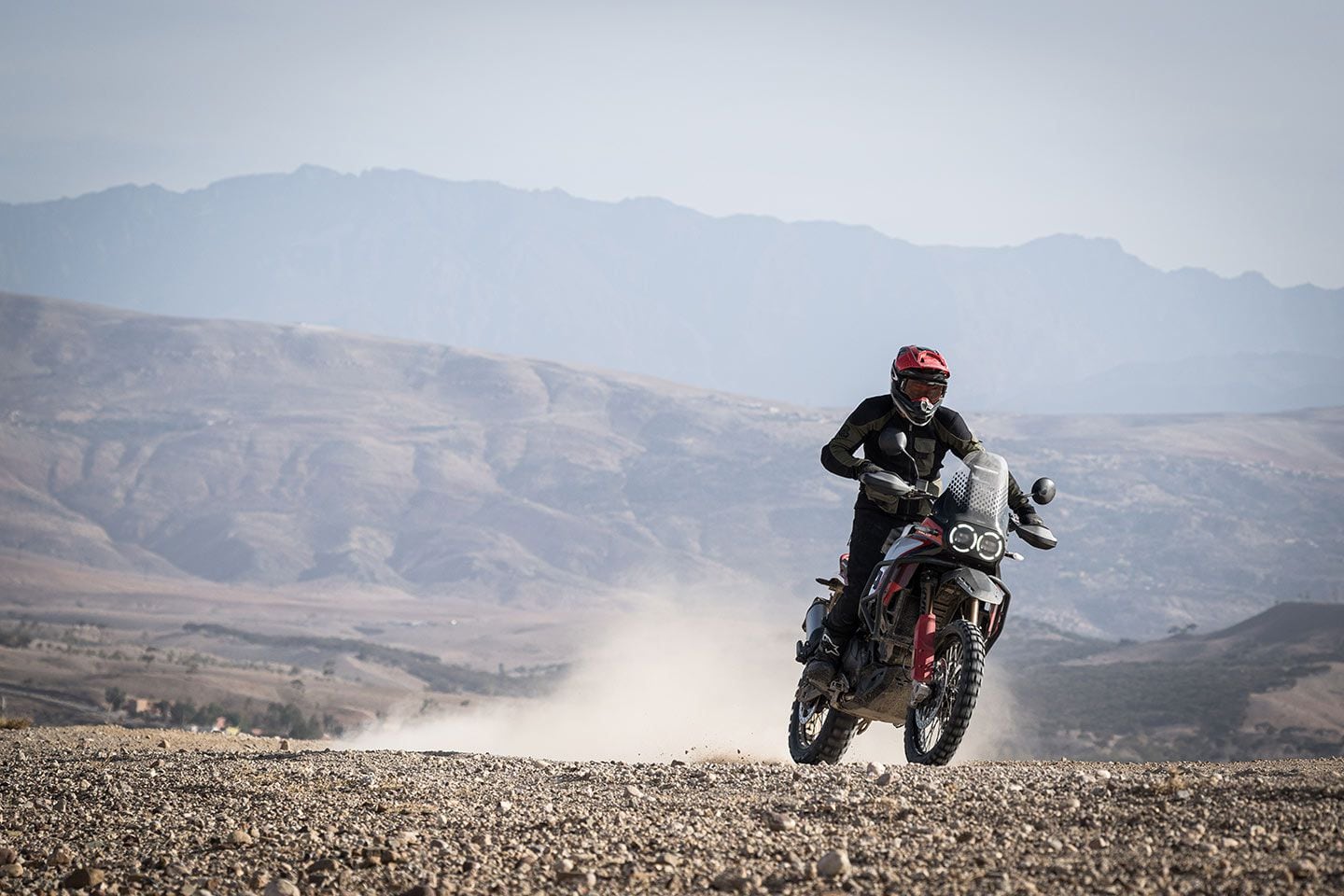
Changing modes is easy and quick, allowing the rider to stay focused on what’s ahead rather than what is on the dash. (Ducati/)As the conditions change, the Rally pilot can simply switch between the modes by quickly closing the throttle and selecting a mode, tuning the bike’s characteristics to the terrain and the moment. It’s fast and intuitive, and the dash communicates the changes clearly. The six riding modes are Sport (full power), Touring (95 hp with a softer delivery), and Urban (75 hp). Wet mode ups the intervention levels of the electronic aids, while the two off-road modes deliver 75 bhp and a rapid throttle response (Enduro) and full power with minimal intervention from the ABS and traction control, and none at all from the deactivated wheelie control (Rally).
The system is so polished and easy it’s like having an extra control input. On the dirt, input Rally mode for effortless stand-up wheelies and then, for a tricky sandy section, pop it back into Enduro for less power and more support from the traction control and other rider aids.
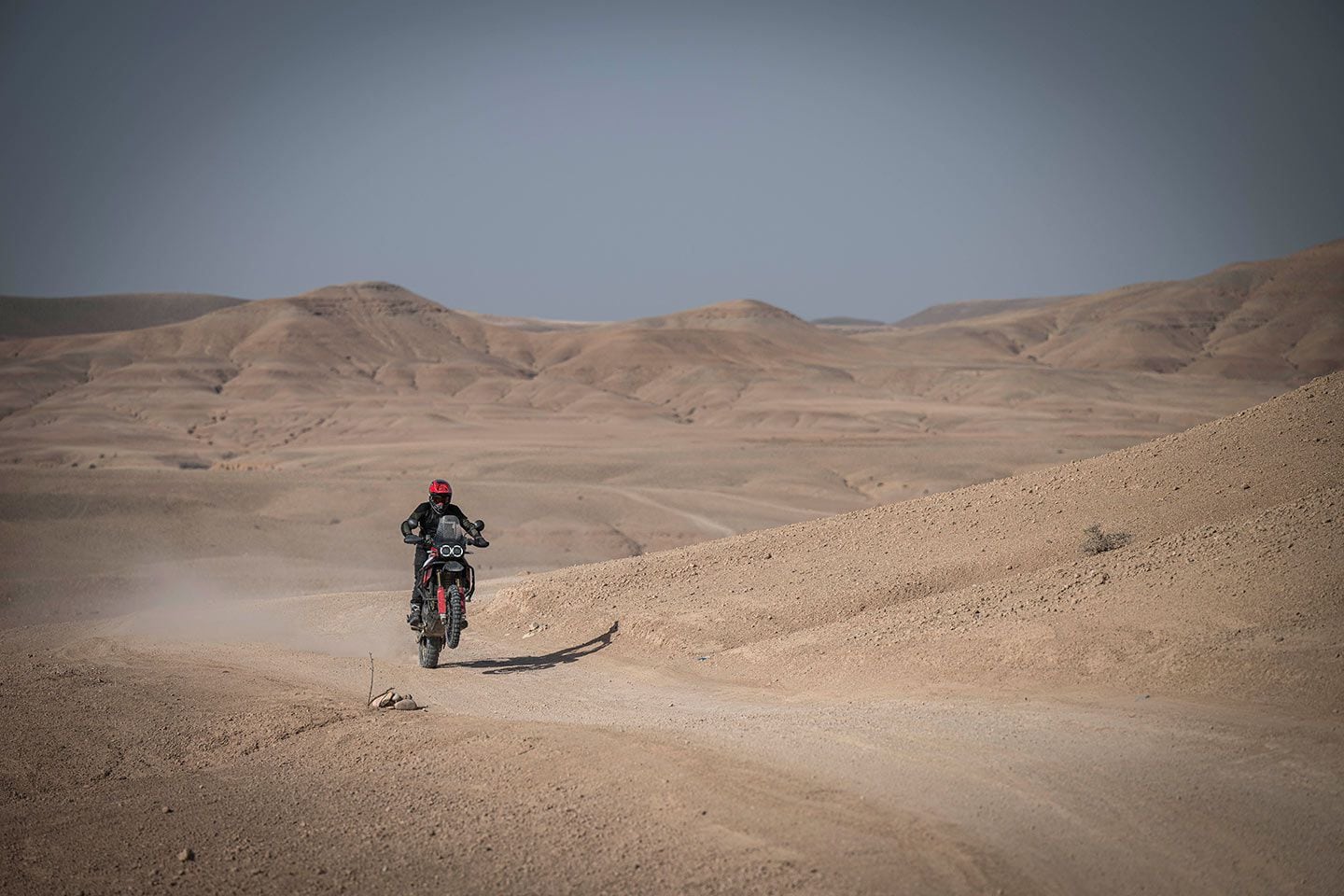
Rally mode allows for wheelies. (Ducati/)Everything in the drivetrain, from throttle to gearbox is also on point. A lovely spread of torque blends with the slickest of up-and-down quickshifters, delivering a perfectly metered drive. It’s smooth and willing one minute, and able to land a serious punch the next. Grab a handful of throttle in second gear with DWC removed and the front wheel will climb skyward.
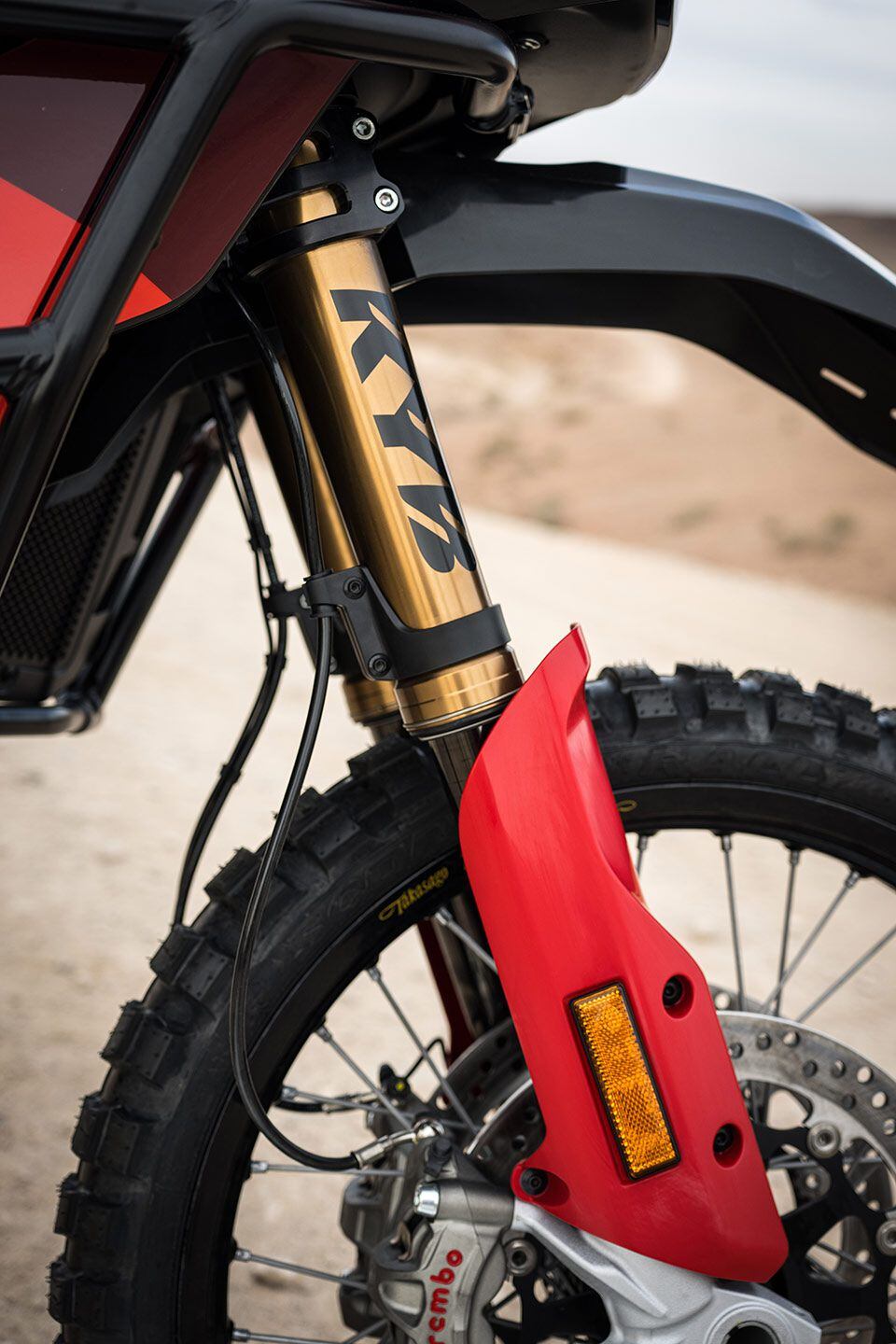
A larger-diameter 48mm KYB fork has 0.7 inch longer travel. (Ducati/)But the real story of the Rally is not its engine but its chassis, because the quality of KYB suspension units is simply outstanding. Up front a closed-cartridge 48mm fork has 9.8 inches (250mm) of travel (compared to the DesertX’s 46mm fork with 9.1 inches of travel) and marginally lighter springs. The triple clamps are billet aluminum and give 1mm more offset. At the rear, a fully adjustable KYB shock also gets a remote spring preload adjuster. Stroke goes up from 8.7 inches (230mm) on the standard X to 9.5 inches (240mm), while ground clearance increases by 1.2 inches to a total of 11. Seat height goes up 1.3 inches to a vertiginous 35.8 inches, making it the highest perch on any current production bike.
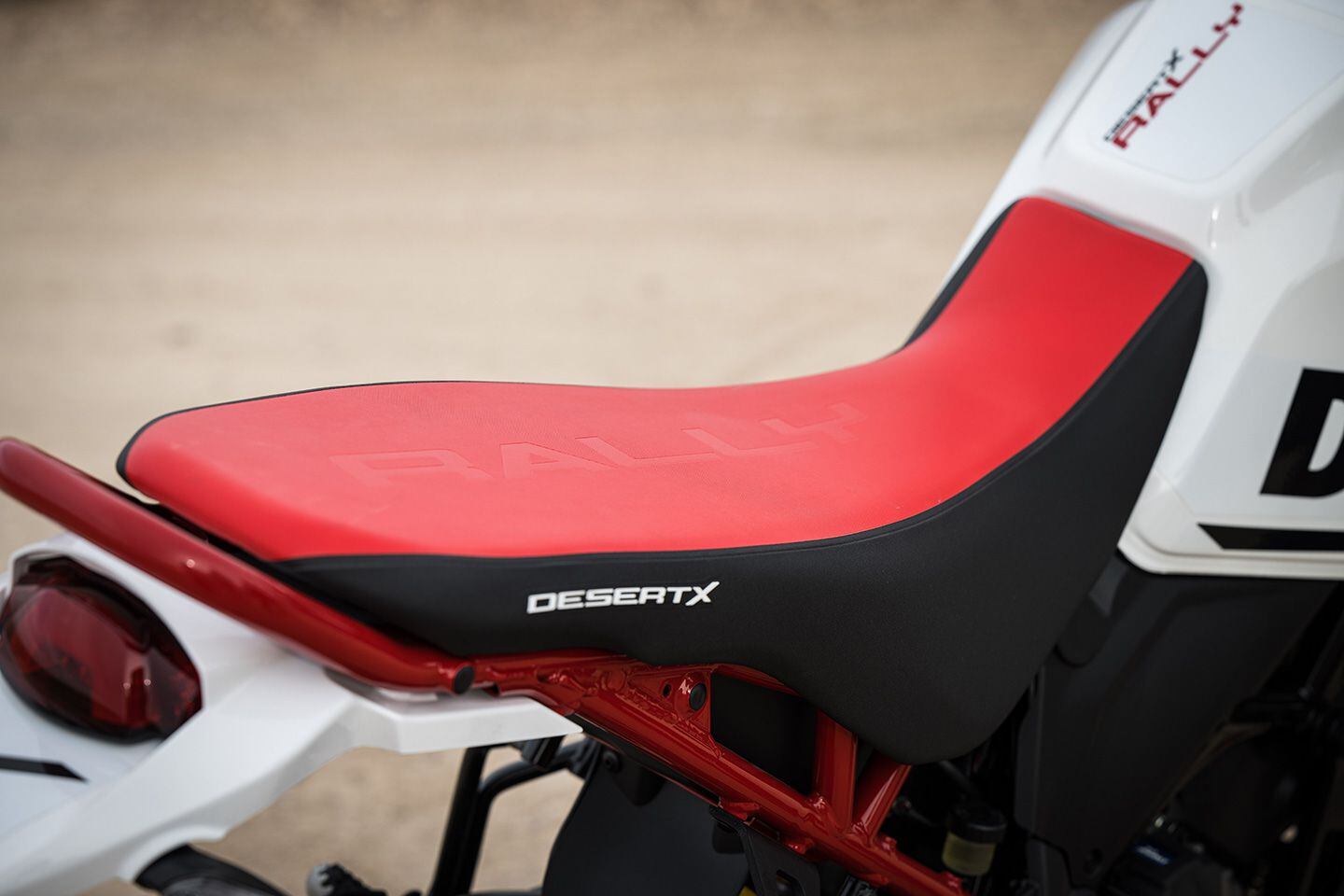
Seat height is tall, but the seat itself is narrow enough to allow shorter riders to get at least one foot down. (Ducati/)This lofty statistic may put some shorter riders off the Rally. But if you want a bike to work like a racer off-road, these are the dimensions you have to work with. Furthermore, I’m under 5 feet, 7 inches and the altitude of the seat isn’t as intimidating as I expected, mainly because both seat and bike are narrow, which mean I can get one foot securely down while just about reaching the back brake or gear selector with the other, though I did find it difficult to flick up the sidestand while onboard—even taller riders struggled.
On paper it’s also a reasonably heavy bike with a 465-pound wet weight (no fuel) but doesn’t feel it, even when fully fueled. What it does feel like, though, is sensational. Simply, the Rally is one of the best adventure bikes ever ridden off-road.
Some 90 percent of our ride was on dirt ranging from fast open dunes and desert to slow and rocky sections, and the KYB suspension was faultless throughout. It is so controlled it behaves as if on a paved road rather than churning dirt. Like the proverbial swan that’s so graceful on the surface but working frantically underwater, the KYB units take everything you can throw at them and more.
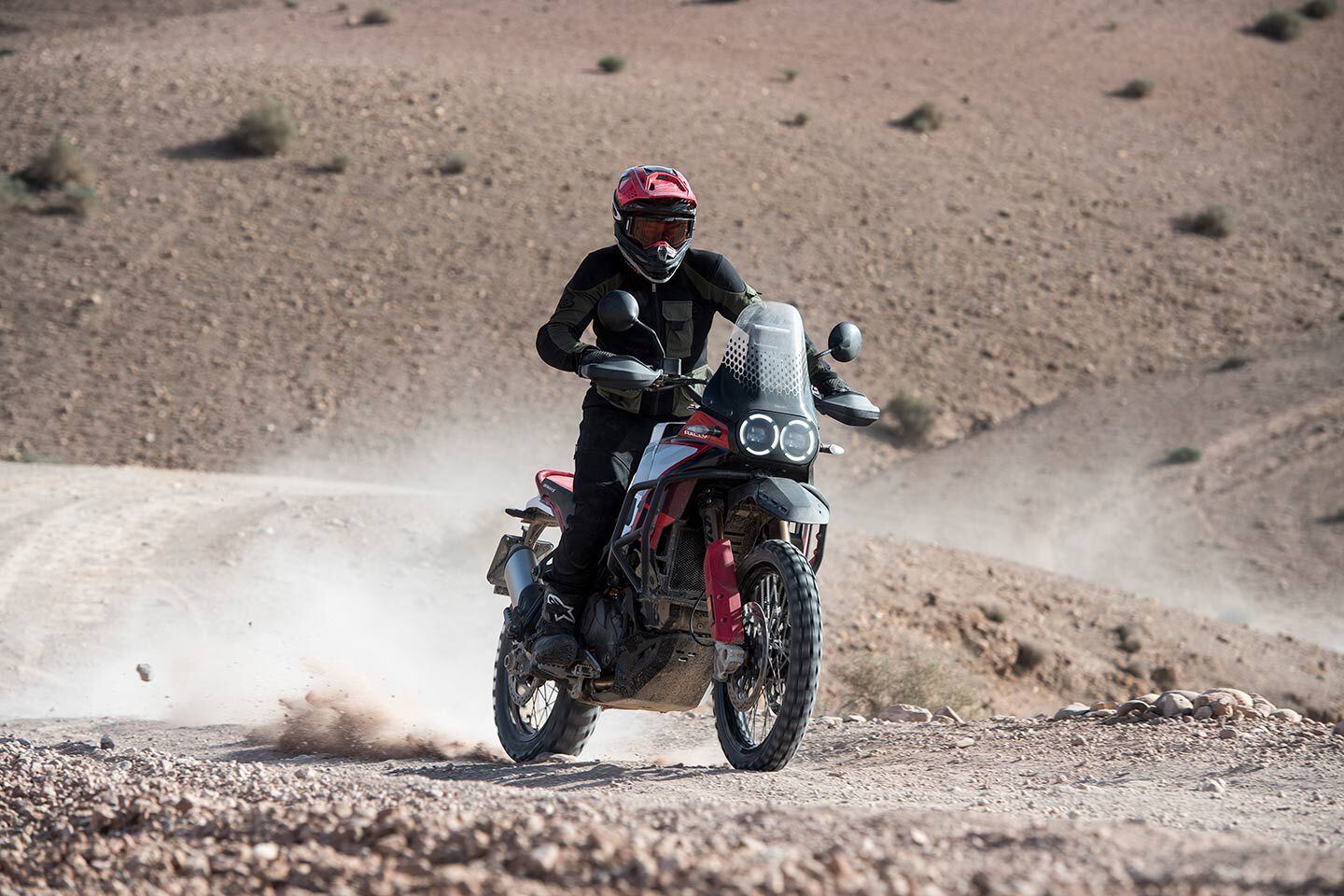
The DesertX Rally’s KYB fork and shock have excellent ground-following ability in the dirt. (Ducati/)Deliberately provoking the Rally by slamming the throttle shut over humps to agitate the rebound, hitting rocks while on the brakes, and even deliberately landing badly off jumps—the bike soaked it all up. The Rally makes fast, fun dirt riding effortless. It gives you time to scan ahead while feeding back everything needed to know about grip levels. It then responds to inputs smoothly, driving impeccably through power-sapping sand. It makes the rider look, feel, and ride so much better. At 80 mph on a loose surface that would normally be a tense affair on an ADV, you can enjoy the ride.
The 21-inch front and 18-inch rear wheels feature hubs machined from solid aluminum, carbon steel spokes, and Excel rims, with the rear rim half an inch narrower to optimize off-road grip. Tubed Pirelli Scorpion Rally STR tires are standard while Brembo M50 Monoblock calipers and 320mm discs do the work up front and are supported by a Brembo twin-piston caliper and 265mm disc at the rear, with cornering ABS controlled by a Bosch IMU.
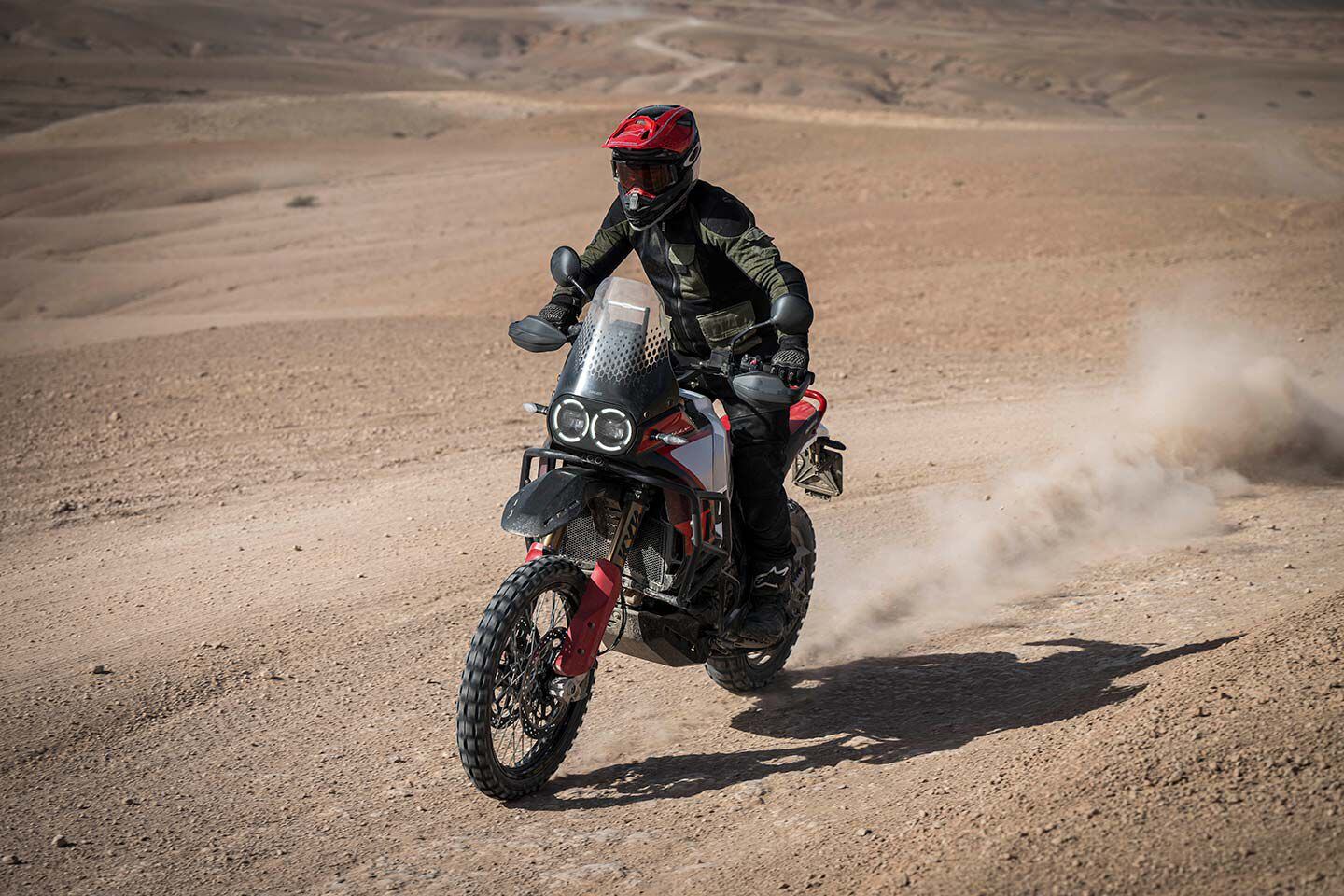
Pirelli’s Scorpion Rally STR tires hook up well in the dirt. (Ducati/)Comfort remains largely untested as standing up on the new pegs for the majority of the ride was required, spending little time on the new seat. The new pegs are worth a mention, though, as they are wide, solid, and very grippy even in the wet. The gear shifter and brake pedal are both machined from solid alloy and adjustable to suit off-road or on-road use. With the rear brake pedal flipped over into its off-road position it allows you to use the back brake with rare finesse, even in off-road boots.
The DesertX Rally is priced at just under $23,000—$5,000 above the standard DesertX ($17,995). It is however equipped with high-end components, so while the asking price is high, it’s easy to see where the money has been spent. The portrait-oriented 5-inch dash is, for example, pure class and has both connectivity and two display modes: standard and rally, both of which are clear and easy to read. A utility bar for extra mountings like a GPS unit sits above the clocks and is a nice touch.
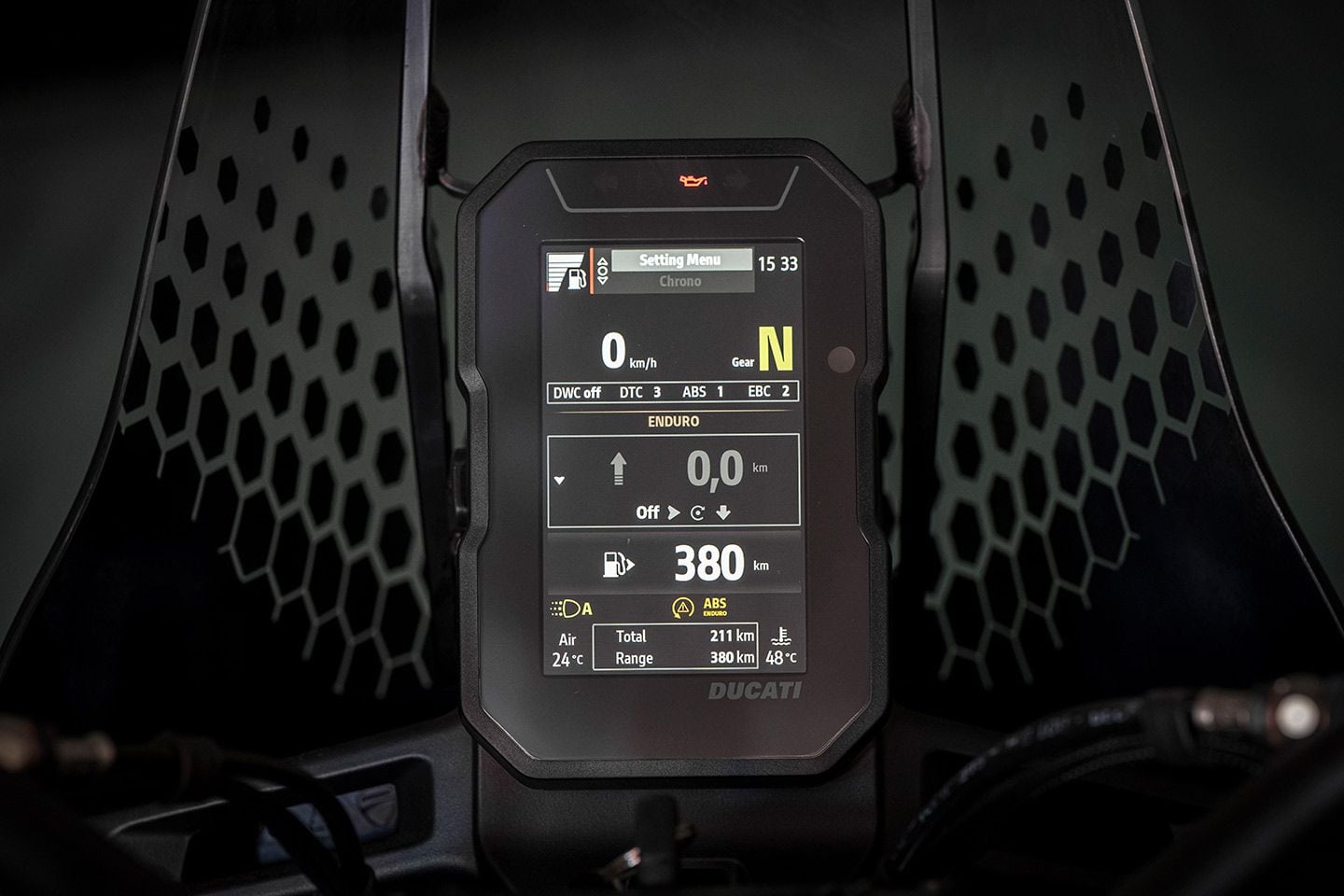
The vertically arranged dash on the DesertX Rally is excellent. (Ducati/)Our testbike was (wisely) fitted with full external steel engine covers and the radiator guard from Ducati’s accessory catalog. Importantly for those who plan to ride their Rallys as intended, a couple of days in the desert, with dust and rocks being thrown in all directions, left Cycle World’s test machine still looking like new, with no obvious sign of wear from enduro boots covered in grit rubbing against the bodywork. Even the carbon fiber sump guard appeared unblemished.
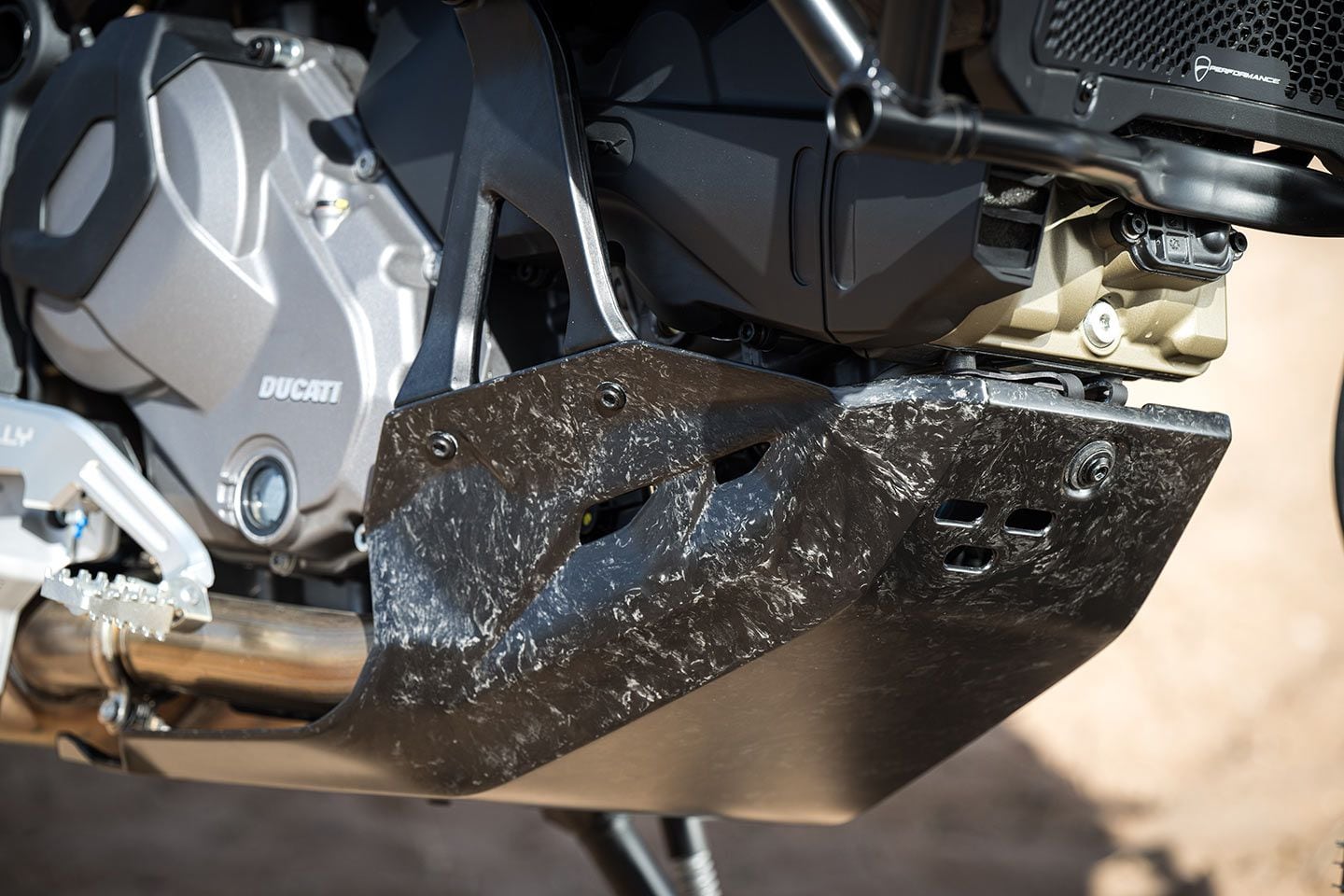
A carbon fiber skid plate is standard equipment on the DesertX Rally. (Ducati/)Of course, our desert-based test leaves us in the dark about the Rally’s abilities on asphalt, but I can already and confidently state it is arguably one of the best road-legal “big” adventure bikes ever ridden off-road—the suspension, perhaps, the finest experienced on non-road terrain.
But this isn’t a radical adventure bike aimed at an extreme audience; the rider aids and modes, along with the friendly power delivery, make it versatile and usable to a wide range of riders. Yes, the seat will be too tall for some and $22,995 is a lot of money, but those are two forgivable flaws. Rarely have we ridden an adventure bike on dirt with so much confidence. And that’s priceless.
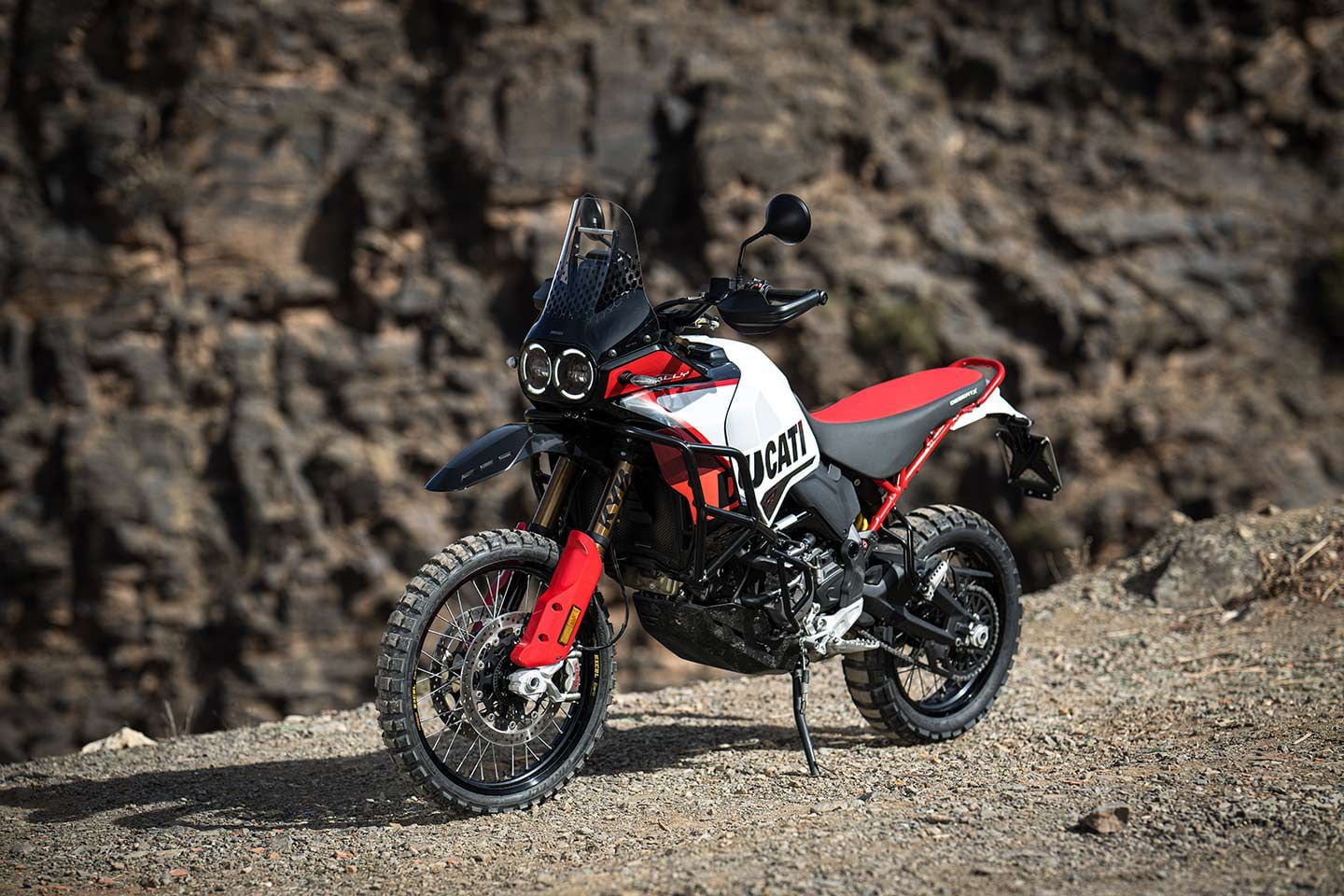
Ducati’s DesertX Rally is built to take the abuse of serious off-road riding. (Ducati/)2024 Ducati DesertX Rally Specs
MSRP: $22,995 Engine: Testastretta 11° desmodromic, liquid-cooled V-twin; 4 valves/cyl. Displacement: 937cc Bore x Stroke: 94.0 x 67.5mm Compression Ratio: 13.3:1 Transmission/Final Drive: 6-speed/chain Claimed Horsepower: 110 hp @ 9,250 rpm Claimed Torque: 68 lb.-ft. @ 6,500 rpm Fuel System: Bosch electronic fuel injection w/ 53mm throttle bodies, ride-by-wire Clutch: Wet, multiplate slipper and self-servo; hydraulic actuation Frame: Tubular steel trellis Front Suspension: KYB 48mm upside-down fork, fully adjustable; 9.8 in. travel Rear Suspension: KYB monoshock, fully adjustable; 9.4 in. travel Front Brake: Radial-mount Brembo Monoblock 4-piston caliper, dual 320mm semi-floating discs w/ Bosch Cornering ABS Rear Brake: Brembo floating 2-piston caliper, 265mm disc w/ Bosch Cornering ABS Wheels, Front/Rear: Spoked; 21 x 2.15 in. / 18 x 4.0 in. Tires, Front/Rear: Pirelli Scorpion Rally STR; 90/90-21 / 150/70R-18 Rake/Trail: 27.6°/4.8 in. Wheelbase: 64.0 in. Ground Clearance: 11.0 in. Seat Height: 35.8 in. Fuel Capacity: 5.5 gal. Claimed Wet Weight: 465 lb. (no fuel) Contact: ducati.com -
Retro-inspired colors and off-road-ready goodies elevate the bike’s appeal to ADV enthusiasts.
-
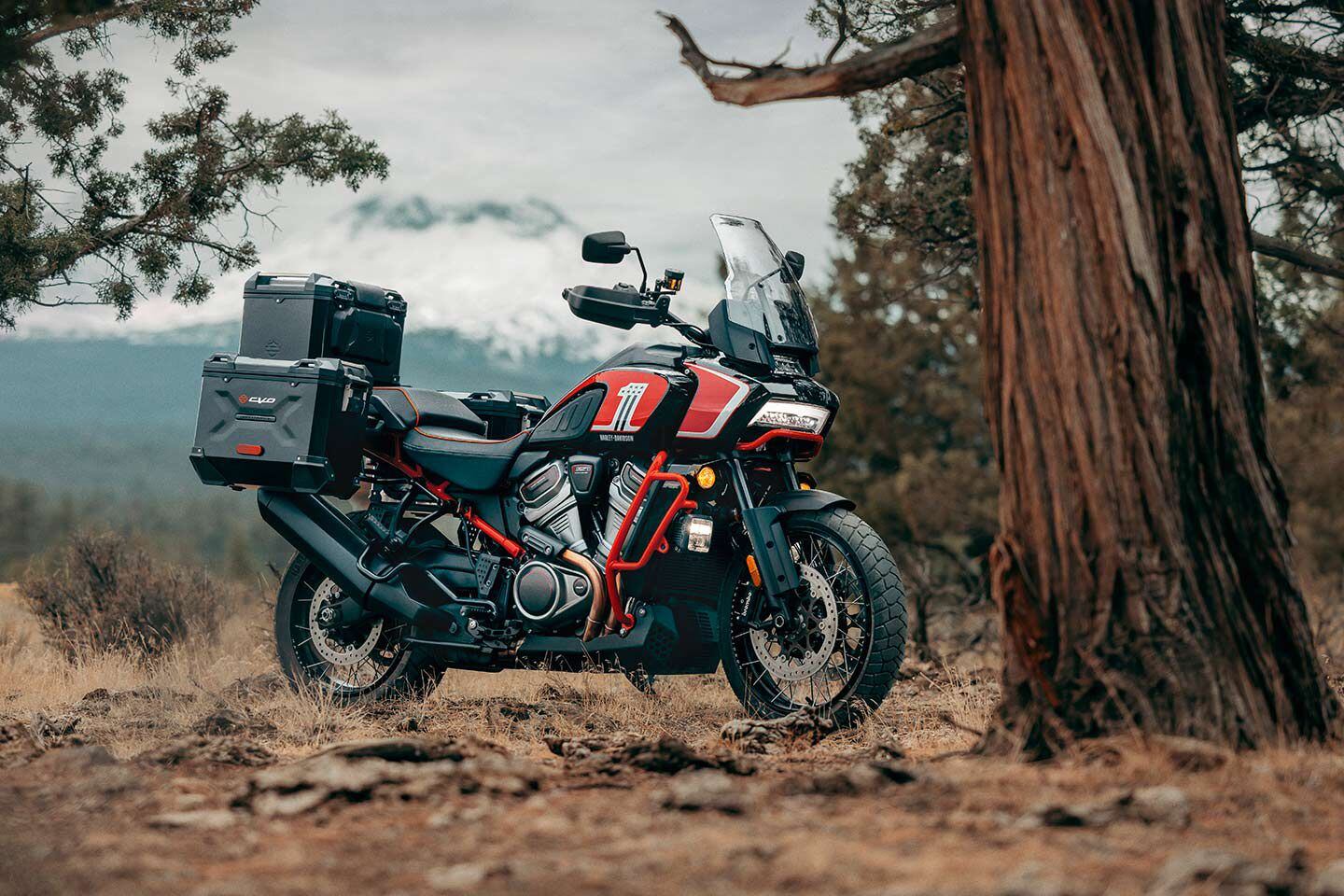
The 2024 Harley-Davidson CVO Pan America. (Harley-Davidson/)For 2024, Harley-Davidson is introducing the CVO Pan America, a fully optioned, fully loaded version of its big-bore adventure-tourer, complete with flashy custom paint that screams, “This may be an adventure bike, but it’s definitely still a Harley-Davidson”—just in case you needed reminding.
The CVO Pan America uses the Revolution Max 1250 engine, semi-active suspension, a full complement of electronic rider aids, an adaptive headlight, and a touchscreen display. To that, the CVO department has added parts and accessories from the H-D catalog including adaptive ride-height suspension, a Screamin’ Eagle quickshifter, aluminum top and side cases, spoked wheels, an aluminum skid plate, and auxiliary lighting. Essentially, the CVO is a Pan America Special that comes kitted out with most of the big-ticket accessories needed to head off-road or on a long tour. It would have been nice to see the Screamin’ Eagle Street Cannon exhaust included though.
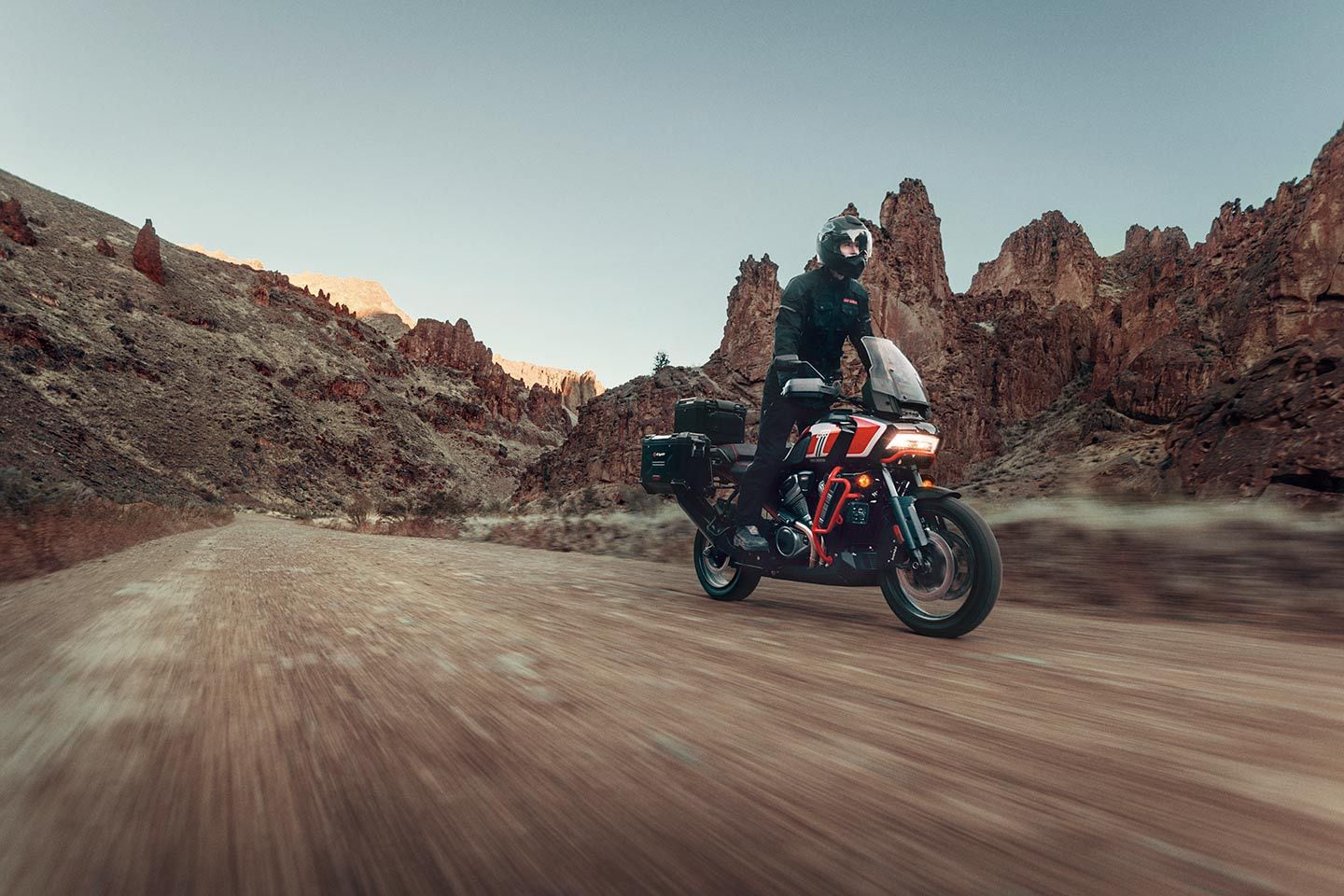
After thorough testing in 2021, <i>Cycle World</i> declared, “Its stellar 60-degree DOHC Revolution Max 1250 V-twin produces 128 hp and 81 pound-feet of torque while bolted into a chassis that’s comfortable and quick on the road and highly capable in the dirt. Innovative but rational, spectacular but user friendly; exactly what an adventure bike should be.” (Harley-Davidson/)When the first-year Pan America bested the competition to become the surprise winner of Cycle World’s Big-Bore Adventure Shootout, and earning a spot on Cycle World’s Ten Best list at year’s end, it was clear that H-D knocked it out of the park by striking the balance of street/touring/dirt performance while introducing new technologies, like its lauded adaptive ride-height suspension. Inclusion in the CVO portfolio is maybe Harley’s own commendation of a motorcycle that continues to surprise and win over riders.
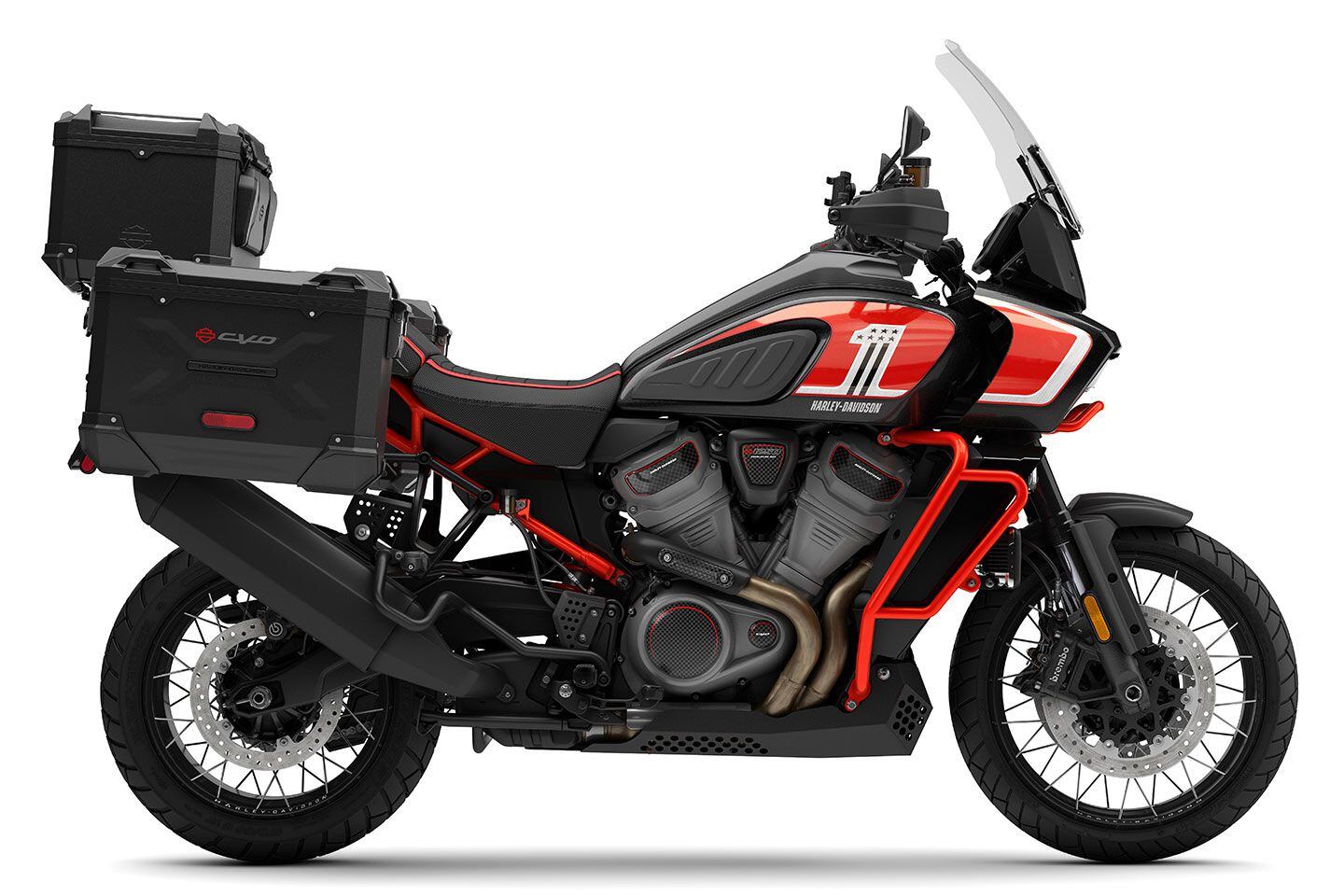
Color-matched crashbars, subframe, and stitching on the seat further the CVO look. There are those who think adventure bikes look their best with mud-splattered fenders and abraded crashbars. Not sure that would be the case with a CVO adventure bike. (Harley-Davidson/)The CVO Pan America joins the 2022 G.I. Enthusiast Motorcycle Collection as a limited-edition model, but distinguishes itself with a glut of ready-for-adventure parts. If exclusivity and super-glossy paint don’t feel too dirt averse to you, check out the CVO Pan America in authorized Harley-Davidson dealers beginning this month. MSRP is set at $28,399.
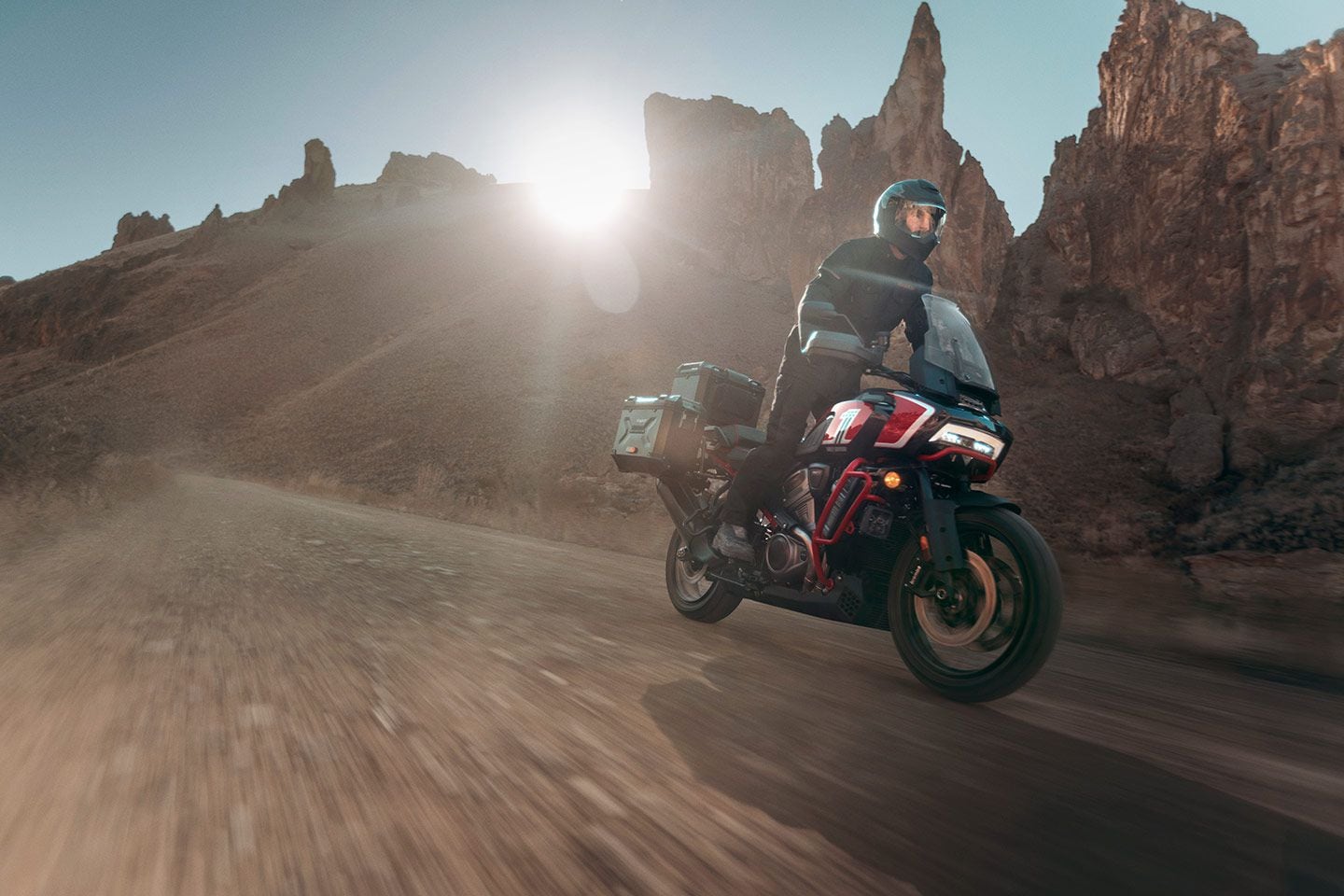
Is the CVO treatment enough to make you pull the trigger on Harley’s adventure bike? (Harley-Davidson/)-
 1
1
-
-
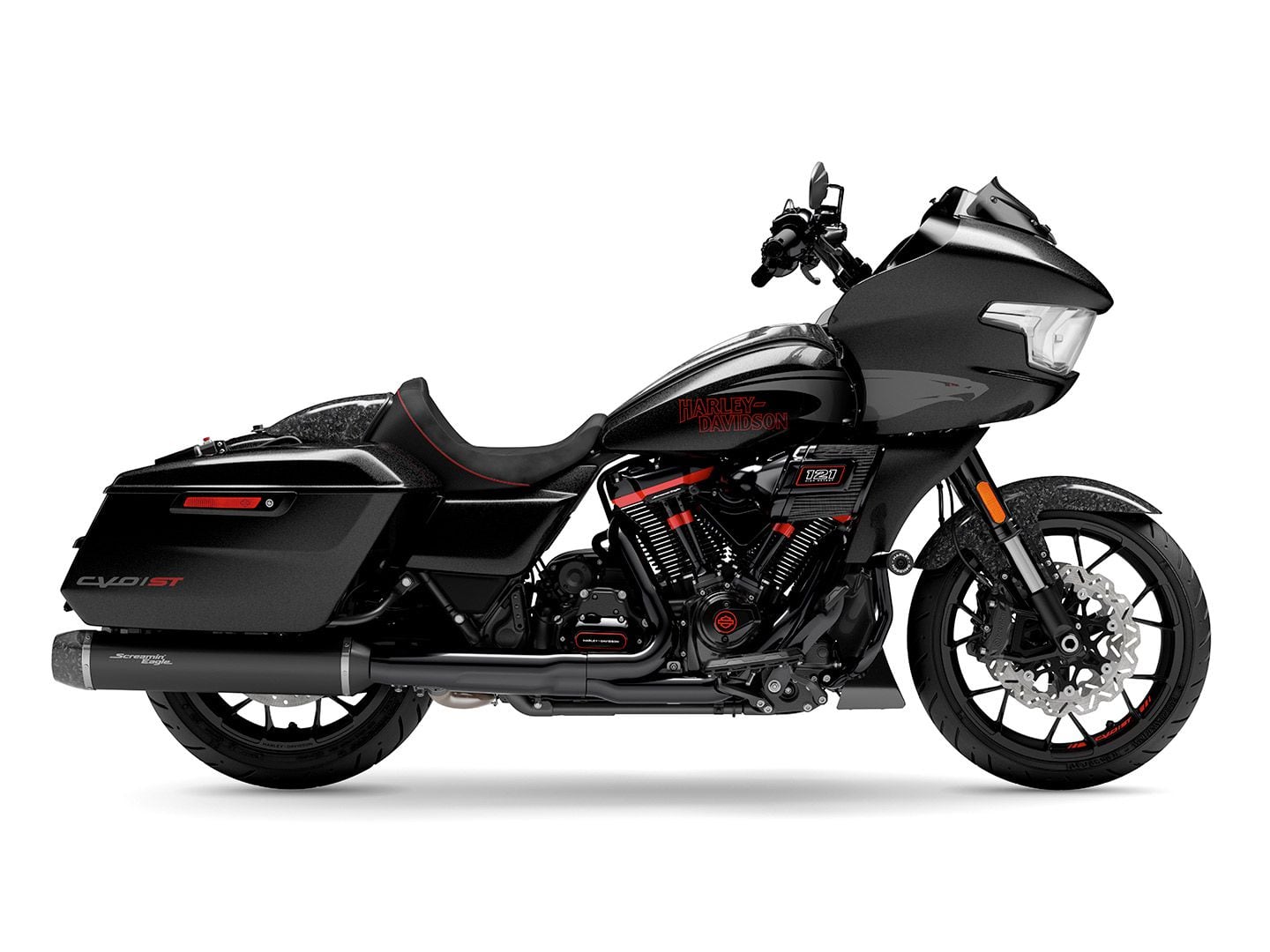
The Harley-Davidson CVO Road Glide ST’s Screamin' Eagle graphic on the fairing and tank is inspired by Harley-Davidson’s factory King of the Baggers racebike. (Harley-Davidson/)If the MotoAmerica King of the Baggers series made allowances for homologation specials—extra-trick, ultra-premium motorcycles made in small but sufficient numbers to be considered production motorcycles by sanctioning bodies—Harley-Davidson would have no choice but to produce one for purchase at your local dealership. However, the KOTB rules are written to encourage a degree of parity between factory and independent teams, and to instigate some big-time privateer in-house development, so H-D is off the hook. It’s not required to produce a homologation special to support its factory effort. Too bad for us.
But wait. Here’s the 2024 CVO Road Glide ST: your shot at owning a limited-number, tricked-out bagger like we’ve never seen. Homologation special? Not quite (not even close, really), but it’s still a special machine.
While the 2022 Road Glide ST and Street Glide ST models introduced us to the production performance bagger concept, the 2024 Road Glide ST sidles through the CVO department on its way to even greater performance potential. The new CVO Road Glide ST takes advantage not only of the ST designation, but of 2023′s CVO Road Glide overhaul, from which it borrowed a version of the Milwaukee-Eight 121 VVT engine, electronic rider aids, and styling.
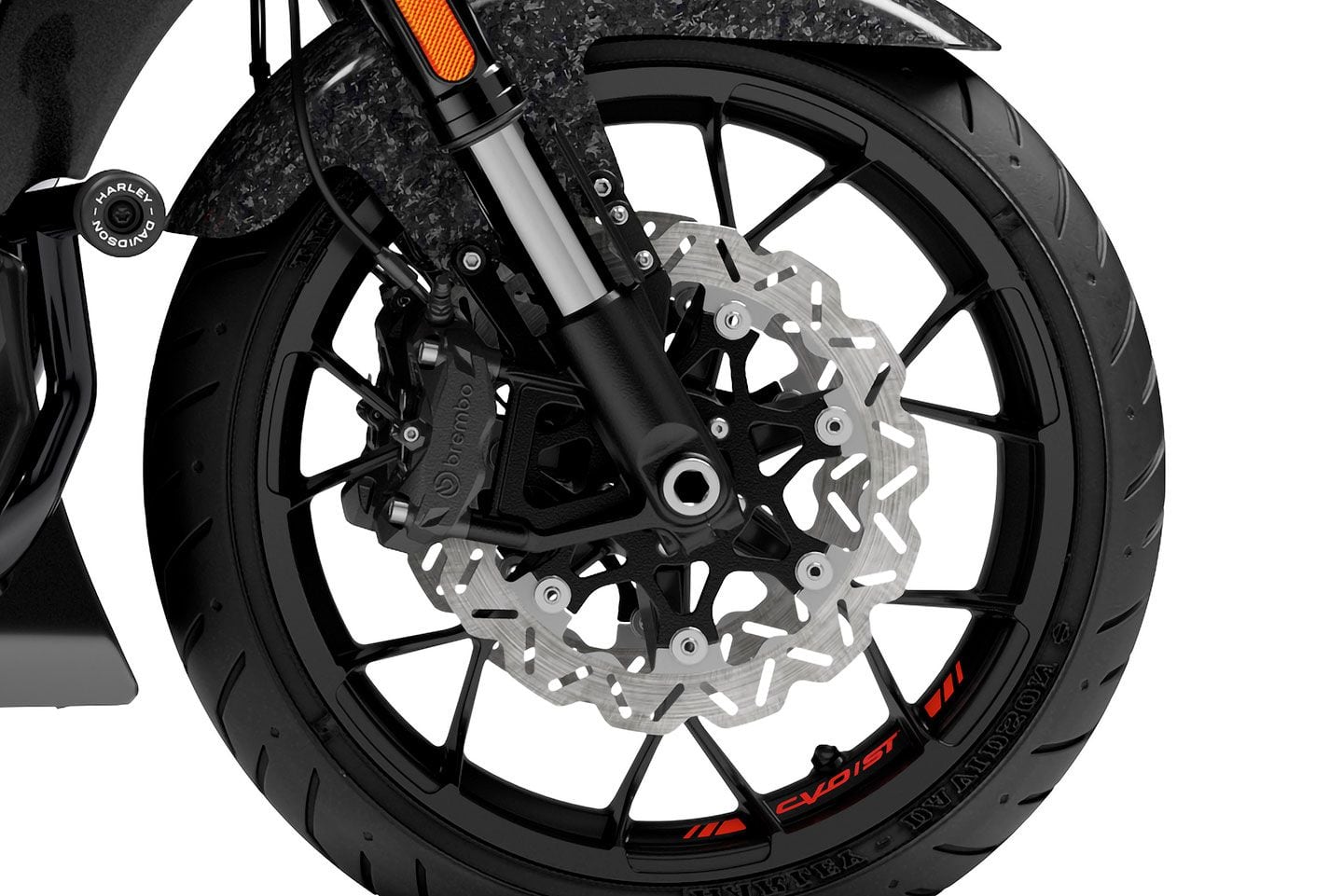
Check out that forged carbon fiber front fender. Forged carbon uses chopped pieces of carbon fiber instead of woven sheets for increased stiffness. Looks like it belongs on a supercar, which doesn’t hurt either. (Harley-Davidson/)At the heart of the CVO Road Glide ST is that Milwaukee-Eight 121 VVT engine (VVT stands for variable valve timing). Displacing 1,977cc and specially tuned to produce a claimed 127 hp and 145 lb.-ft. of torque, it has, according to The Motor Company, the highest performance figures of any production Harley ever. To drive the point home, the CVO ST has a lower final-drive ratio to boost acceleration.
The Wyman brothers’ Screamin’ Eagle factory racebikes use a Screamin’ Eagle Milwaukee-Eight 131 performance crate engine—a modified one at that, dubbed the 131R. But still the 121 engine is no joke. In fact, figures from Harley-Davidson’s website suggest that peak performance figures of a standard 131 crate engine, available to any customer through an authorized H-D dealer, aren’t too far off the numbers Harley quotes for the CVO RG ST’s Milwaukee-Eight 121 VVT.
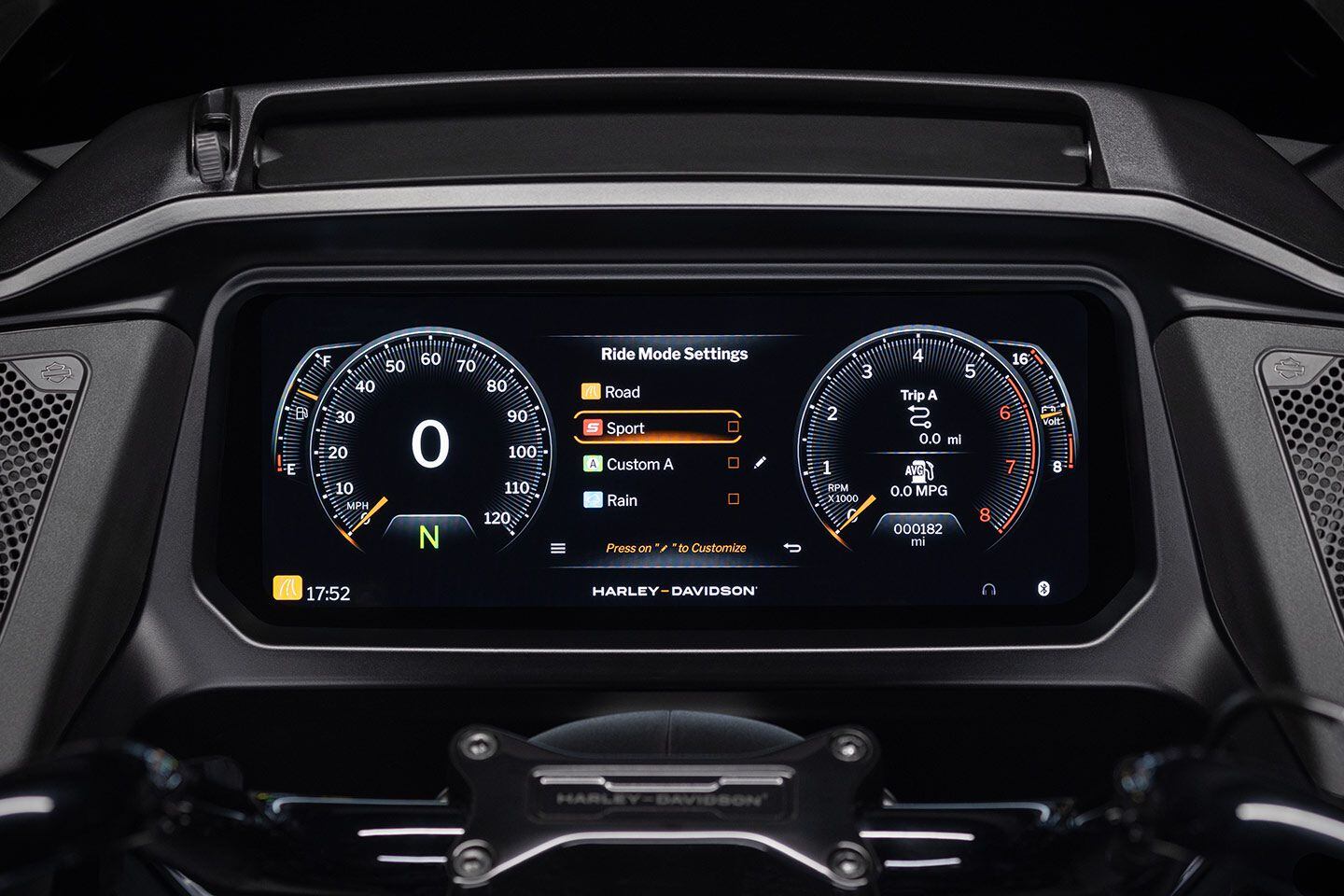
The CVO Road Glide ST uses the same dash as the standard Road Glide (pictured). (Harley-Davidson/)Weight reduction is at the heart of performance, so the CVO Road Glide ST uses a generous helping of exotic materials. Harley says the CVO ST is 25 pounds lighter than the CVO Road Glide, bringing weight down to a claimed 800 pounds (dry). OK, using exotic materials to drop 25 pounds may sound like low-hanging fruit when we’re talking about an 800-pound motorcycle, but still, there’s nothing not trick about forged carbon fiber: The front fender, exhaust end cap, seat cowl, and tank console are all made of the stuff. Other weight-saving measures include the use of a titanium muffler. Wave rotors and the design of the wheels are responsible for decreasing unsprung weight.
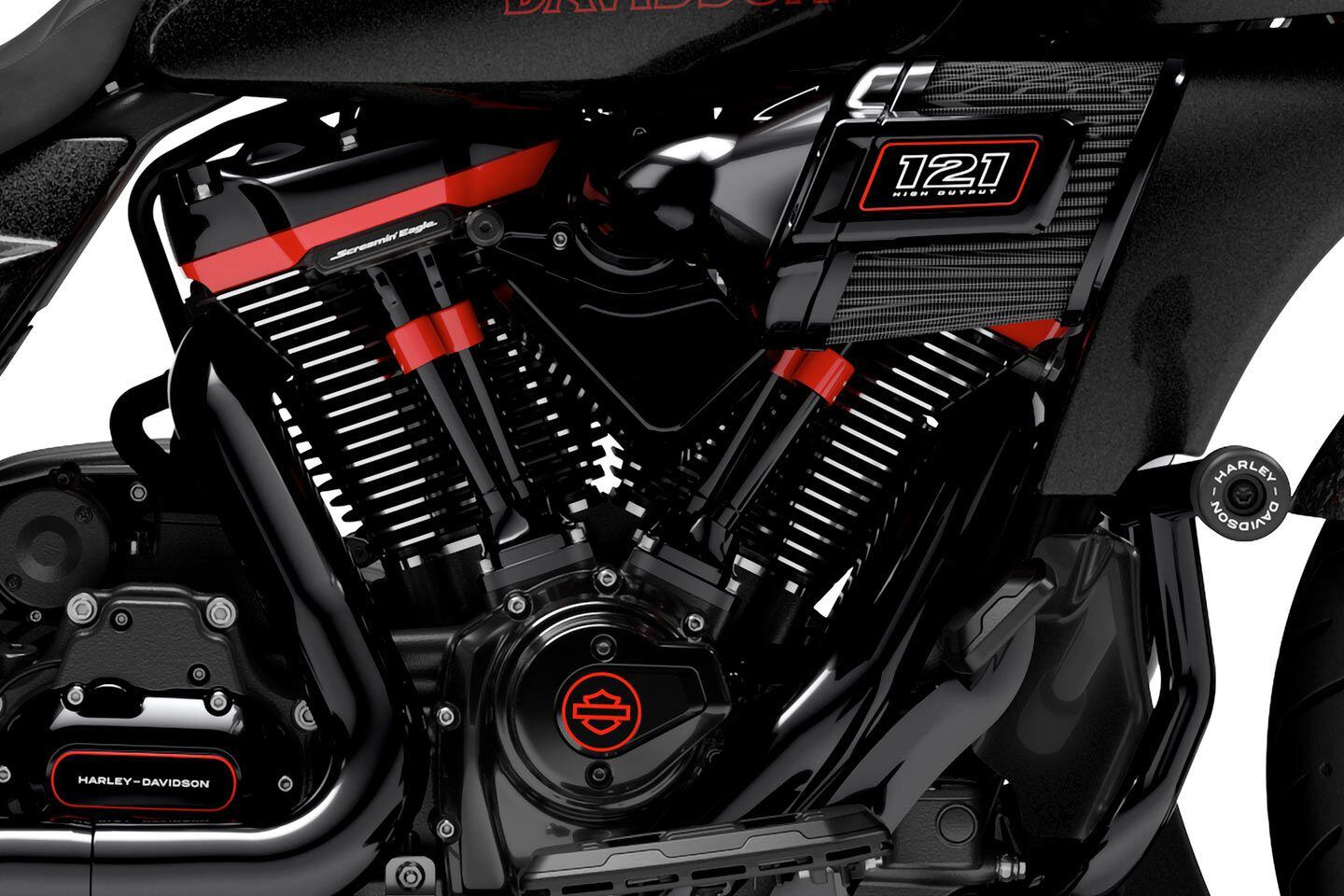
The Milwaukee-Eight 121 VVT is The Motor Company’s latest flagship Big Twin. (Harley-Davidson/)The CVO ST uses fully adjustable Showa suspension: twin rear shocks with remote reservoirs and a 47mm inverted fork. Brembo brakes front and rear provide stopping power.
Like other Road Glide models, the CVO Road Glide ST has a suite of electronic rider aids with four preset ride modes, and uses a 12.3-inch TFT dash and an infotainment system powered by Skyline OS. It’s the same kit as on the 2023 CVO Road Glide and the 2024 Road Glide. A 500-watt amplifier and Harley-Davidson Audio powered by Fosgate Stage II 6.5-inch speakers, while not great for weight loss, mean riders don’t have to sacrifice sound quality for speed. Or something like that.
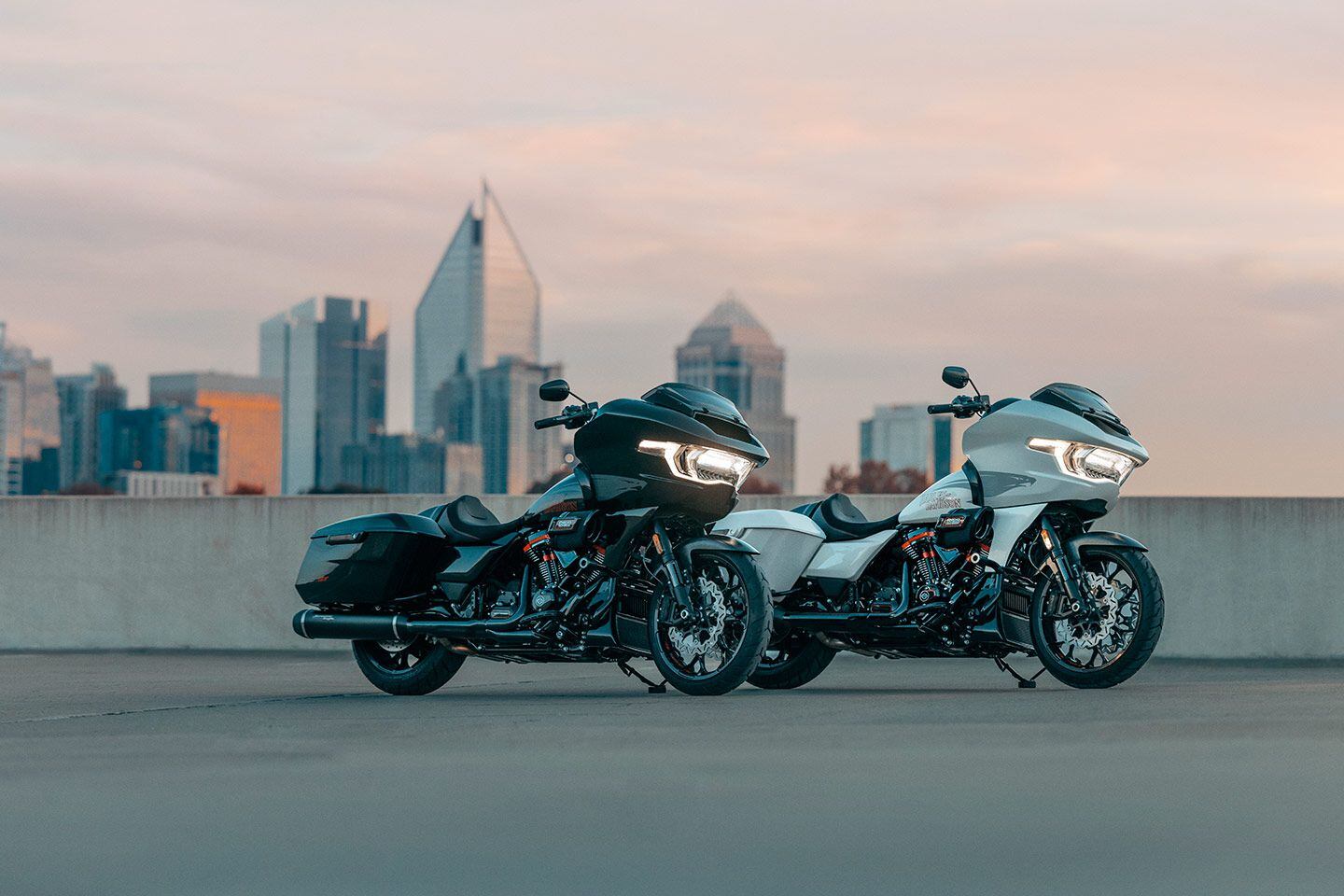
The CVO Road Glide ST is available in Golden White Pearl or Raven Metallic. (Harley-Davidson/)While the CVO Road Glide ST is no Screamin’ Eagle Road Glide Special factory racebike, it is without a doubt the most performance-oriented production Harley-Davidson bagger ever built, and for that H-D deserves some serious credit. There are some who will say adding forged carbon fiber to a heavyweight tourer in the name of weight loss is just posturing. And in reality, shedding 25 pounds does seem like a drop in the bucket. But H-D knows its CVO audience. For them, the added performance, the pride of ownership inherent to having the latest and greatest—and the premium material/premium cost bragging rights that come with it—might justify the price, which, by the way, is $42,999. Forged carbon fiber doesn’t come cheap…
For those who want the real equivalent of a homologation-spec bagger, well, keep on dreaming and attending KOTB races—maybe one day it will be more than just a dream.
Find the 2024 CVO Road Glide ST in authorized H-D dealerships beginning this month.
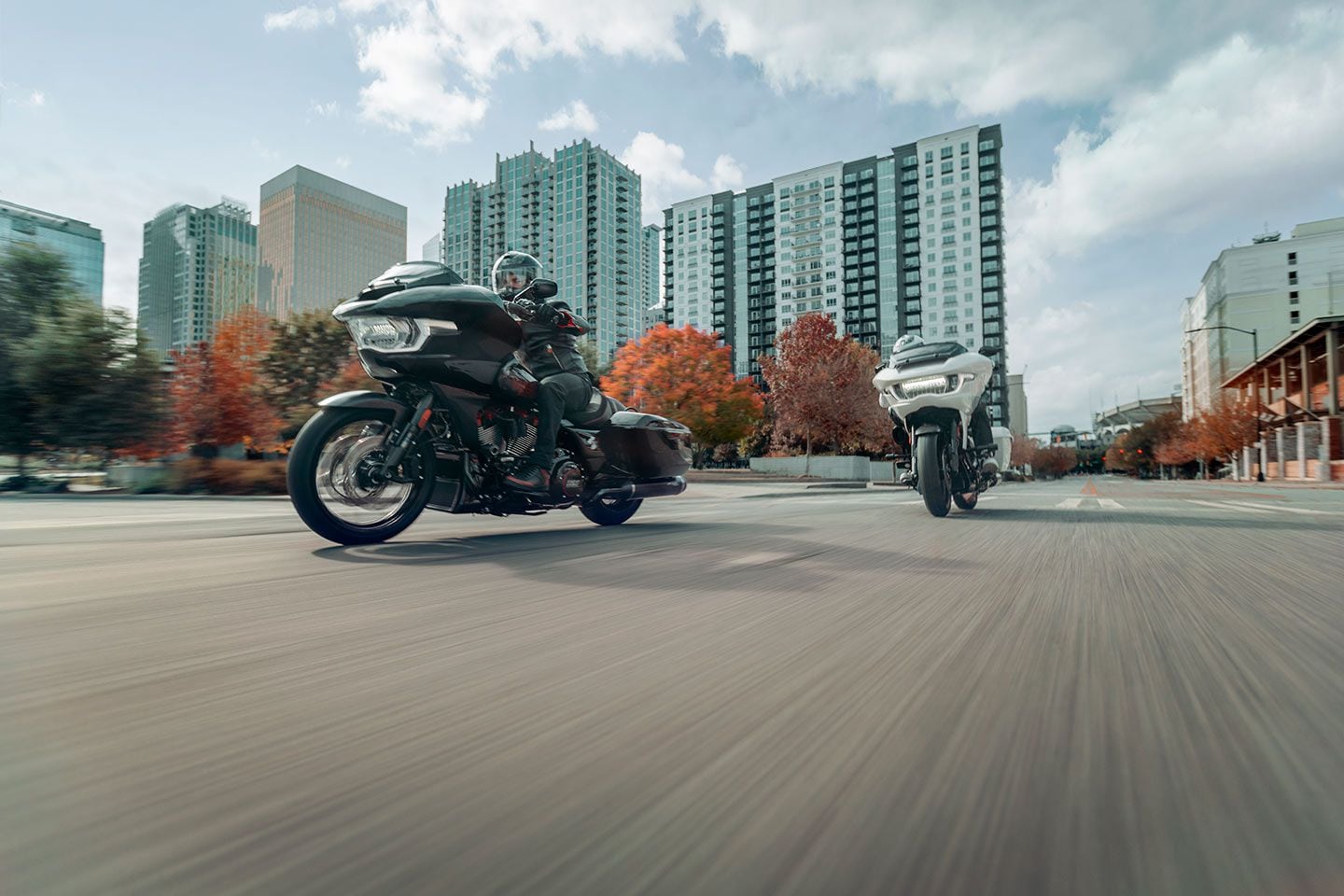
Harley-Davidson says the CVO Road Glide ST leads the 2024 CVO lineup, and for good reason. (Harley-Davidson/)-
 1
1
-
-
The 2024 Street Glide, Road Glide, CVO Road Glide ST, and CVO Pan America are here. Here's what you need to know.
-
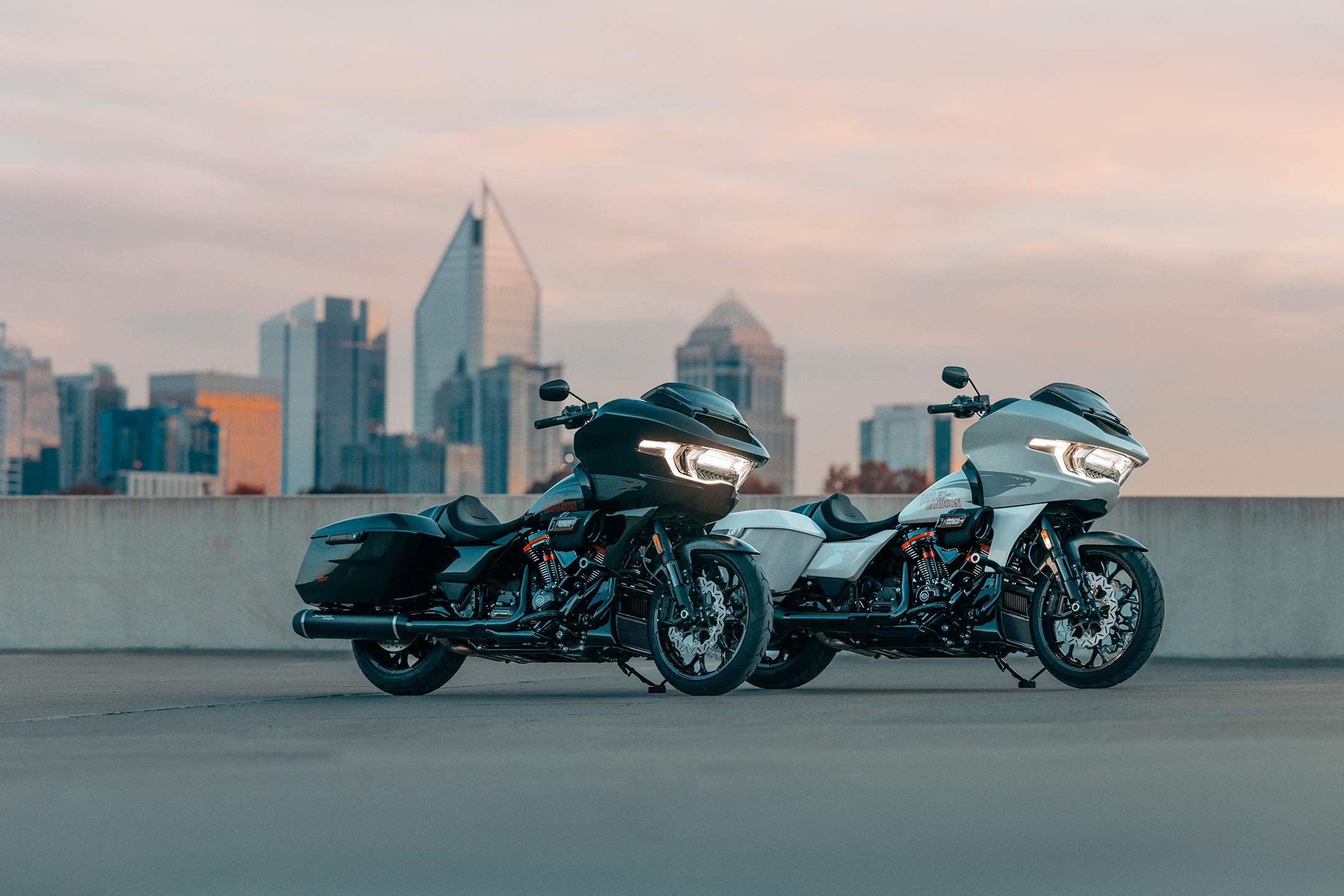
The 2024 Harley-Davidson Road Glide and Street Glide. (Harley-Davidson/)Last year, Harley-Davidson introduced the all-new CVO (Custom Vehicle Operations) versions of two of its most iconic touring motorcycles: the Road Glide and Street Glide. With totally revamped styling, a pumped-up 121ci V-twin engine with variable valve timing, a new infotainment system, rider aids, and upgraded suspension, it was to date one of the most thorough redesigns of two of Harley’s Grand American Touring heavy hitters. For 2024, many of those updates are extended to the non-CVO models, ushering in what Harley calls “a new era of motorcycle touring.”
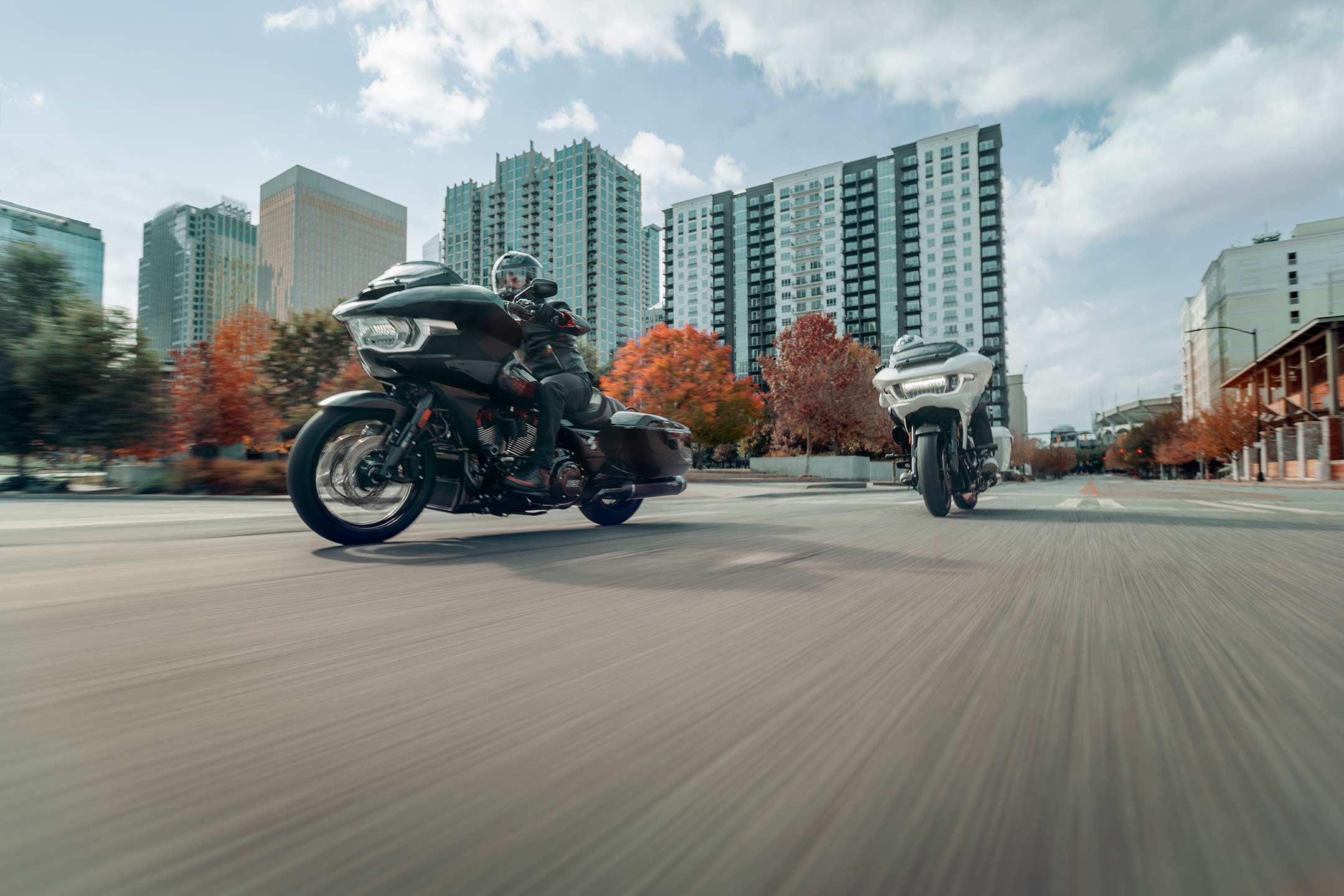
The 2024 Road Glide has a thorough redesign that still manages to look familiar. And formidable. (Harley-Davidson/)The 2024 Road Glide and Street Glide models receive the same styling, suspension, electronic rider aids, and infotainment upgrades that debuted on the CVO models. Instead of using the Milwaukee-Eight 121 VVT engines of the CVO models, however, the standard models use a Milwaukee-Eight 117 engine (previously available only on ST and CVO models) to replace the outgoing models’ Milwaukee-Eight 107 engine. Even though it’s not the supreme leader of Harley’s Big Twins, it’s still a big upgrade. Plus, it’s been refined for better efficiency and performance.
New cylinder heads derived from the Milwaukee-Eight 121 feature a reshaped combustion chamber with oval intake ports to improve performance and fuel economy. New coolant channels around the exhaust valve areas improve thermal comfort. The engine also has a new intake tract with a larger, 58mm throttle body to increase power and lower exhaust emissions. On top of that, it has a larger airbox that’s lighter and made of fewer parts compared to the previous version. Harley-Davidson claims the engine produces 105 hp at 4,600 rpm and 130 lb.-ft. of torque at 3,250 rpm.
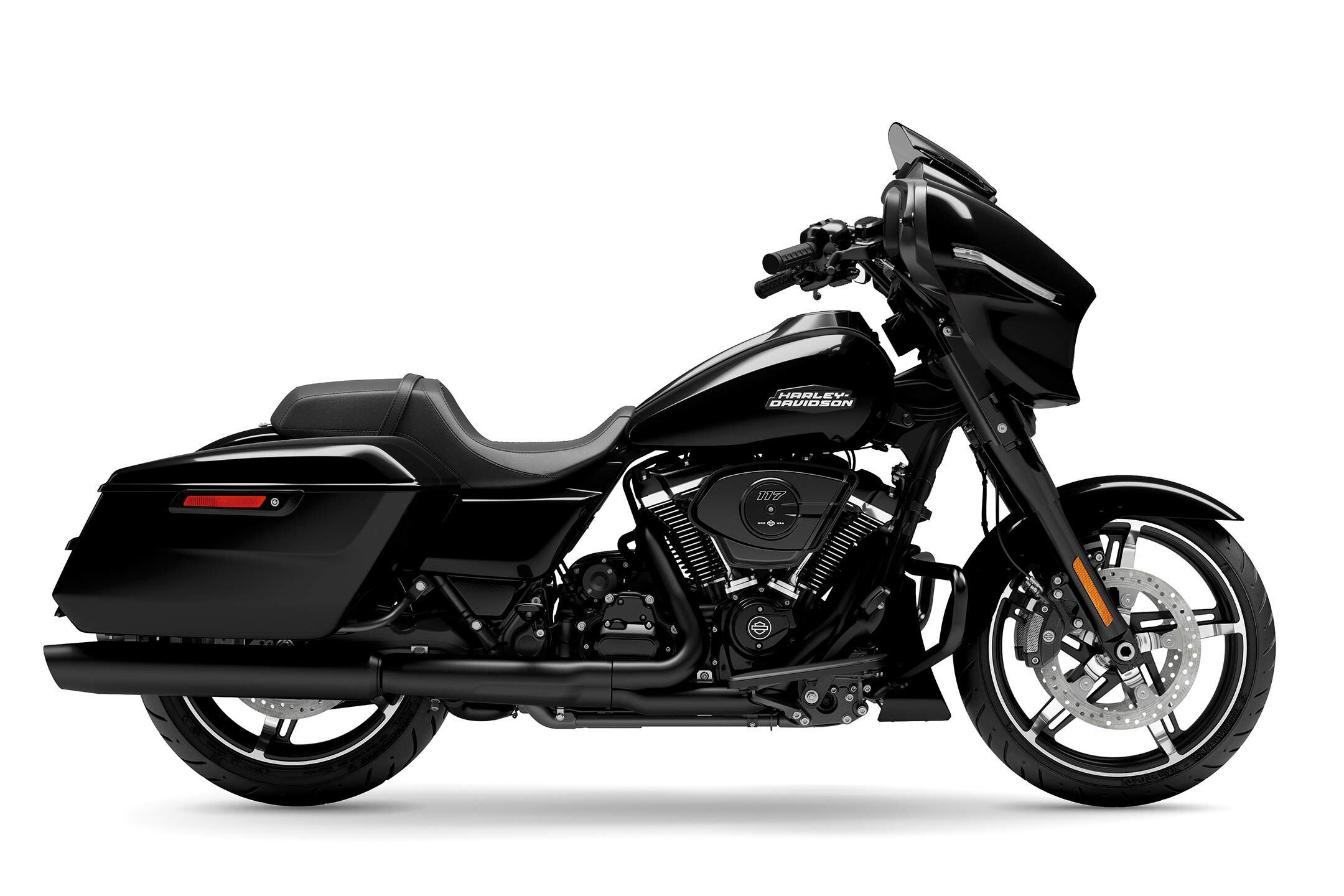
Both models use an updated version of the Milwaukee-Eight 117. (Harley-Davidson/)The chassis, heavily redesigned in 2009, is largely unchanged, but new suspension carried over from the CVO models improves handling performance. There’s a new inverted 47mm Showa fork with 4.6 inches of travel, and a Showa shock, adjustable for preload and rebound, that increases rear wheel travel by 50 percent (up to 3.0 inches of travel).
Harley claims the Road Glide weighs 838 pounds ready to ride, and the Street Glide 811 pounds. To slow down all that mass, H-D equipped both bikes with Brembo braking components, including larger 320mm discs (up from 300) and radial-mount calipers in the front, and a 300mm disc in the rear.
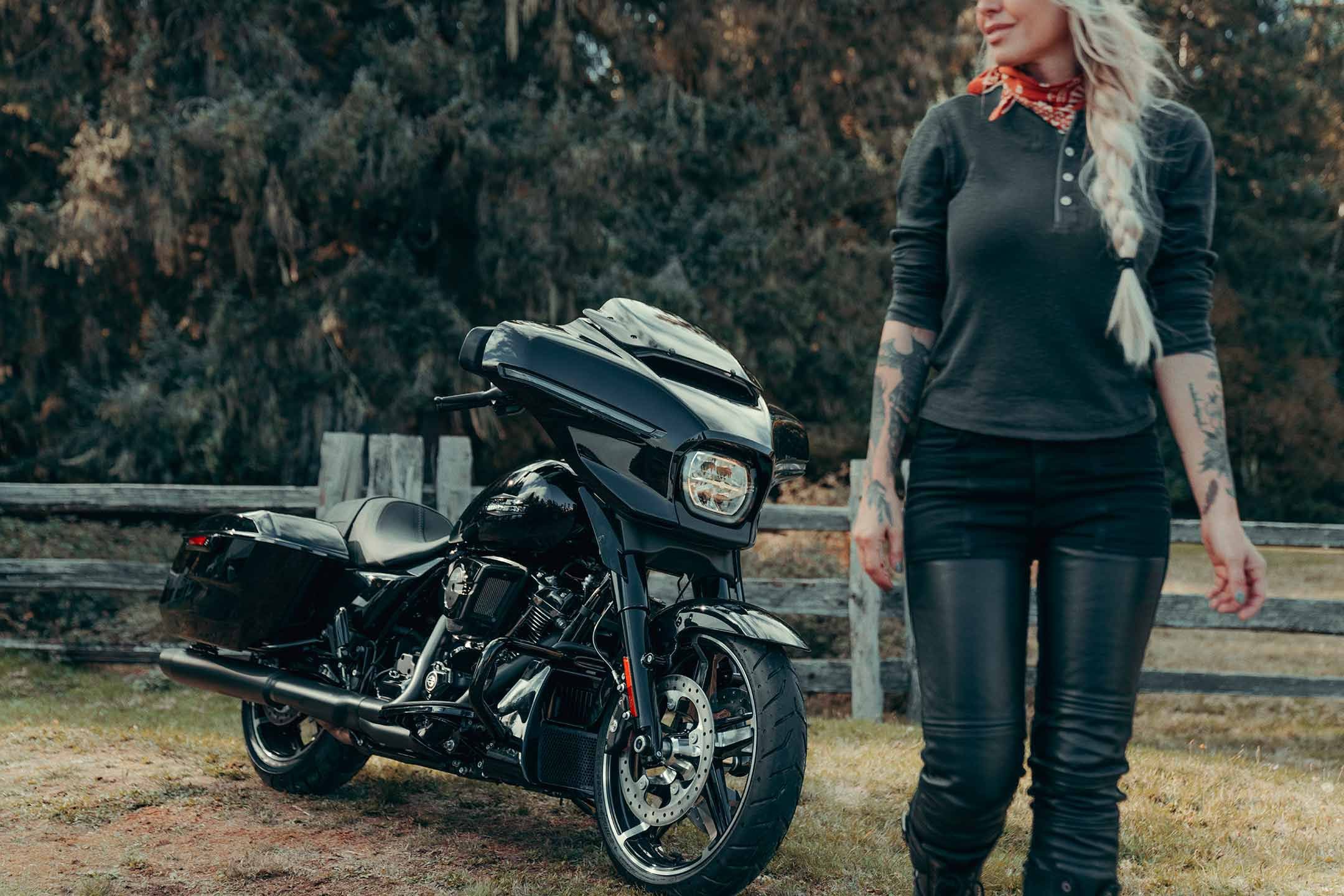
Harley’s storied FL line reaches back all the way to 1941. Both bikes use the “FL” designation today. (Harley-Davidson/)While rider aids are a relatively recent development for Harley, it’s gone to great lengths to make up for lost time. The Road Glide and Street Glide adopt a fully modern suite of electronic rider aids with four preset ride modes—Rain, Road, Sport, and Custom. With cornering-sensitive traction control and ABS, vehicle hold control, and adjustable throttle maps, riders have the ability to customize the motorcycle’s feel and performance at the touch of a button or a tap of the 12.3-inch touchscreen. The screen is also useful for controlling the tune blaring out of the two fairing-mounted speakers, which are powered by a new 200-watt amplifier.
That screen of epic proportion dominates the cockpit and eliminates every analog gauge and serves as the command center for the new Skyline OS-powered infotainment system. Infotainment: there’s a hell of a word for you. The ultimate bastardization of “entertainment,” a word so rife with Huxleyan dystopia imagery that 15 years ago—back when the Road Glide’s chassis received a major overhaul—we’d have been hard-pressed to believe it would be something we’d actually want on a motorcycle. But we do want it, as it turns out. In fact, we expect it.
No doubt, the new Glides have a ton of tech, but maybe enough still isn’t quite enough. As EIC Hoyer points out in his review of the 2023 CVO Road Glide and Street Glide, the lack of electronic suspension adjustment and adaptive cruise control feels like an omission on bikes that cost upward of $40,000. Neither of those features make an appearance on the standard, less-expensive Glides of 2024.
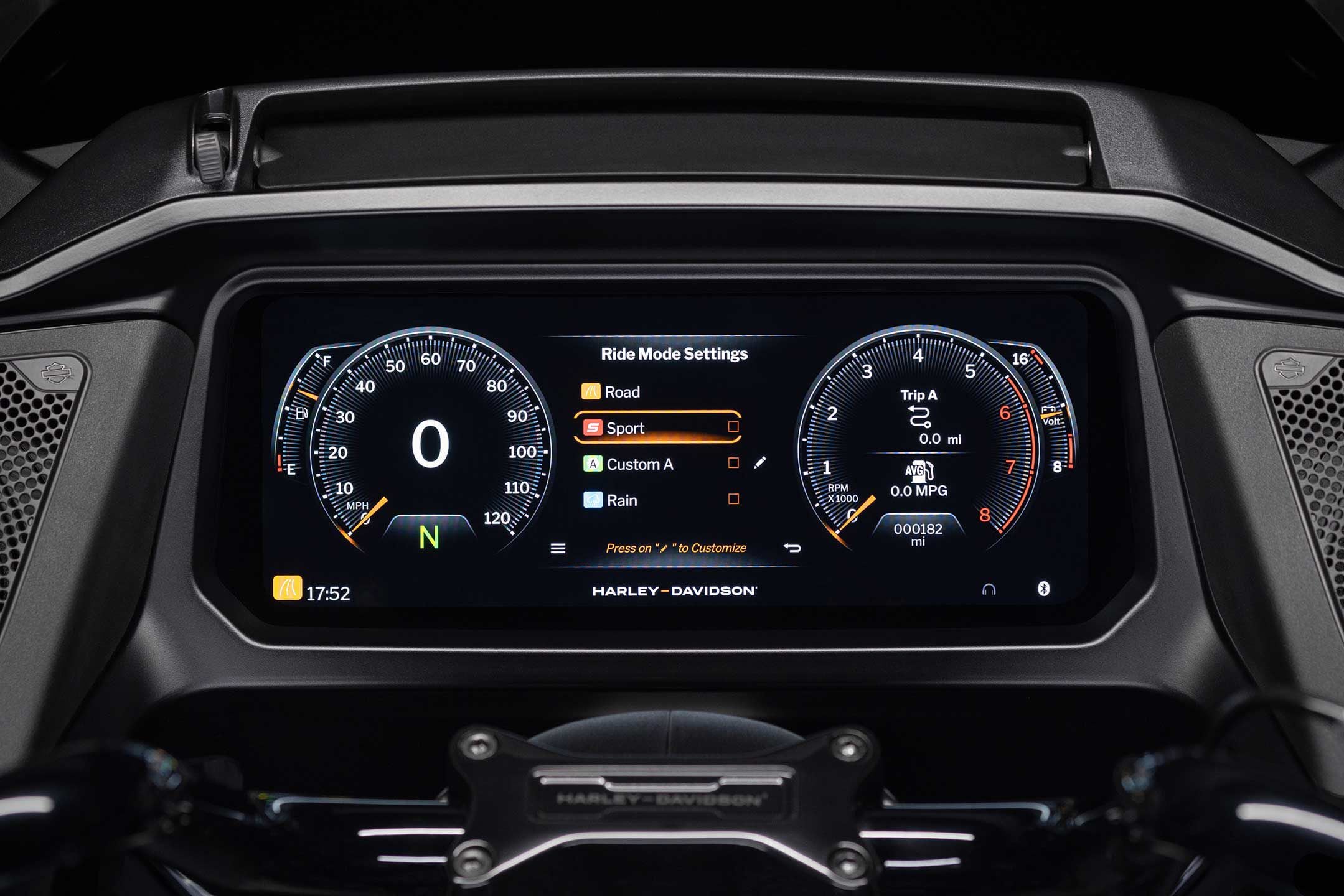
The Road Glide’s 12.3-inch touchscreen TFT display. (Harley-Davidson/)In addition to all that tech and performance, Harley signaled the dawn of a new era with all-new looks. The Road Glide, first introduced in 1998, and the Street Glide, introduced in 1985, have gone on to achieve enormous success in the market; Harley has sold literally millions of them (over 2 million touring motorcycles have sold since 2000, more precisely). Getting the right look was critical. After all, the batwing and shark-nose fairings (of the Street Glide and Road Glide, respectively) have become some of the most recognizable visages of any bike to roll out of Milwaukee in the last three decades.
That the bones of the both Glides have persisted with so little change for so long shows the designers’ crystal balls shined with exceptional clarity. At first glance the styling direction looks like a daring step, but there’s no doubt they retain the spirit of the originals. The changes aren’t merely for looks, either, as Harley-Davidson says they offer much improved aerodynamic efficiency.
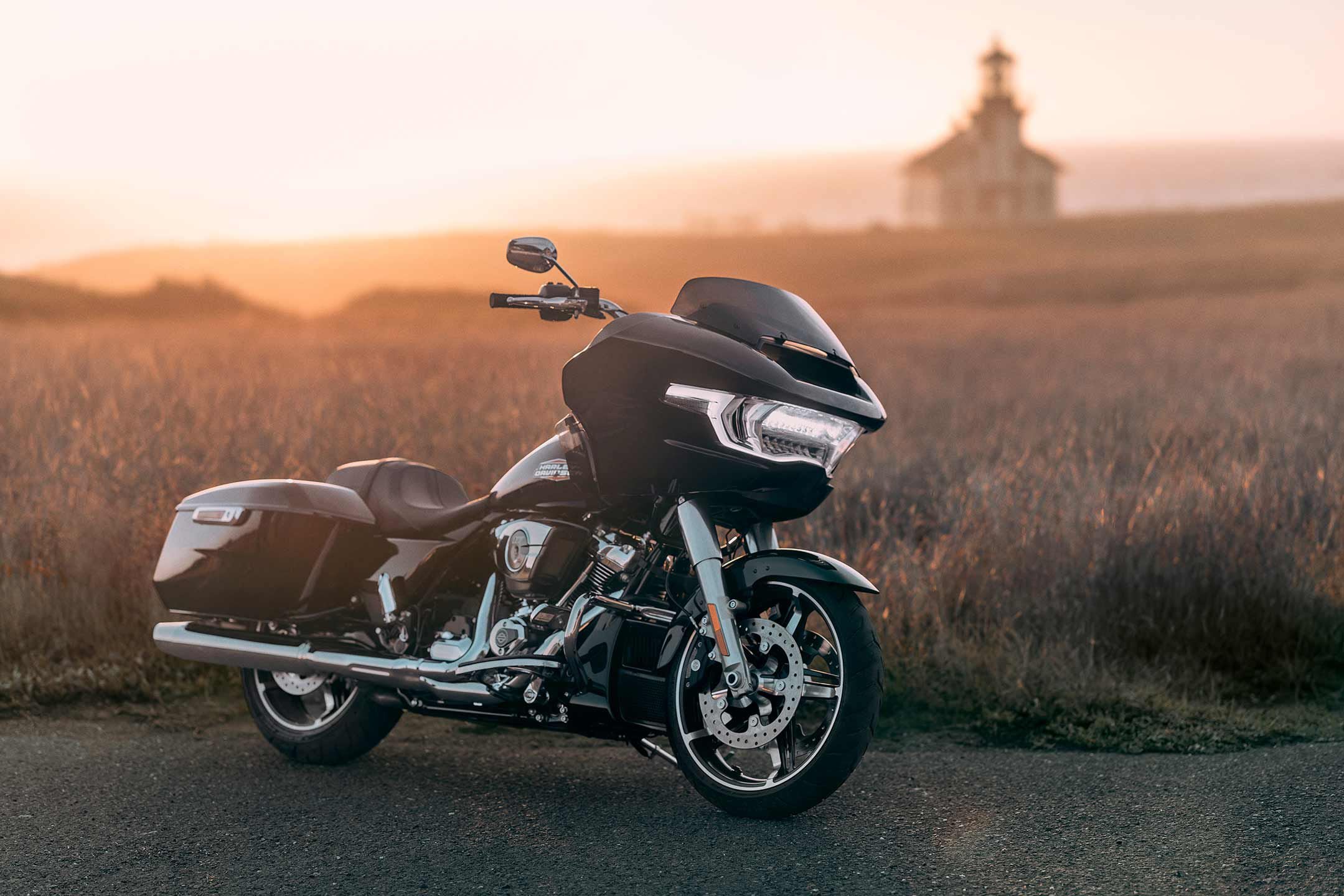
Daymaker headlight on the Road Glide. (Harley-Davidson/)If all this doesn’t constitute what H-D calls “a new era of motorcycle touring”—a new era of V-twin, American touring, at the very least—then we’re not sure what would. Because it feels an awful lot like a brave new world. And to those, like Huxley’s protagonist who cries: “But I don’t want comfort. I want God, I want poetry, I want real danger, I want freedom, I want goodness. I want sin,” we’d respond by saying the used Harley-Davidson market is as strong as ever. Just keep in mind that when new, a 2009 Road Glide’s Twin Cam 96 engine produced only 65 hp on the CW dyno.
Us? We’ll take 105 hp and a comfortable seat. Oh yeah, nearly forgot: The ‘24 Glides have redesigned comfy seats too.
The 2024 Road Glide and Street Glide will be available in dealerships beginning this month.
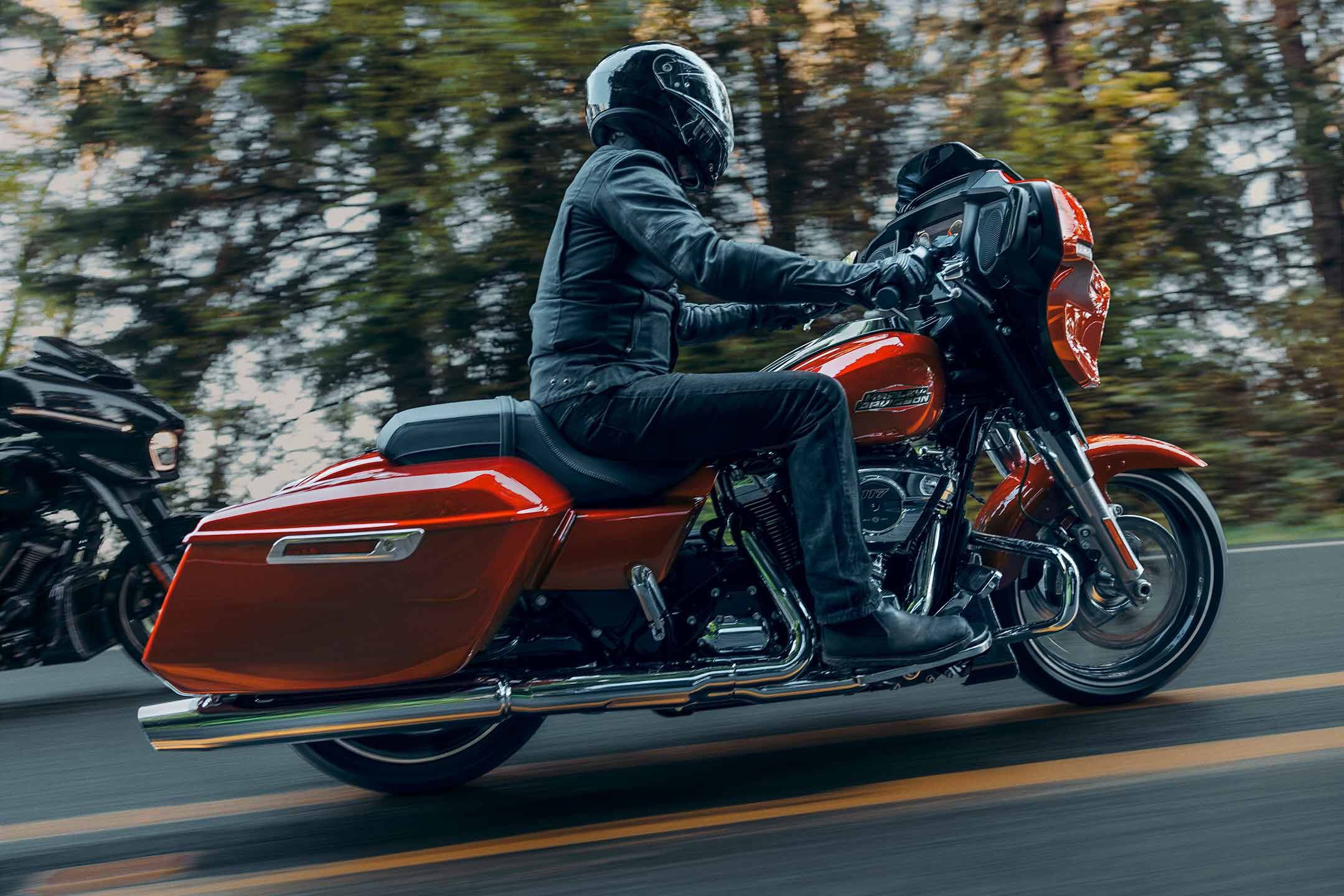
The Street Glide underway. (Harley Davidson/)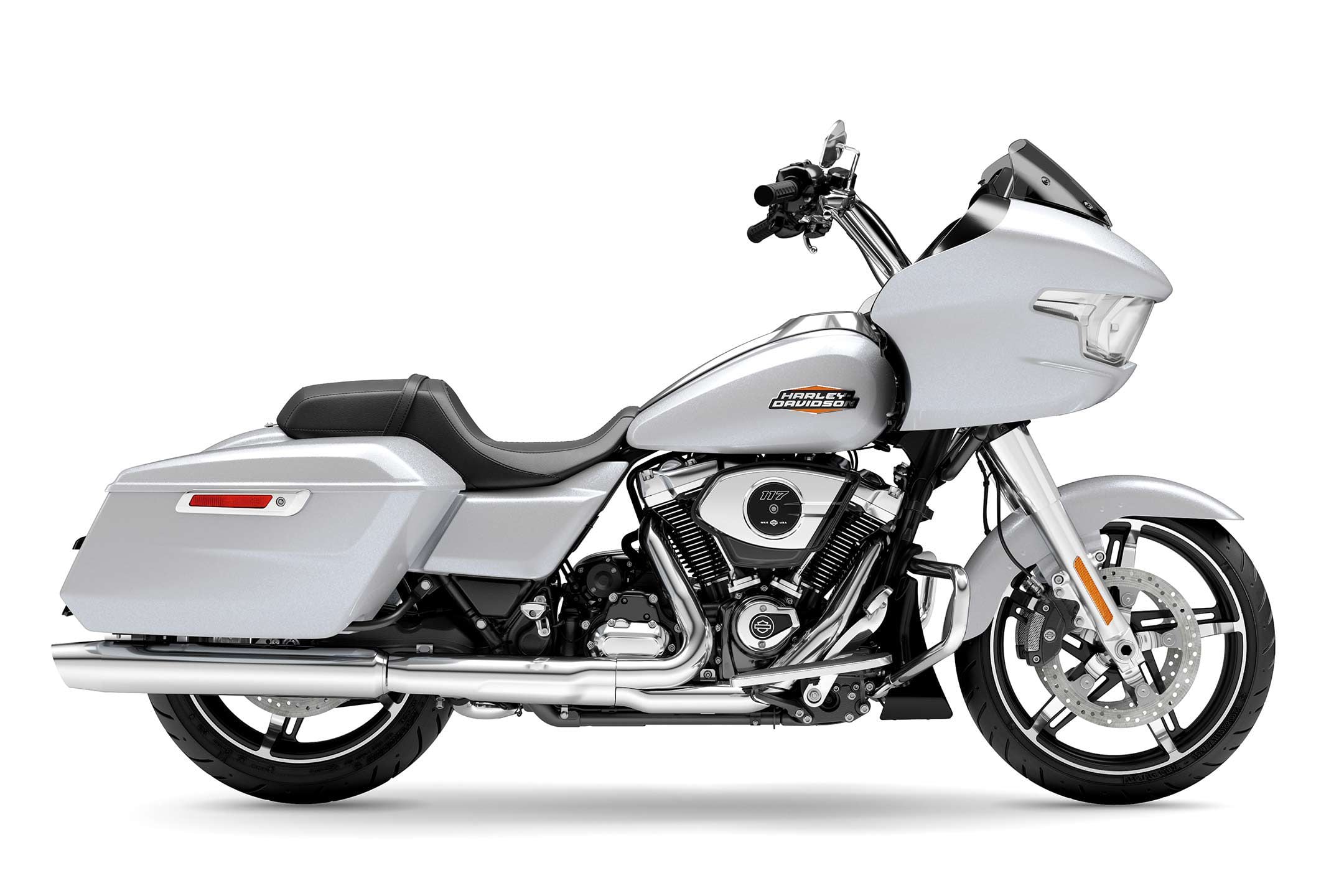
From the side, the new Road Glide could almost be mistaken for the current generation. Without taking the design too far, designers limited the possibility of alienating its customers. (Harley-Davidson/)2024 Harley-Davidson Street Glide / Road Glide Specs
MSRP: TBA Engine: Liquid-cooled, 45-degree V-twin; 4 valves/cyl. Displacement: 1,917cc Bore x Stroke: 103.5 x 114.3mm Compression Ratio: 10.3:1 Transmission/Final Drive: 6-speed/belt Claimed Horsepower: 105 hp @ 4,600 rpm Claimed Torque: 130 lb.-ft. @ 3,250 rpm Fuel System: Electronic Sequential Port Fuel Injection Clutch: Wet, multiplate slipper/assist Frame: Steel tube w/ two-piece backbone and bolt-on rear subframe Front Suspension: 47mm inverted Showa fork; 4.6 in. travel Rear Suspension: Dual emulsion shocks, spring preload, rebound damping adjustable, 3.0 in. travel Front Brake: 4-piston radial-mount calipers, floating 320mm discs w/ ABS Rear Brake: 2-piston caliper, 300mm disc w/ ABS Wheels, Front/Rear: Cast laced; 19 x 3.5 in. / 18 x 5 in. Tires, Front/Rear: Dunlop H-D Series bias blackwall; 130/60B-19 / 180/55B-18 Rake/Trail: 26.0°/6.7 in. ; 26.0°/6.8 in Wheelbase: 64.0 in. Ground Clearance: 5.5 in. / 5.7 in. Seat Height: 28.1 in. / 28.3 in. Fuel Capacity: 6.0 gal. Claimed Wet Weight: 811 lb. / 838 lb Contact: harley-davidson.com -
Join Dork In The Road as he highlights the pros and cons of each bike.
-
 1
1
-
-
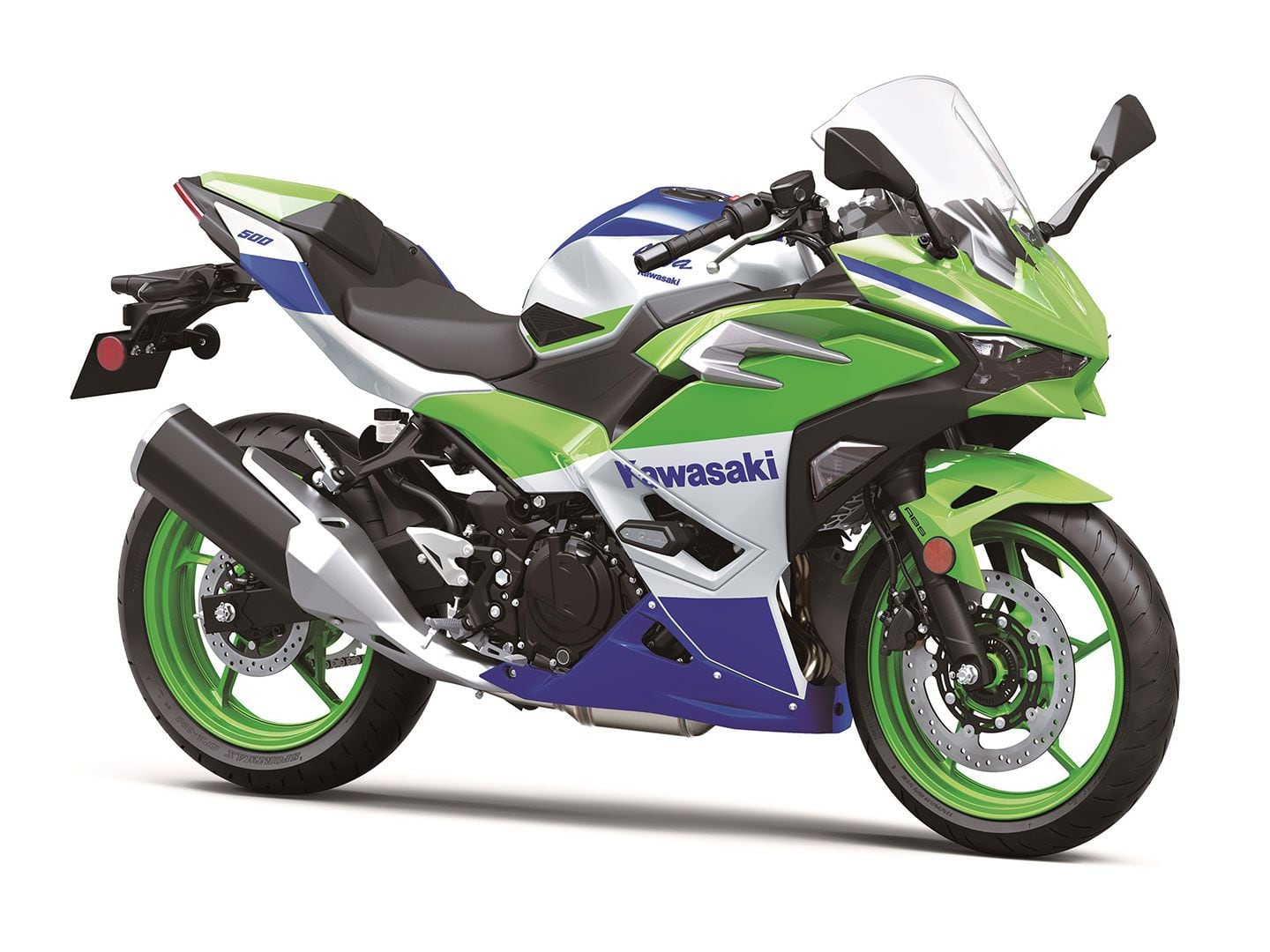
The 2024 Kawasaki Ninja 500. (Kawasaki/)For 2024, Kawasaki is introducing the Ninja 500, updating and replacing the popular Ninja 400. The latest in a long line of small-capacity non-ZX Ninja sportbikes, the Ninja 500 gets a larger 451cc twin-cylinder engine in addition to updated styling, LED lighting, and a new LCD instrument cluster. Joining the lineup is an up-spec SE model that includes premium features like a TFT dash and keyless ignition.
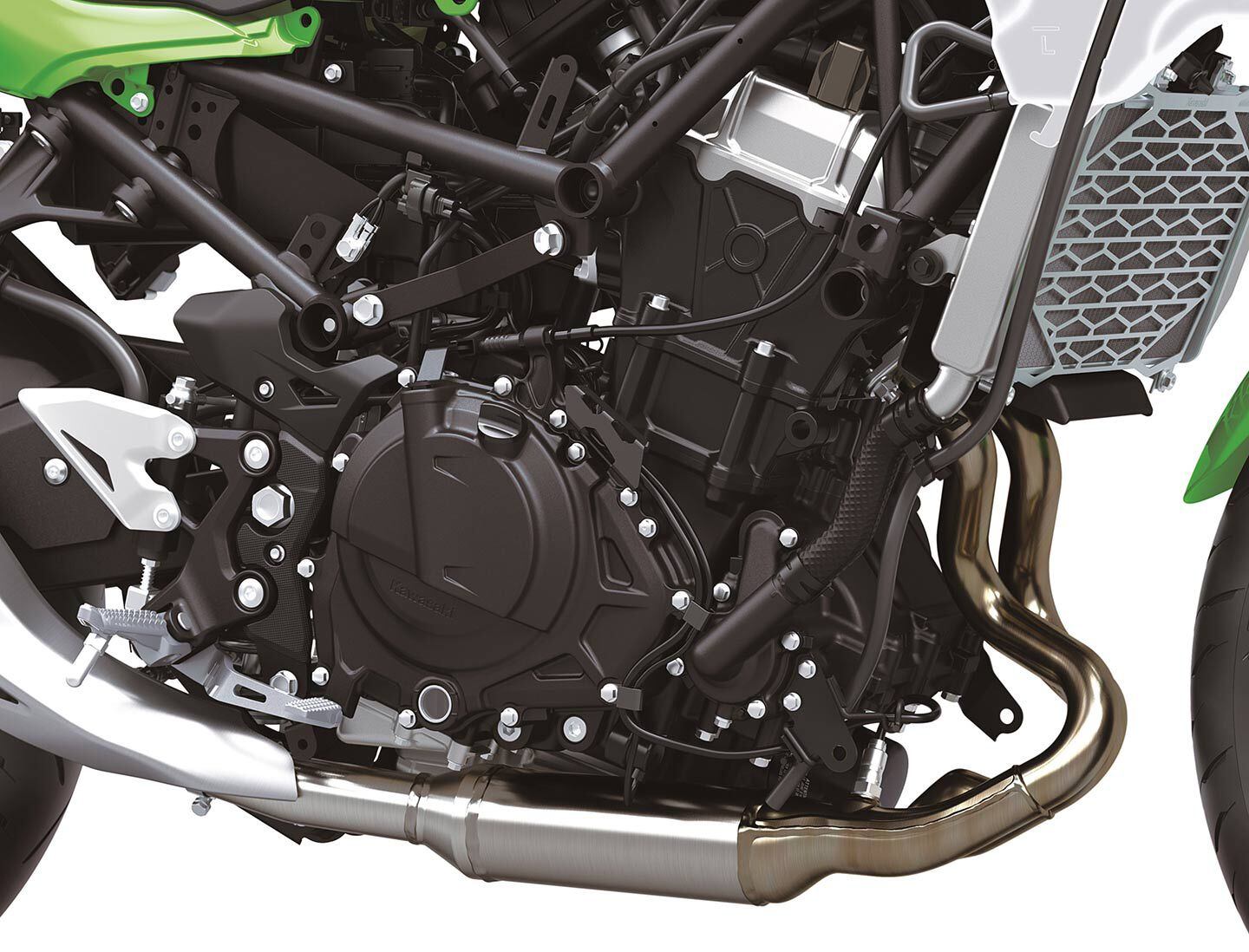
The Ninja 500 gets a capacity increase to the tune of 52cc. Kawasaki claims the 451cc engine produces 31.7 lb.-ft. of torque at 7,500 rpm. (Kawasaki/)When the Ninja 400 replaced the Ninja 300 in 2018, its chassis and twin-cylinder engine were dramatically overhauled, so Kawasaki found no need to return to the drawing board for the latest update. Based largely on the Ninja 400, the 500′s increased engine capacity comes courtesy of a 6.8mm-longer stroke (bore is unchanged). Kawasaki claims the engine produces 31.7 lb.-ft. of torque at 7,500 rpm. That peak torque figure is not only 3.7 lb.-ft. greater thanks to a longer stroke, it also comes 500 rpm earlier in the rev range. To suit the increased capacity, Kawasaki revised the balancer shaft to quell vibration, increased clutch capacity, and modified the connecting rods, crankshaft, and piston (which includes an alumite surface treatment on the top ring land). The changes may not impress your mates at the local tavern, but added together, they attest to the incredibly thorough R&D that underlines Kawasaki’s commitment to performance, efficiency, and durability of its smallest Ninja.
The Ninja 500 uses a steel trellis frame with the engine as a stressed member; a die-cast aluminum swingarm mounting plate is bolted to the rear of the engine. Kawasaki claims the curb weight as 377 pounds. Suspension remains unchanged, with a nonadjustable right-side-up telescopic fork at the front and a preload-adjustable rear shock at the rear. The Ninja 500′s braking package is also nearly identical to its predecessor, save for an updated front brake master cylinder.
Kawasaki tweaked the styling for the Ninja 500, co-opting the Ninja ZX-6R’s LED headlights to create a new-look front-end. A new LCD instrument cluster and a reshaped seat continue the theme of “refine, refine, refine.”
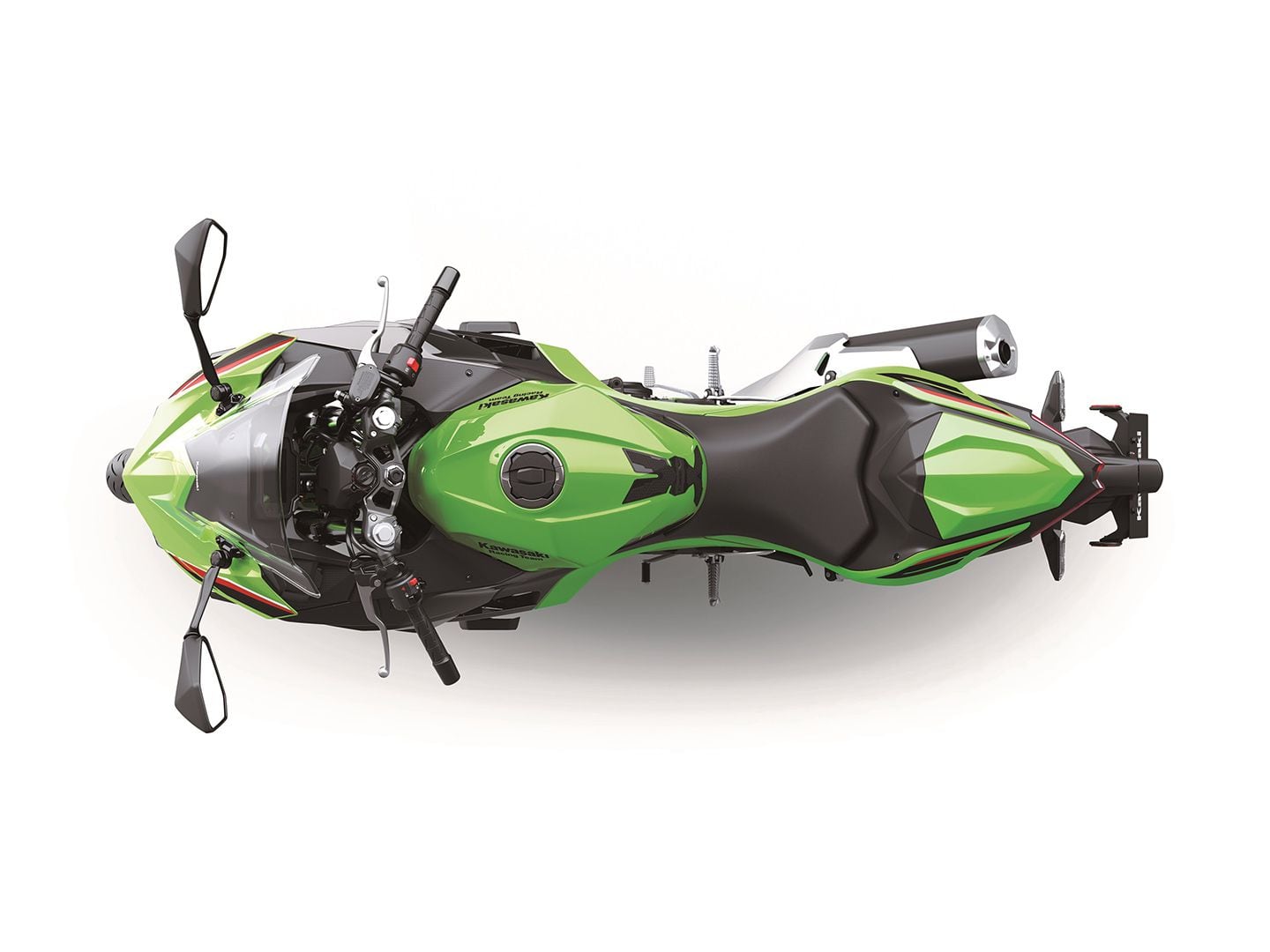
The KRT edition is available on a base-model non-ABS version ($5,499) or as the SE version, which includes ABS ($6,399). (Kawasaki/)To accommodate a wider range of customers, Kawasaki is offering the up-spec SE model. The SE is equipped with ABS, a modern 4.3-inch TFT dash, and keyless ignition, or KIPASS (Kawasaki’s Intelligent Proximity Activation Start System). Go ahead and add KIPASS to the list of great motorcycling acronyms. The SE also includes a smattering of KGA (Kawasaki Genuine Accessory) parts, including a larger windscreen, a rear seat cowl, frame sliders, LED turn signals, and a USB-C outlet.
As we’ve come to expect from Kawasaki, the Ninja 500 is available in either ABS or non-ABS versions, and in standard or KRT Racing graphics. The top-line 500 SE ABS is also available in an ultracool 40th anniversary edition. The prices range from $5,299 for the non-ABS base model, to $6,599 for the Ninja 500 SE 40th Anniversary Edition ABS.
After its introduction in 2018, the Ninja 400 wound up on Cycle World’s yearly Ten Best Bikes list, winning the Lightweight Streetbike category. We said, “The Ninja’s power, slipper clutch, and almost-as-good handling is an ideal platform for inexperienced riders in need of room to grow, but thrilling enough that professional racers exit the racetrack with a childish giggle—43 hp has never been so fun!”
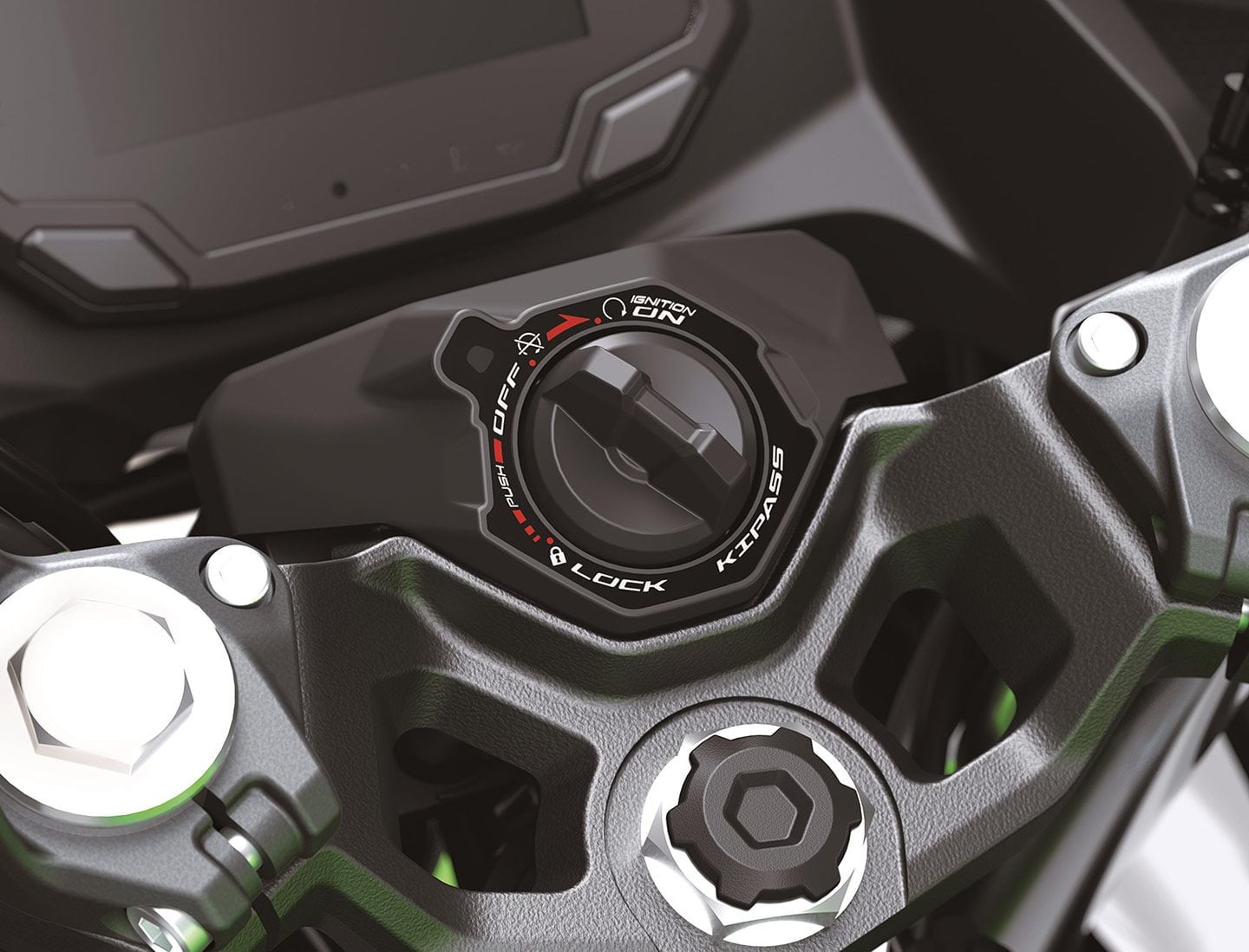
Kawasaki’s keyless ignition system: a luxurious choice for an entry-level sportbike. (Kawasaki/)For 2023, Kawasaki gave sportbike fans even more to cheer about with the new Ninja ZX-4R. Hearkening back to the small-displacement race-reps that proliferated in Japan in the ‘80s and ‘90s, the ZX-4R has a 399cc four-cylinder engine with a sky-high redline, trick suspension, and electronic rider aids. Starting at $9,399, it’s not even in the same category as the Ninja 500, but it does cast a shadow and make one think. On the other hand, a few thousand dollars buys a lot of tires, gas, and gear.
The Ninja 500 has a lot going for it: It’s based on a proven and loved motorcycle, it has a greater engine capacity than most of its direct competition—and in some cases even an additional cylinder—and its friendly ergos and plush suspension make it a lovely streetbike. What it doesn’t have is the electronic rider aids of Cycle World’s 2023 Ten Best Lightweight Streetbike (the ZX-4RR), and—more critically—the 2022 winner of the same accolade.
Kawasaki is smart to offer the base model and SE model in order to cater to different preferences within the market, but we wish the higher-priced version had the tech that Kawasaki already has in its back pocket. If the SE was equipped with some level of electronic rider aids (other than ABS), it would be on a more even playing field with the best of the competition and offer a technological steppingstone to the ZX-4R or ZX-6R.
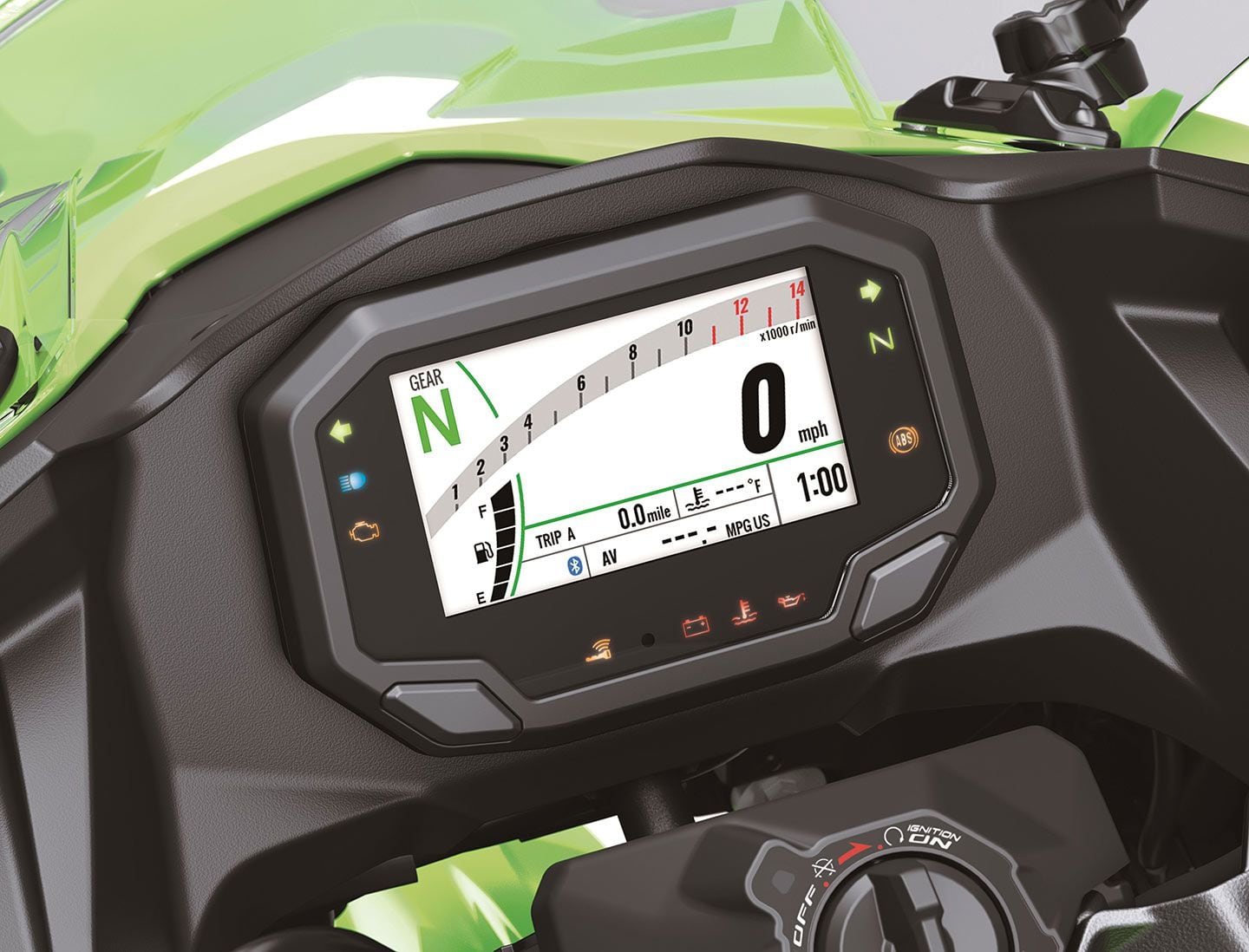
The SE version’s full-color 4.3-inch TFT dash displays all the pertinent data and connects to your smartphone through Kawasaki’s Rideology app. (Kawasaki/)With the ZX-4R in the lineup, the argument could be made that small-displacement Ninjas don’t require elevated levels of tech. Considering that, the Ninja 500, unlike its predecessor, can be simply viewed as a competent entry-level, lightweight streetbike unburdened by the aspiration of riders (and journalists) who want it to be a racetrack weapon.
On the other hand, one could argue that the competition has let the cat out of the bag, forcing Kawasaki’s—and every other manufacturer’s—hand. Maybe increasingly sophisticated rider aids, even on small-displacement or entry-level bikes like the Ninja 500, are demanded as much as a TFT display or a slipper clutch. Like everything, the right answer depends on your perspective or your pocketbook.
Regardless, the Ninja 500 promises to improve on an already great platform. Look for it in authorized Kawasaki dealers now.
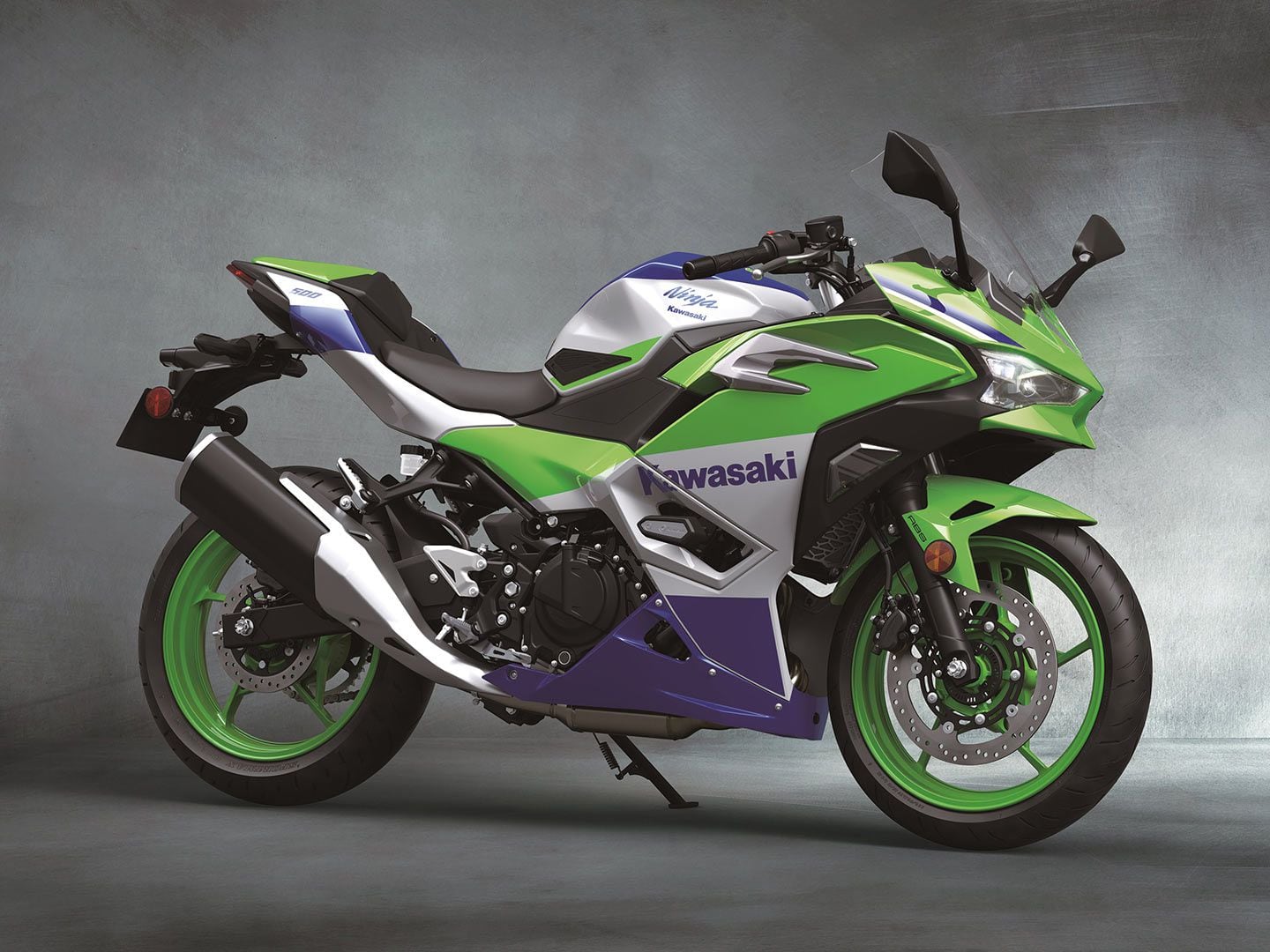
The 40th anniversary edition celebrates 40 years of Ninja motorcycles…with a paint scheme reminiscent of a mid-’90s (i.e., 30-year-old) Ninja. Details, details. The green/white/blue looks so good we hope Kawasaki keeps using it beyond 2024. (Kawasaki/)2024 Kawasaki Ninja 500 Specs
MSRP: $5,299–$6,299 Engine: DOHC, liquid-cooled parallel twin; 8 valves Displacement: 451cc Bore x Stroke: 70.0 x 58.6mm Compression Ratio: 11.3:1 Transmission/Final Drive: 6-speed/chain Claimed Horsepower: N/A Claimed Torque: 31.7 lb.-ft. @ 7,500 rpm Fuel System: DFI w/ 32mm throttle bodies Clutch: Wet, multiplate assist/slipper; mechanically operated Frame: Steel trellis Front Suspension: 41mm hydraulic telescopic fork; 4.7 in. travel Rear Suspension: Uni-Trak shock, preload adjustable; 5.1 in. travel Front Brake: 2-piston caliper, 310mm disc Rear Brake: 2-piston caliper, 220mm disc Wheels, Front/Rear: Cast aluminum; 17 in. Tires, Front/Rear: 110/70-17 / 150/60-17 Rake/Trail: NA/3.6 in. Wheelbase: 54.1 in. Ground Clearance: 5.7 in. Seat Height: 30.9 in. Fuel Capacity: 3.7 gal. Claimed Wet Weight: 377 lb. Contact: kawasaki.com -
 1
1
-
-
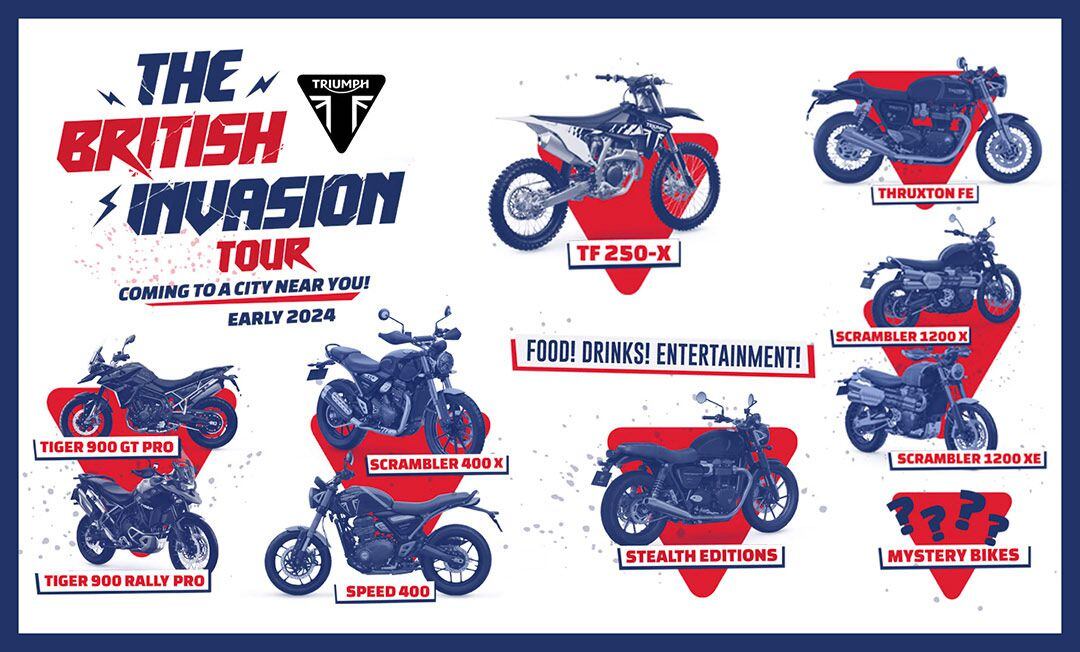
Triumph British Invasion Tour 2024 (Triumph/)Triumph Press Release:
On Tuesday, January 9th, Triumph Motorcycles America kicks-off a 20 city tour which will showcase an impressive array of all-new motorcycles. In 2024 Triumph is introducing an incredible amount of all-new motorcycles, and poised to make a major impact in the North American motorcycle market, reminiscent of when British rock bands took America by storm in the 60′s.
To celebrate the large wave of new model motorcycles, Triumph is hosting 20 “British Invasion Tour” events across the United States in January and February, where each of the new models will be showcased. At every event, Triumph enthusiasts will gather for an exclusive one night only first look at the new for ‘24 models which are not yet in dealerships, while also enjoying live entertainment, a variety of activations, and some light food and beverages.
Adam VanderVeen, Marketing Director for Triumph Motorcycle America said, “It’s been a few years since Triumph has planned a tour like this, but with a line-up like Triumph is bringing for 2024 the time is right to host a series of new model release parties like only Triumph can, because every one of these game-changing new motorcycles deserves to be showcased. In addition to offering enthusiasts the chance to see the latest new models, the best part of these tour events is creating a premium brand experience for our owners and fans to come out and enjoy an evening together as a Triumph community.”
The British Invasion Tour will feature a curation of Triumph’s exciting new model year 2024 motorcycles, including:
All-New TF 250-X
Triumph Motorcycles has officially launched the new TF 250-X, revealing a class-leading power to weight ratio and the most complete specification package ever to launch into the ultra-competitive 250cc motocross market.
Developed entirely by Triumph in close collaboration with racing champions including Ricky Carmichael and Iván Cervantes, the new four stroke competition model is an all-new ground-up design. The performance racing powertrain and unique aluminum chassis are ultra compact and super light, with all the best components on the market, already fitted out of the crate.
All-New Speed 400 & Scrambler 400 X
Born into a peerless bloodline, the Speed 400 joins Triumph’s most successful modern classic line-up, the Speed Twin 900 and 1200 while the Scrambler 400 X takes its rugged design cues from the Scrambler 900 and 1200, with an off-road pedigree that goes back to the first factory Scramblers of the 1950s.
Designed from the ground-up with a brand new single-cylinder, four-valve, liquid-cooled engine platform at their heart, these new models are designed to deliver a fun, agile, and confidence-inspiring ride for riders of all ages and experience levels.
Updated Scrambler 1200 XE & All-New Scrambler 1200 X
The cool and capable Scrambler 1200 XE hits the road in the new year sporting updates including latest-generation Brembo Stylema® calipers, new suspension with enhanced adjustability, enhanced styling details, and improved touring capability.
The new Scrambler 1200 X delivers the same exceptional core capability, commanding riding position, and torque-rich performance Scrambler customers love, combined with a generous specification of equipment and technology. Built to be more accessible, the Scrambler 1200 X has a seat height of 32.28″, reduced to 31.29″ with the accessory low seat, and dedicated specification that offers exceptional functionality at a more competitive price.
Fully updated Tiger 900 Rally Pro & GT Pro
Delivering more power, torque, capability, and comfort, the new Tiger 900 range from Triumph Motorcycles is raising the bar for middleweight adventure bikes in 2024. The new line-up includes the Tiger 900 GT, GT Pro, and Rally Pro, each providing a significant step-up in performance and specification.
New for 2024 Special Edition Models
Celebrated as the ultimate café racer since 1964, the Triumph Thruxton will finish its final production run. In a fitting farewell to this award-winning motorcycle, Triumph has unveiled the Thruxton Final Edition, an exclusive and striking motorcycle with incredible specification, performance, capability, and timeless style.
Available for one year only, the new Triumph Stealth Edition models are an exclusive collection of eight beautiful Bonneville motorcycles. Each model features its own unique tank design which showcases a dramatic hand-painted finish that intensifies in the light to reveal vivid color.
Soon to be announced All-New 660 Model
A new legend is about to hit the streets. On January 9th, an all-new 660 Triumph motorcycle will be announced, and will be on display at the kick-off British Invasion Tour event in Los Angeles, California.
The British Invasion Tour is free and open to all. Guests must register to attend. All guests may RSVP and find details about each tour location at TriumphOnTour.com
-
BMW’s M 1000 RR is a homologation special designed to give BMW the best possible platform for racing. In 2023, the superbike received major aerodynamic changes while the 999cc powerplant remained the same. BMW claims the new bike, despite its unchanged engine, has a faster top speed than its predecessors due to improved aerodynamics achieved through redesigned bodywork and downforce winglets. Chassis components also remain the same, continuing with a bridge-type, cast aluminum frame and 45mm upside-down telescopic fork and full floater pro shock, both offering adjustable spring preload, compression, and rebound damping. The electronics suite remains the same for 2023 as well.
The 999cc inline-four 16-valve ShiftCam engine was measured in the 2022 M 1000 RR on our in-house dyno last year. Despite its lack of engine changes, we wanted to run the 2023 Cycle World Ten Best Superbike on our in-house Dynojet 250i dynamometer to see how the current model compares to its predecessor. Before hitting the Cycle World dyno, the 2023 BMW M 1000 RR weighed 432 pounds on our automotive scales. On the dyno, the bike produced 189.4 hp at 13,220 rpm and 79.2 lb.-ft. of torque at 11,000 rpm. For reference, the 2022 model produced 179.2 hp at 13,960 rpm and 76.3 ib.-ft. of torque at 9,480 rpm. With no physical changes to the engine from 2022 to 2023, the increase in power is interesting as BMW says there are no changes in mapping. And for those shopping in North America, the restricted US model produces less peak power than the European model at a lower rpm, according to BMW.
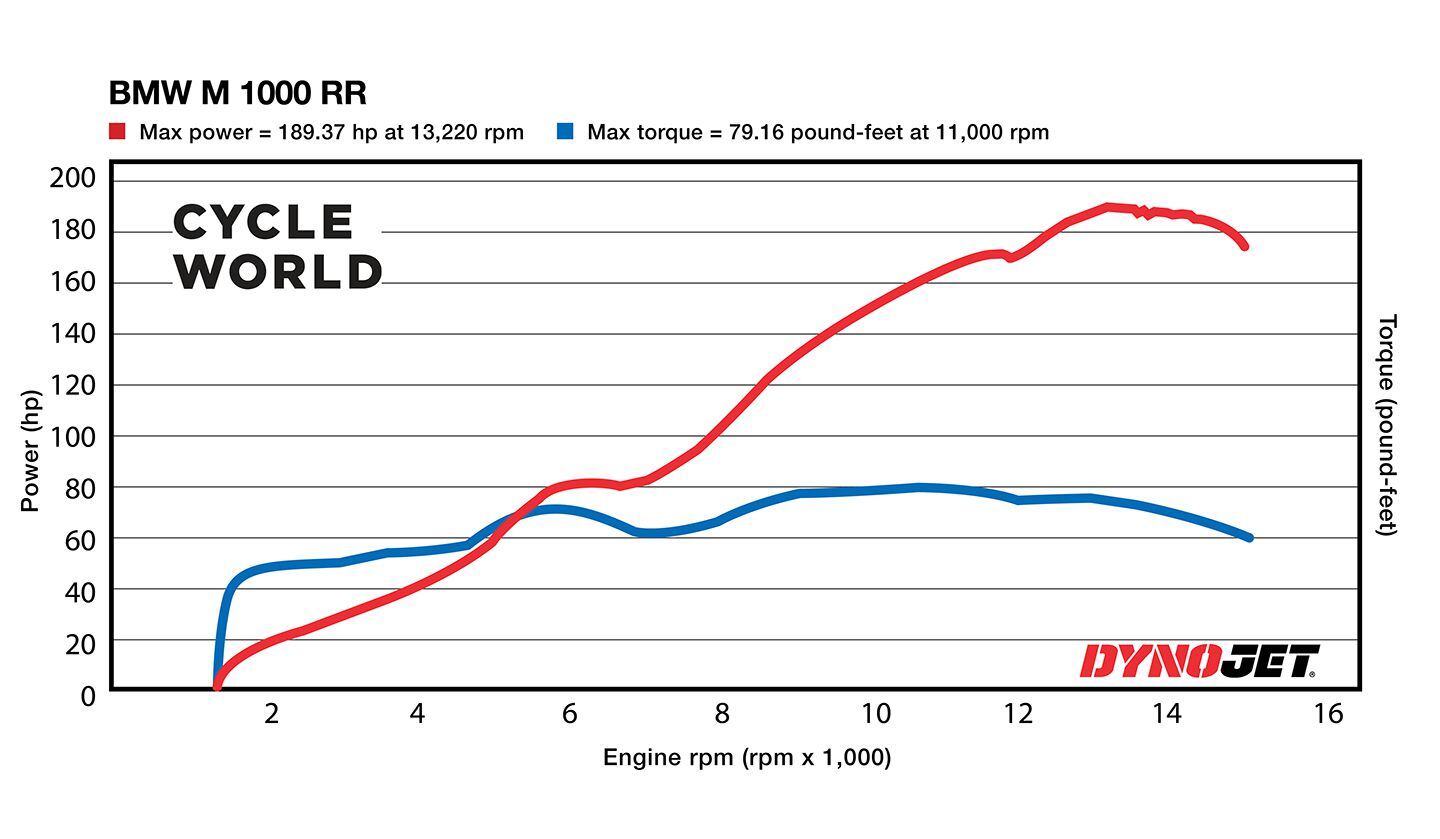
2023 BMW M 1000 RR Dyno Chart. (Robert Martin/)Despite the Barvarian superbike’s impressive peak power figures, its lack of readily available torque along with dips in the power curve require keeping the M 1000 RR singing in the upper rpm range. During our first ride on the European model in August of last year, two-time World Superbike champion Troy Corser told Cycle World test rider Adam Child to “make use of every last rpm.”
-
Look for all three in American showrooms in the first half of 2024.
-
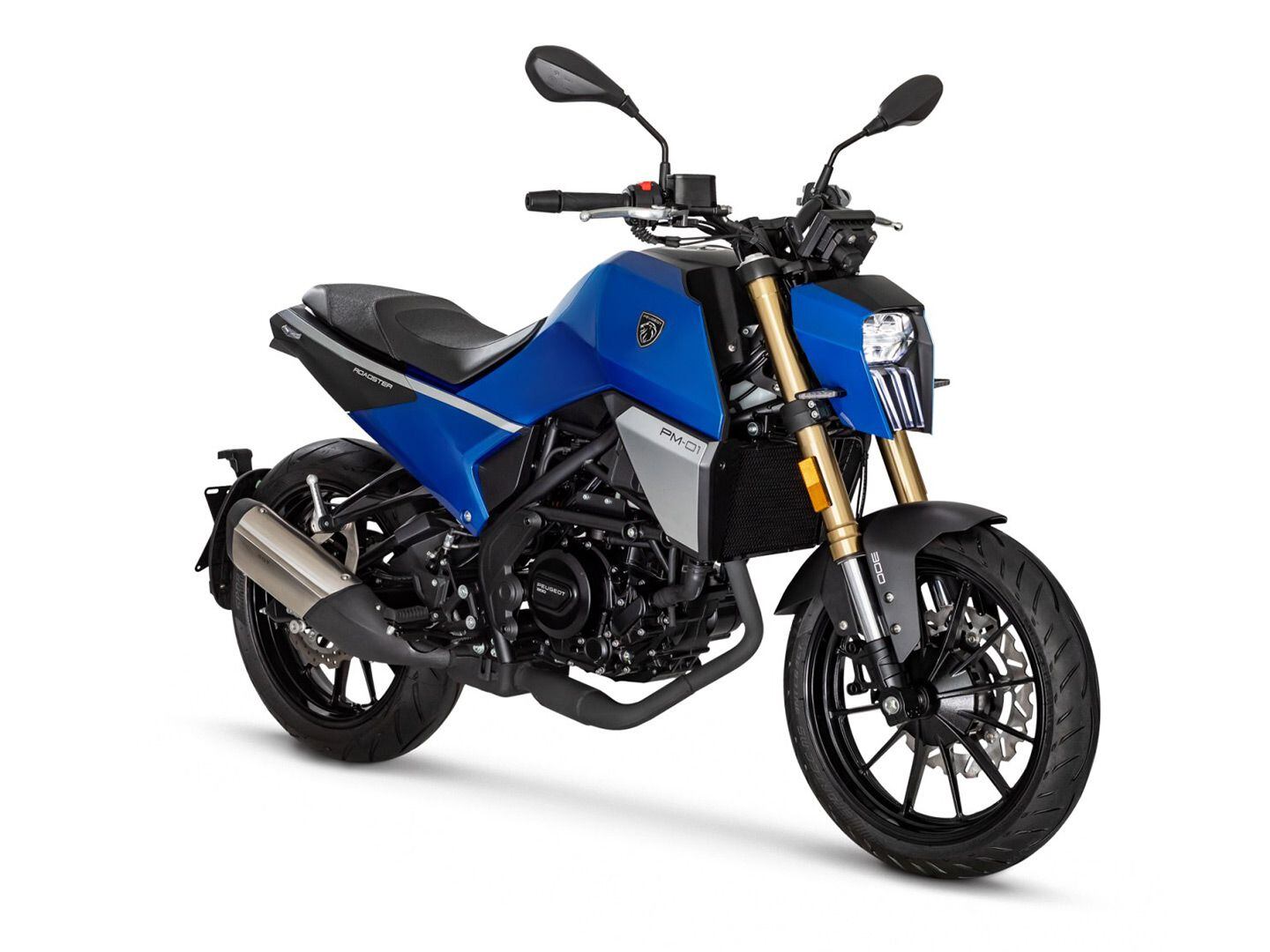
Peugeot’s PM-01 300 is powered by a Chinese-sourced single. (Peugeot/)Peugeot makes a claim to being the world’s oldest motorcycle company, having turned out its first machine back in 1898. After a long spell producing nothing but scooters the brand made a return to “real” motorcycles in 2022 with the unveiling of the PM-01 in 125cc and 300cc forms.
Now, it looks like there are plans to expand that range, with Peugeot having filed trademark applications in the European Union for the names PM-02, PM-03, and PM-05, all specifically intended for use on motorcycles. The “PM” names distinguish these machines from the brand’s scooters, so the implication is that these will be larger-capacity machines.
The Peugeot name dates to the early 1800s. The company’s roots started back in 1810 as a steel foundry, and like many others it expanded into bicycles, cars, and motorcycles as the technology developed. However, Peugeot Motocycles (yes, “Motocycles” not Motorcycles) today isn’t tied to the car brand of the same name. Back in 2014 a controlling stake in the motorcycle and scooter arm was sold off to Indian giant Mahindra, and with the rest of the company going to the same ownership in 2019, severing ties to its original parent. In 2023, Mahindra sold a controlling stake to equity firm Mutares in Munich, which controls the brand today. Meanwhile, Peugeot’s car brand is now part of the Stellantis multinational that also owns Chrysler, Jeep, Ram, Dodge, Fiat, Lancia, Alfa Romeo, and Citroën, as well as several other automotive companies.
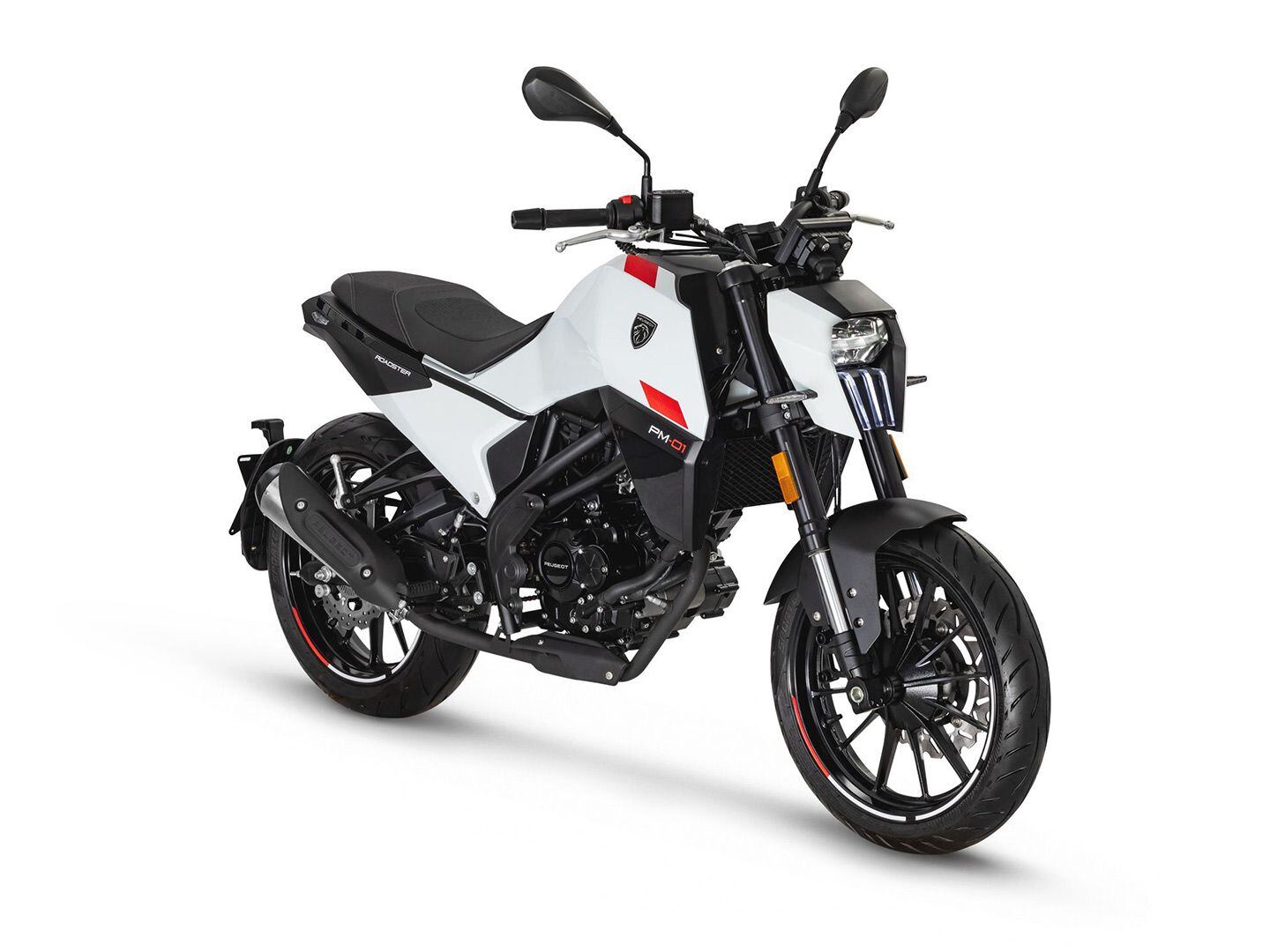
The Peugeot PM-01 125 was the first motorcycle the company produced under its new ownership. (Peugeot/)Although unveiled in 2022, the larger PM-01 300, powered by a 29 hp, 292cc single-cylinder engine of Chinese origin, is due in production later this year, with Peugeot having prioritized the 125cc version. Both models look nearly identical, with a distinctive headlight design that’s meant to be reminiscent of a lion’s claw—the lion being Peugeot’s mascot. The engine in the PM-01 300 is made by Qianjiang, using a 78mm bore and 61.2mm stroke, and is essentially a big-bore version of the design used in the Chinese company’s 249cc QJiang Honor 250 cruiser. CFMoto’s 300CL-X engine also shares a similar bore, stroke, and power output as well as some other design cues with the Peugeot single.
There are already rumors that Peugeot’s next bikes, the PM-02, PM-03, and PM-05, as revealed in the trademark applications, will include larger-capacity and multicylinder machines. What we know for certain is that the trademark applications were made after the current owners took control of the company, so they’re not leftover remnants of plans made during Mahindra’s stewardship of the brand.
Since its Mutares takeover, Peugeot has also forged a partnership with French EV motorcycle maker DAB Motors, promising to mass-produce DAB-branded electric motorcycles by leveraging Peugeot’s manufacturing expertise, while Peugeot will be able to create its own range of electric motorcycles using DAB Motors’ technology, raising the possibility that one or more of the new trademarks could be applied to battery-powered bikes.
-
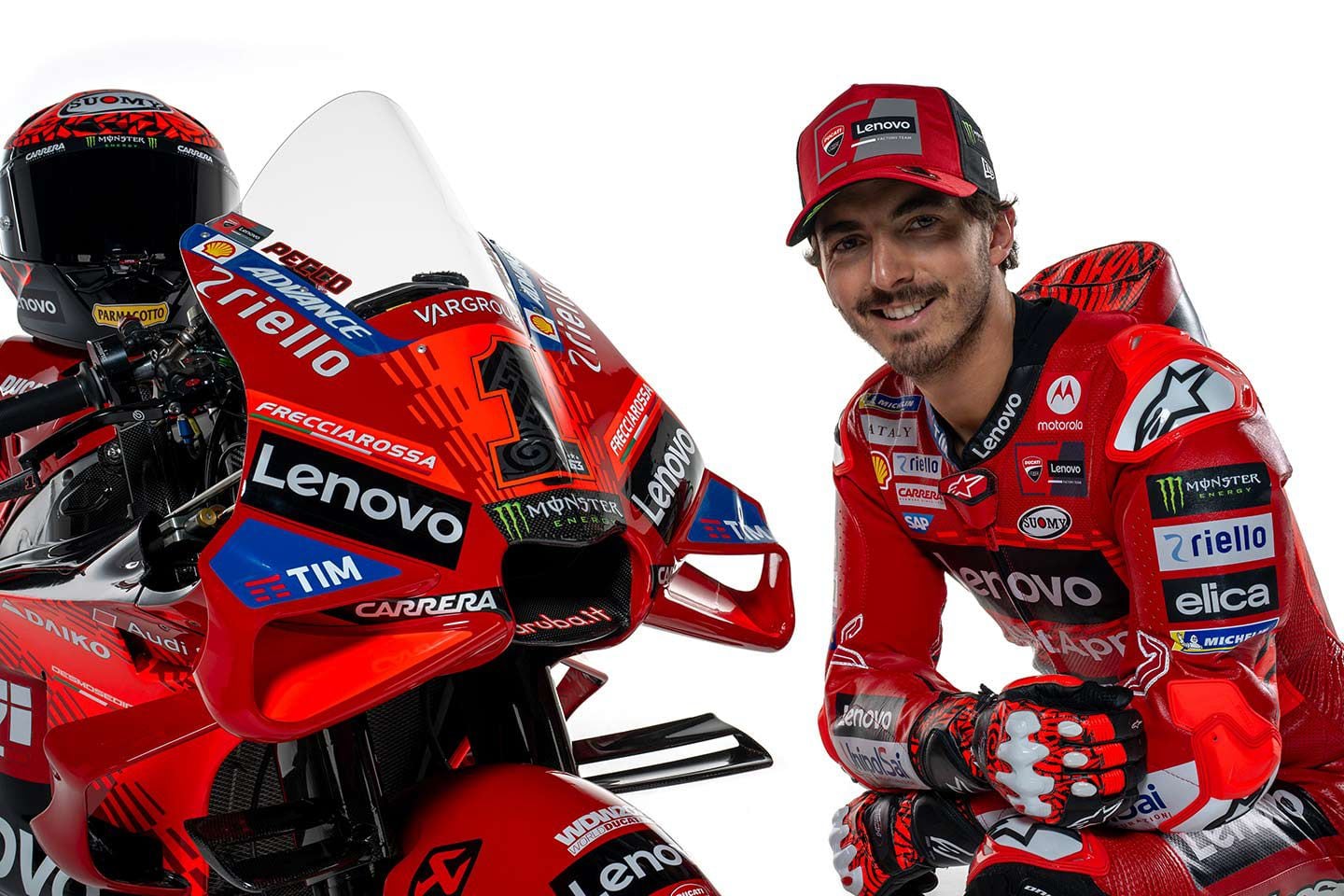
Francesco “Pecco” Bagnaia is ready to go for his third MotoGP championship. (Ducati/)January is a time of team launches, and Ducati did it with style on the mountains of Madonna di Campiglio in Italy. On the stage were six incredible bikes and a total of 17 world titles with the double MotoGP world champion Francesco “Pecco” Bagnaia and Enea Bastianini for the Lenovo MotoGP team. There was also Álvaro Bautista, a double SBK world champion (Aruba Ducati team), and Nicolò Bulega, world SSP champion. And a first for Ducati—the off-road team with nine-time world champion Tony Cairoli and Alessandro Lupino.
It’s a massive lineup that confirms Ducati’s high commitment to winning in motorsports. Under the spotlights was a new off-road program with the launch of the Desmo450 MX—and of course Pecco Bagnaia in MotoGP.
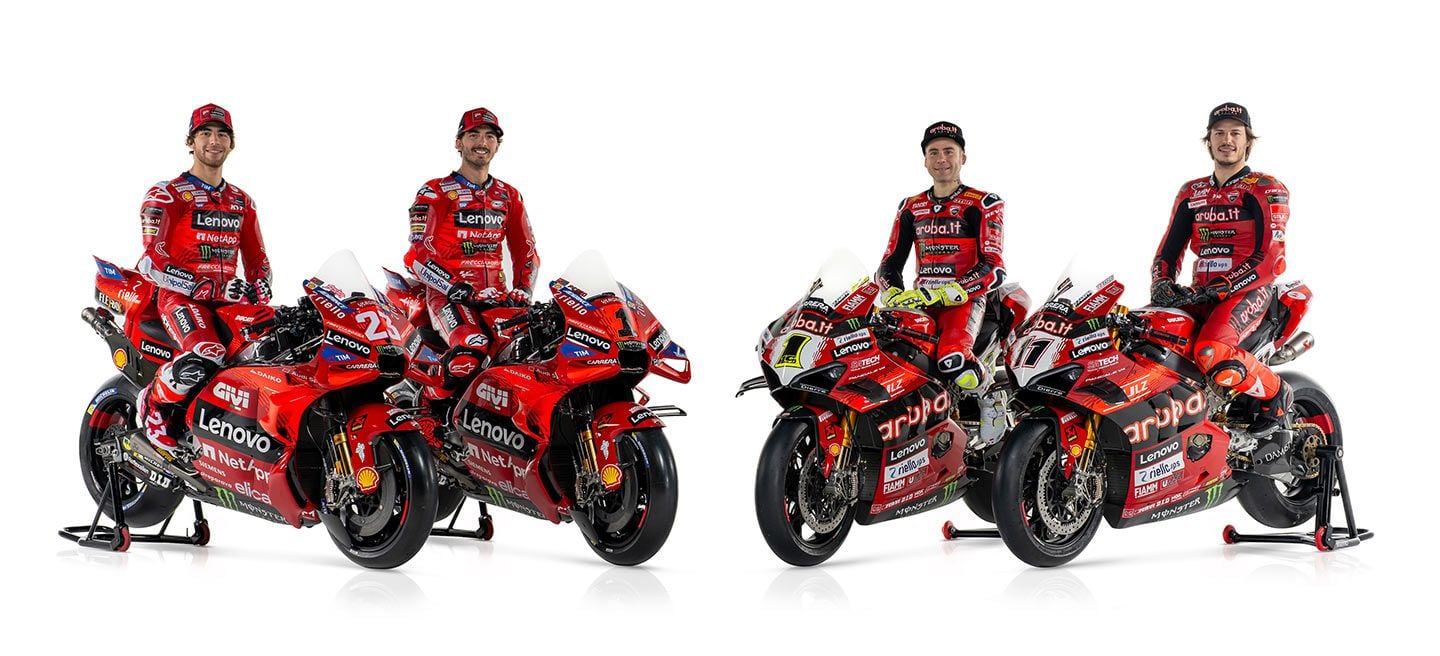
Ducati’s MotoGP and SBK teams. Left to right: Enea Bastianini, Francesco Bagnaia, Álvaro Bautista, and Nicolò Bulega. (Ducati/)With the arrival of Marc Márquez in the Gresini team, the cards could be reshuffled and the current top position of the factory Ducati team could be threatened. 2024 will be the year of truth, but Bagnaia is not worried.
At Madonna di Campiglio for the “Campioni in Pista” event we saw an accomplished two-time world champion: solid, aware, and determined. With his first MotoGP title in 2022, Bagnaia introduced a new age in Ducati Corse, but his second title in 2023 marks the racer’s maturity and the dominance of Ducati’s MotoGP race machines.
Pressed by media questions about Márquez’s threat, Bagnaia answered calmly, never mentioning the Spaniard. The psychological battle has already begun and Pecco has surely learned from one of the greatest of all time, Valentino Rossi. MotoGP 2024 will be exciting and full of drama and we already had a first taste.
Winning is hard, repeating even more. Imagine doing it for the third time. How do you feel?
“I’m very motivated. Every year we start from zero. Looking back, the 2023 season was not easy: I crashed seven times—five in the race. This is something we need to improve. The goal is to be more consistent.”
This year will also be the biggest test for you considering the arrival of Márquez on a Ducati bike. Is Marc your main rival?
“Every season is the year of truth. I know there is a lot of talk, but I live it as a normal season. I don’t see one rider in particular, all the Ducati riders will be competitive. We know what we have done, but I also expect a step forward from Yamaha, Aprilia, KTM, and Honda.”
How do you see Márquez?
“This year he will have the Ducati 2023—definitely a winning bike and more competitive than the one he rode before, so we will see. In my opinion the balance doesn’t change, I think he will be as fast as the rider who preceded him in that team.”
With eight Ducatis on track, the approach will be decisive.
“I am aware that if one works well, the result comes. This awareness gives me confidence. With 22 races and 22 sprints, preparation is also crucial. Last year I was very well prepared, plus we had several weeks off due to race cancellations which helped a lot. This year the calendar is much more compressed.”
What about Jorge Martín?
“We know that he is fast, but as I said I don’t focus only on one rider.”
As the reigning world champion, you will start as the favorite. What mistake could be made?
“Underestimating opponents and situations would be a mistake, but this is not my case. Dedication and ambition are the most powerful fuel.”
In Valencia you tested the 2024 bike and you smiled. How is the new bike?
“The 2023 bike was almost perfect, although there were areas to improve. In particular, we asked for more power. We tried the engine in Valencia, and I really liked it both in terms of top speed and power delivery. I could feel the difference, but the real test bench will be in Sepang for the next testing session.”
Gigi Dall’Igna said that in Sepang you will test a new fairing, which is visibly very different. What can you anticipate?
“Every year Gigi amazes us, we are curious as well, but for sure it will work well.”
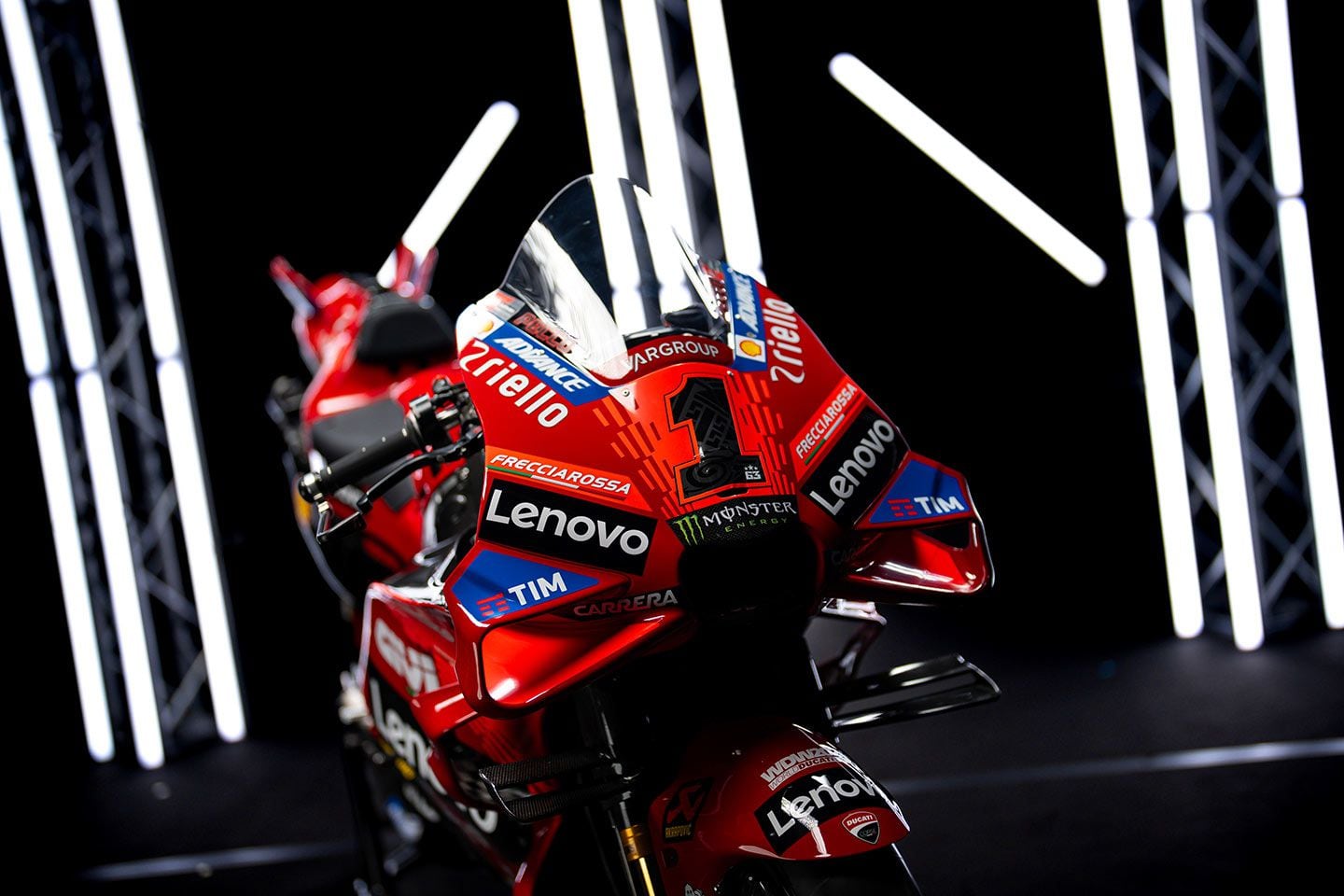
What aero tricks does Gigi Dall’Igna have up his sleeve? (Ducati/)Riders always ask for more power. Last year at Mugello Circuit the top speed of 366 kph (227 mph) was achieved on the straight, and this year some work has been done to ensure maximum safety at the top speed points. Is there a limit on top speed?
“A lot is being done for safety and we are happy with the works made at Mugello at the end of the straight. As for power and top speed, as riders we don’t want to reduce it, on the contrary. Otherwise we would go further with the braking points.” (He smiles.)
Looking ahead. At the end of 2024 many contracts expire. You expressed the desire to continue. The announcement could arrive in Qatar, the first round?
“We are already talking. Of course the interest is from both sides.”
If you could give a title to the 2024 season, what would you call it?
“I like ‘the year of truth.’”
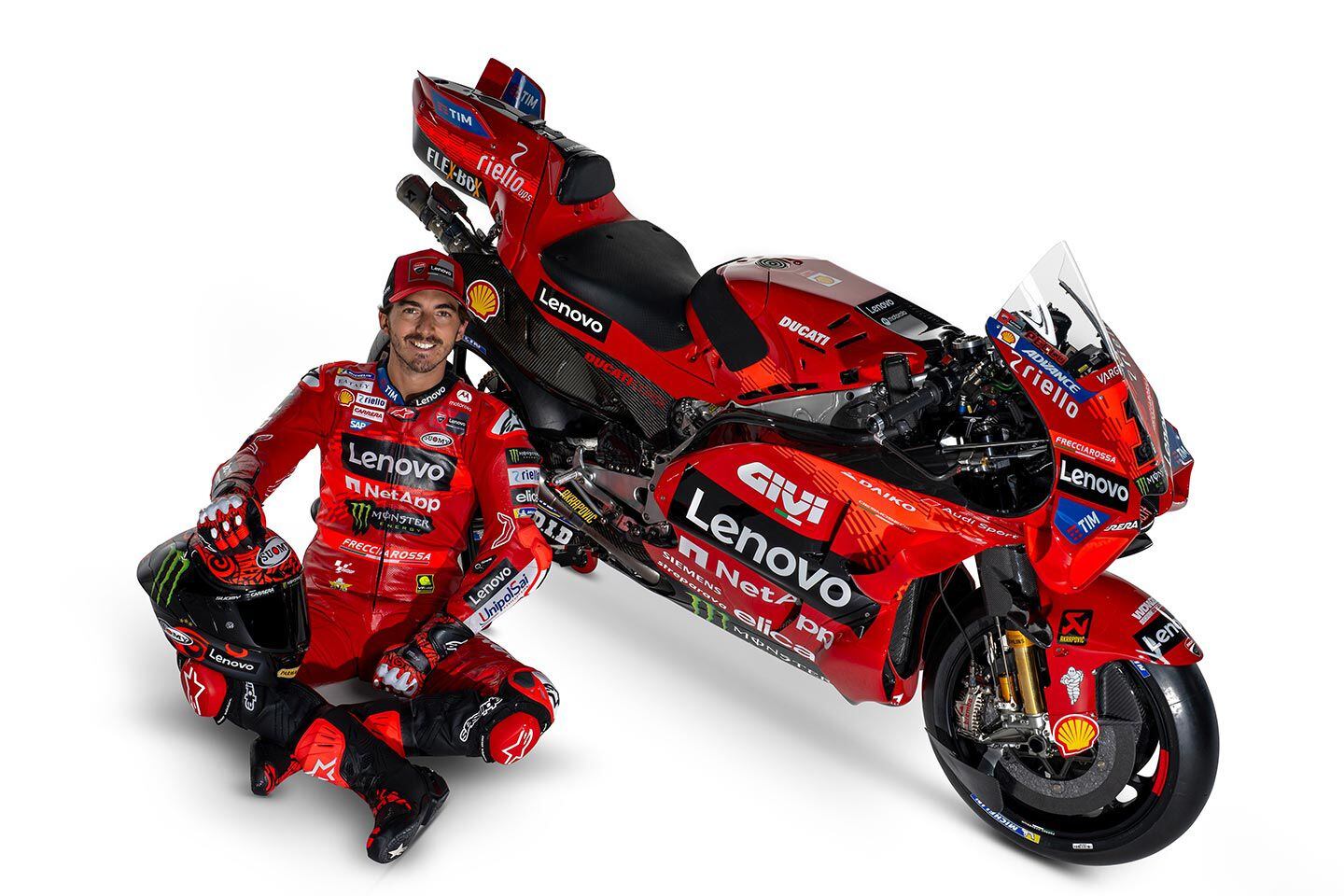
This is “the year of truth” for Pecco as he will be fighting against eight other Ducatis, not to mention the other manufacturers will have mode improvements for 2024. (Ducati/)Finally, what does it mean for you to be in Madonna di Campiglio for the team launch?
“When I was a kid, I always watched ‘Wroom.’ The event saw Ducati and Ferrari doing the team launch here in Campiglio. It’s a dream to be here and I want to thank Ducati and the team partners for doing this event. It’s also a moment where we have fun and enjoy ourselves. The first challenge starts on the snow tomorrow with the skiing competition…” (He smiles, again.)
-
 1
1
-
-
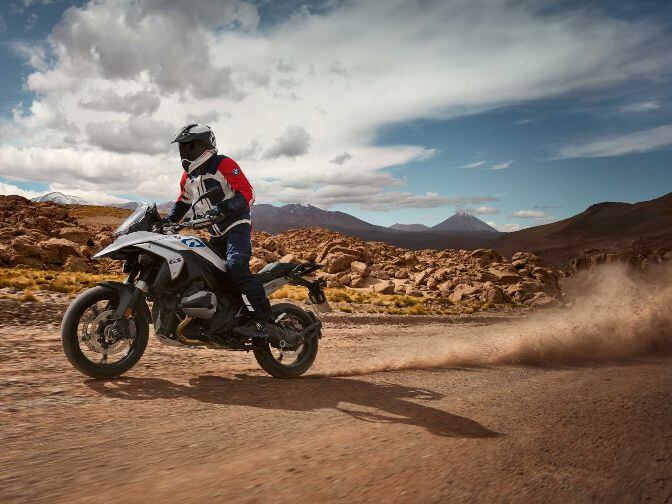
BMW Motorrad crowns its 100th anniversary with the strongest sales result in the company's history. (BMW/)BMW Press Release:
Munich. In its anniversary year, BMW Motorrad delivered 209,257 motorcycles and scooters to customers, 3.1% more than in the previous year and the highest sales volume in the company’s history. The regions of Europe, Asia and Latin America in particular made a significant contribution to BMW Motorrad’s record sales volume with record sales figures. Germany and North America also contributed to the record result with strong sales. The convincing product portfolio with successful offerings that characterise their respective segments and the market launch of popular new models such as the high-powered BMW M 1000 R or the touring enduro icon BMW R 1300 GS were strong arguments for the successful performance in 2023.
Markus Flasch, Head of BMW Motorrad: “I would like to thank our customers all over the world for the great trust they have placed in us again in 2023. With a record result in our anniversary year, BMW Motorrad remains the world’s number one in the premium motorcycle and scooter segment and once again demonstrates the brand’s successful strategic orientation. Our market leadership in numerous segments is based on innovation leadership, our highly attractive product range and our strong brand. Based on these three main success factors, BMW Motorrad is ideally positioned and I am very confident about the year 2024.”
Solid sales in Europe with record growth in Eastern Europe.With 116,012 (+ 4.7 %) motorcycles and scooters sold, Europe as a whole remained by far the strongest sales region for BMW Motorrad. Germany remained the strongest individual market with 24,176 units (+ 0.2 %), followed by France (21,668 units / + 2.1 %), Italy (16,179 units / + 3.3 %) and Spain (12,716 units / + 1.7 %). Eastern Europe also contributed to BMW Motorrad’s very pleasing overall European performance with sales of 6,000 units, a record increase of 105.4 % and more than double the previous year’s figure.
China, India, Brazil and Mexico made a significant contribution to this success.In other regions, several countries ended the year with record sales. In Asia (47,061 units / + 1.6 %), both China (15,832 units / + 2.8 %) and India (8,768 units / + 20.4 %) achieved their best results to date. Brazil, with record sales of 14,106 vehicles (+ 8.1 %), and Mexico (7,088 units / + 6.8 %) also made a significant contribution to BMW Motorrad’s record result.
The R 1250 GS and GS Adventure, along with the highly successful new R 1300 GS, lead the way.The boxer models R 1250 GS and R 1250 GS Adventure also delivered their customary strong performance, with sales of around 56,000 units. Together with the new R 1300 GS (4,528 units), which has been on sale since autumn 2023, the three GS models once again made a significant contribution to BMW Motorrad’s record sales of 60,535 units (+1.62%).
Sporty four-cylinder models with undiminished dynamism.The fascination with performance and riding dynamics also resulted in a positive sales trend for the sporty four-cylinder models from BMW Motorrad. With 11,442 units sold(+ 13.9%), the S 1000 RR underlined its top position and market leadership in the supersport bike segment, while the M 1000 R hyper roadster exceeded all expectations with 3,655 units delivered to customers. Together with the S 1000 R, the S 1000 XR and the exclusive M 1000 RR, 25,194 units (+ 7.5 %) of the high-performance four-cylinder models were delivered to customers worldwide.
BMW Motorrad also achieved top performance in the mid-range segment and in the BMW Motorrad segment of up to 500 cc.With a total of 62,834 units sold (+ 3.2 %), the F series with two-cylinder engines and the G models with single-cylinder engines also made a significant contribution toBMW Motorrad’s record result. The F 750 GS, which is particularly popular with new customers, was a particular highlight, with 11,064 units sold (+ 15.6 %).
Clear market leadership for the CE 04 and strong performance of BMW Motorrad’s Urban Mobility range.With a share of around 70 % in the global market for all-electric motorcycles and scooters with an output of more than 11 kW, the CE 04 has secured itself the undisputed market leadership. With 7,177 units delivered, the expressive electric scooter exceeded the previous year’s deliveries by 44 %. Supplemented by the two successful scootersC 400 GT and C 400 X, the Urban Mobility segment of BMW Motorrad achieved a sales volume of 20,460 units, which corresponds to an increase of 17.9 % compared to the previous year.
Optimistic outlook for 2024.Stephan Reiff, Head of Sales and Brand: “The sales record in our anniversary year is both an honour and an obligation. With numerous new, innovative models and products for our customers, we at BMW Motorrad will do everything in our power to build on this record year in 2024 and further consolidate our leading position in the premium segment. Our new GS models in particular will play an important role here. This year, our customers and fans can once again look forward to numerous world premieres, highlights, events and emotionally charged motorcycles offers.”
-
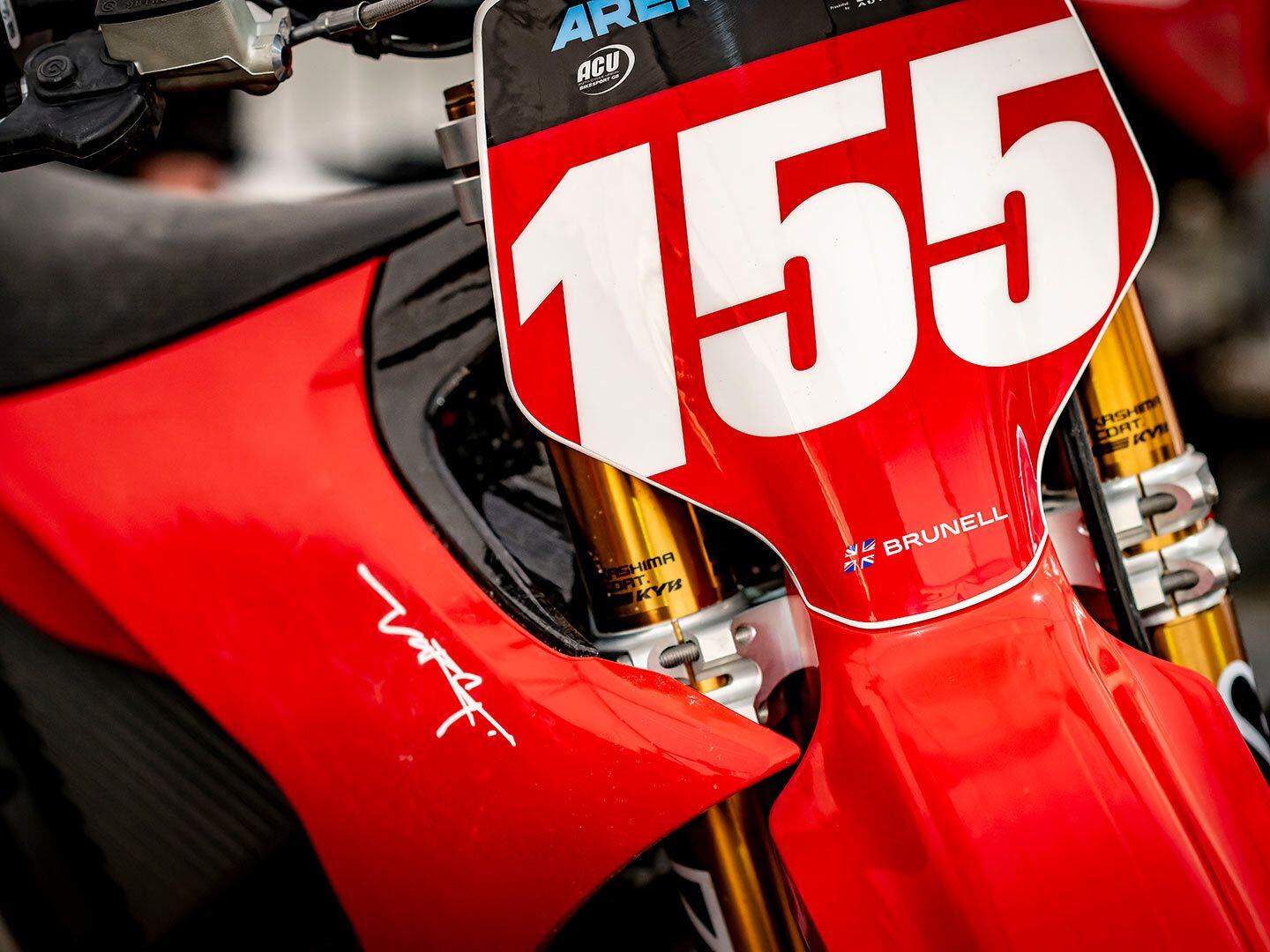
Stark Future Shines Bright in Belfast (Stark Future/)Stark Future Press Release:
The 3rd and 4th rounds of the British Arenacross Championship, in Belfast, proved to be a grueling test of skill and speed on January 19th and 20th. A test passed with flying colors, as all three Stark Future Athletes secured podium finishes over the two nights of racing.
In Friday evening’s event, both Justin Bogle and Jack Brunell started strong, showcasing their potential by qualifying inside the Top 5. Simultaneously, Stark Future Racing’s Eddie Wade found himself in 13th place after finishing the 1st Heat 4th and crashing out in the 2nd.
In Pro Heat 1 and 3, Brunell put in two solid rides, claiming two respectable 3rd-place finishes. Meanwhile, in Pro Heat 2, Bogle gained confidence with further bike time, powering the Stark VARG to his first race win of the series. He followed this up with a 2nd place in Heat 4.
Wade took the long route to the evening’s finals, finding himself back in the head-to-heads. Unfazed by the task at hand, the Brit embraced all the shootouts, qualifying for the Traxxas Pro main event, once again seeing all three Stark Future riders lining up.
The final race did not disappoint, with Wade crossing the line in 8th place. Despite a puncture, Brunell nursed his VARG to a respectable 5th place, but it was Justin Bogle who put in a spirited performance to claim 2nd and secure the first podium of his British Arenacross campaign.
Justin commented, ¨I had a solid week in Spain with the boys. We did some suspension testing. I was feeling better coming into this round. I won a heat race and got on the box tonight. It was a big improvement and that’s all I can really ask for right now. We´ll get better as the season goes on but I am happy with that start!¨
¨I was running up right behind Justin and felt like I could overtake him, said Jack, but I got a puncture so that wasn´t ideal. But I managed to get around the track for 6 laps which were quite impressive with a puncture and finished in 5th´
I managed to win all the head-to-heads and make it through to the final. It was a hectic night but the positive was I got a bit more track time before the main event mentioned Eddie. The goal now is to make it through to the final with just the heat races!´
´Round 4 in Belfast showcased the Stark Future Racing Team’s progression and strength.
The first Pro Heat of the evening brought mixed emotions for Brunell. Despite a strong start and impressive speed, an unforced error in the corner caused him to drop from 2nd to 4th, putting him under pressure for the rest of the night’s races.
In Heat 2, Justin Bogle secured the holeshot and displayed smooth riding throughout. Bogle showcased some impeccable speed through the whoops, claiming his 2nd win of the weekend. Wade had a decent start, securing 5th place.
Heat 3 was an eventful one but saw the VARG back to its winning ways. Despite feeling some pressure after the first heat, Brunell stayed out of trouble and positioned himself perfectly to take the race win, setting himself up nicely for the final.
Bogle secured yet another holeshot in Pro Heat 4 proving that he and his VARG have the starts dialed in. The Oklahoma rider lost the lead however, crossing the finish line in 2nd. Despite appearing somewhat fast and loose earlier in the weekend, Wade settled nicely into his rhythm, finishing in 3rd and securing a spot in the finals.
The Traxxas Pro main event of the evening lived up to expectations. Brunell showcased lightning speed out of the gate, taking yet another holeshot for the team, while Wade also had the start he was anticipating.
The final race however did not go as planned for Bogle. A mistake on the opening lap saw him at the back of the pack. Despite being dead last, he ran at a top pace, executing some incredible passes. It wasn’t all smooth sailing for Brunell, after a near miss on the step-on step-off, the Brit almost lost his line, but with good speed and full focus, he finished in 2nd place, securing back-to-back podiums. Wade closely followed his teammate with a 3rd place, marking his first podium of the campaign. Bogle salvaged some points with a hard-fought 5th-place finish.
´My race didn’t go to plan but I was so pumped and so proud of Eddie. He did an awesome job¨ commented Bogle
Wade commented, ´P3! I got the start and just stayed there. I doubled my way around and just stayed there. I stayed on 2 wheels and that’s all that counts. After this morning I didn’t think I would get a podium but I am ready now and taking it all step by step´
¨I´ll definitely take that position. The track took some victims over the weekend and I didn’t feel comfortable on it¨ mentioned Brunell. ¨I did the same tonight and overjumped the triple but I committed and didn’t jump off. I just held it and saved it. I am happy and ready for the next round. I just want to stay stable and keep going.¨
After Rounds 3 and 4, the Stark Future Racing team remains at the top of the Traxxas Pro class team standings, with Jack Brunell strengthening his hold on the red plate. Their next destination is P& Live in Aberdeen for rounds 5 and 6 scheduled on Friday, the 26th, and Saturday, the 27th of January.
-
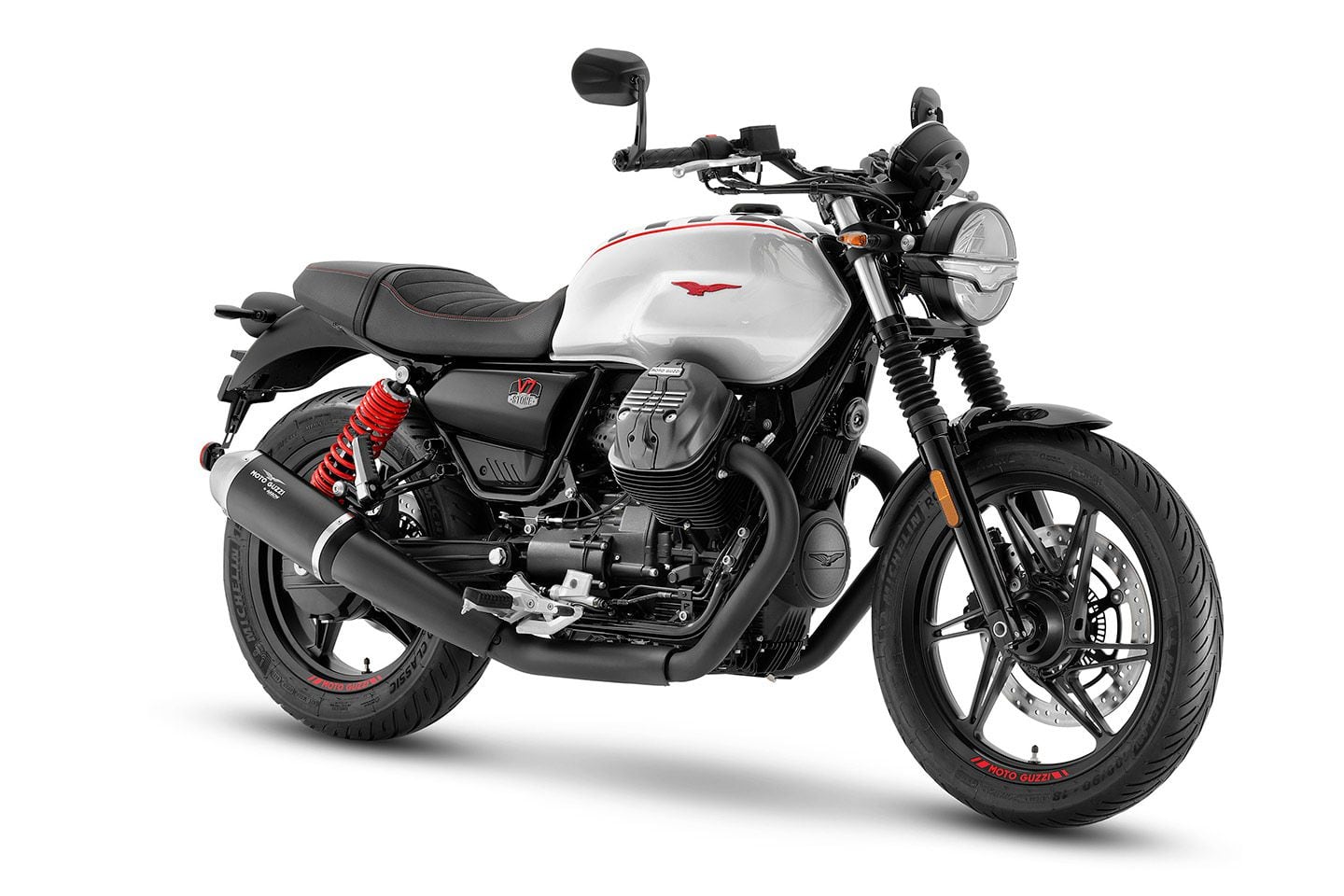
Moto Guzzi’s 2024 V7 Stone Ten celebrates 10 years of its owners group: The Clan. (Moto Guzzi/)Piaggio acquired Moto Guzzi in 2003 and at EICMA 2007 introduced the first model of the new generation, the V7 Classic, powered by the Moto Guzzi small block displacing 744cc that was updated by Piaggio. The bike looked lean, elegant, and classic indeed, thanks to the adoption of a fuel tank that appeared to be transplanted from the legendary Moto Guzzi V7 Sport. The styling and the graphics were highly appealing for the worldwide community of ever faithful Guzzisti, but at 43 real horsepower the performance level was less appealing.
The original V7 Classic, in addition to the very nice styling and graphics, had another strong point, particularly on the local market: a very competitive price. The two factors granted the V7 Classic a small niche on the market that slowly grew through the years along with the evolution of the model and its variations. At that time the V7 and derivatives had conquered a much larger share of the market and in Italy its sales were second only to the Harley-Davidson’s XL883 and 1200.
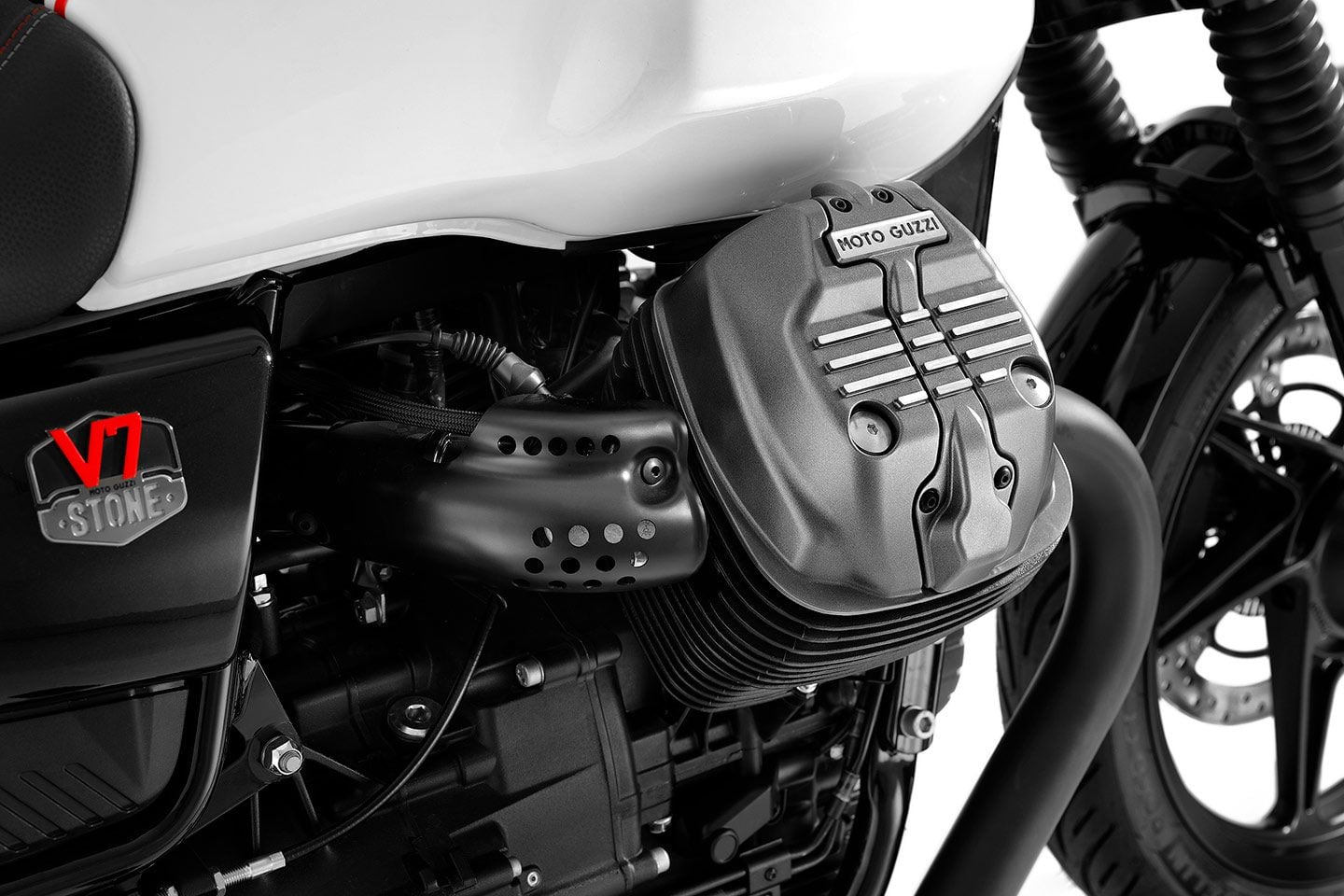
The V7 Stone Ten is powered by Guzzi’s venerable small block engine. (Moto Guzzi/)Moto Guzzi forged forward with the V7 II and V7 III series, giving a harder competition to the Milwaukee small block wonder. The evolution to the hemi head gave that needed boost to the Moto Guzzi small block, in association with the displacement enlarged to 853cc for the V9 version. The V9 models were a bit of a styling flop, but the engine proved solid and in 2021 came the V85 TT revolution. V85 TT was a completely new model developed to respond to the growing success of the adventure class bikes. It fitted very credibly in the medium-displacement class thanks to its solid 80 hp at 7,750 rpm and 59 lb.-ft. of peak torque at a mere 5,000 rpm. The power unit was very competently harnessed in a new chassis that proved very competent both on the road and on the dirt. The Moto Guzzi V85 TT boosted the image of the Moto Guzzi small block V2 and created great expectations among the Guzzisti for a more powerful, sportier version of the V7 tourer.
That came at the end of 2021, when Moto Guzzi released the new V9 unit that is the general-purpose evolution of the V85 TT—less powerful, but more accessible. Smaller valves, smaller throttle body, milder cam timing brought the power down to 65 hp at a very moderate 6,800 rpm with 53.8 lb.-ft. of peak torque at 5,000 rpm, definitely a meaningful improvement over the previous V9 edition.
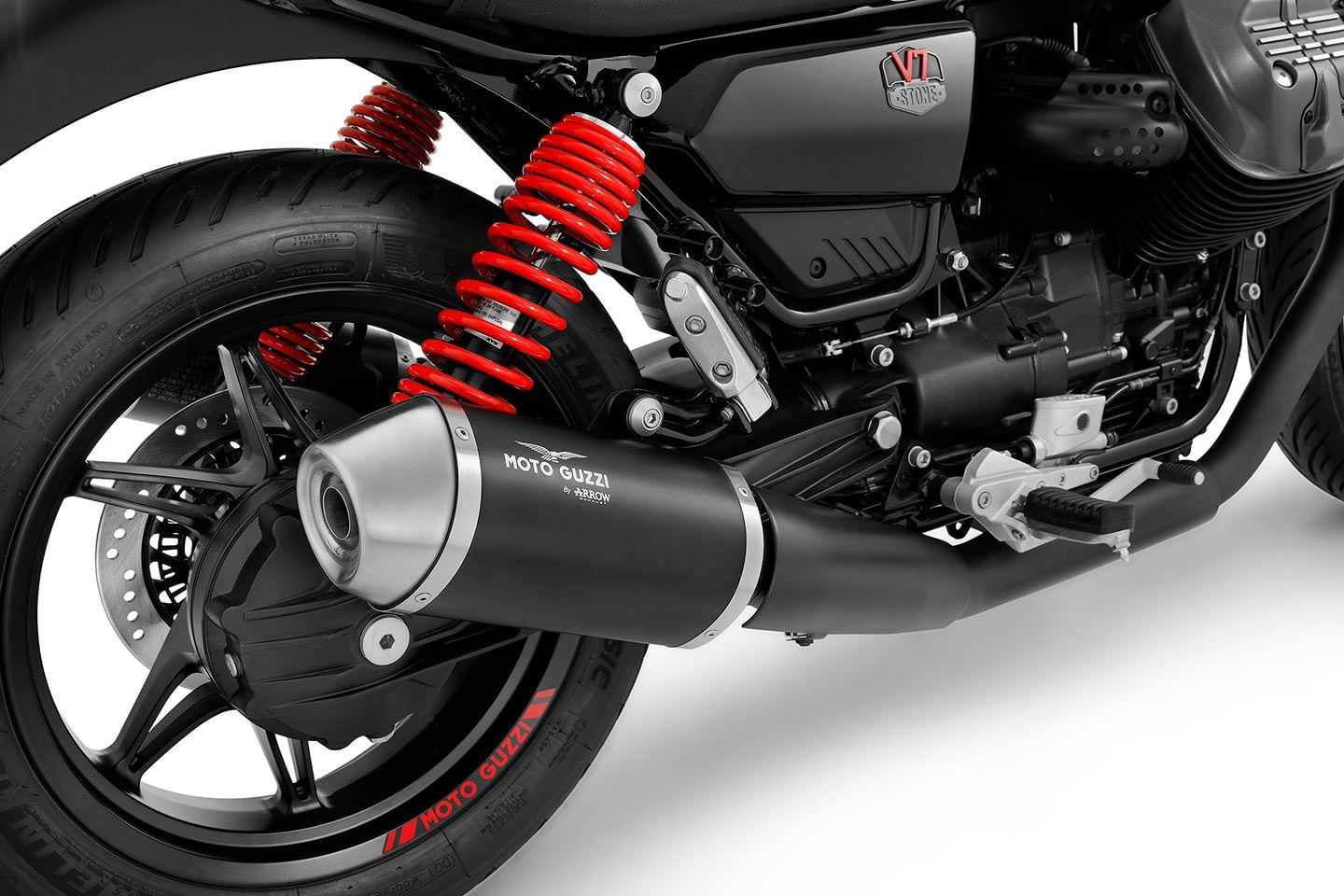
A special Arrow exhaust increases horsepower and torque on the V7 Stone Ten. (Moto Guzzi/)Today the range of Moto Guzzi’s V7 Stone offers a choice of stylish bikes with adequate power for all-around riding pleasure, from town to mountain roads, with a solid but friendly power delivery and traditional Moto Guzzi super-reliability. Harley’s 883 and 1200 are no longer, and the Moto Guzzi V7 is the bestselling 750cc-plus bike in Italy.
To support the Guzzisti brotherhood, and the Moto Guzzi V7 in the process, in 2014 Moto Guzzi created The Clan. This worldwide club has been successful creating a generation of passionate new Guzzisti who have connected, exchanged experiences, planned rallies, and gone on mass trips. Ten years later, The Clan has grown to 50,000 members and Moto Guzzi has created a special edition of the V7 Stone to celebrate the milestone: the 2024 Moto Guzzi V7 Stone Ten.
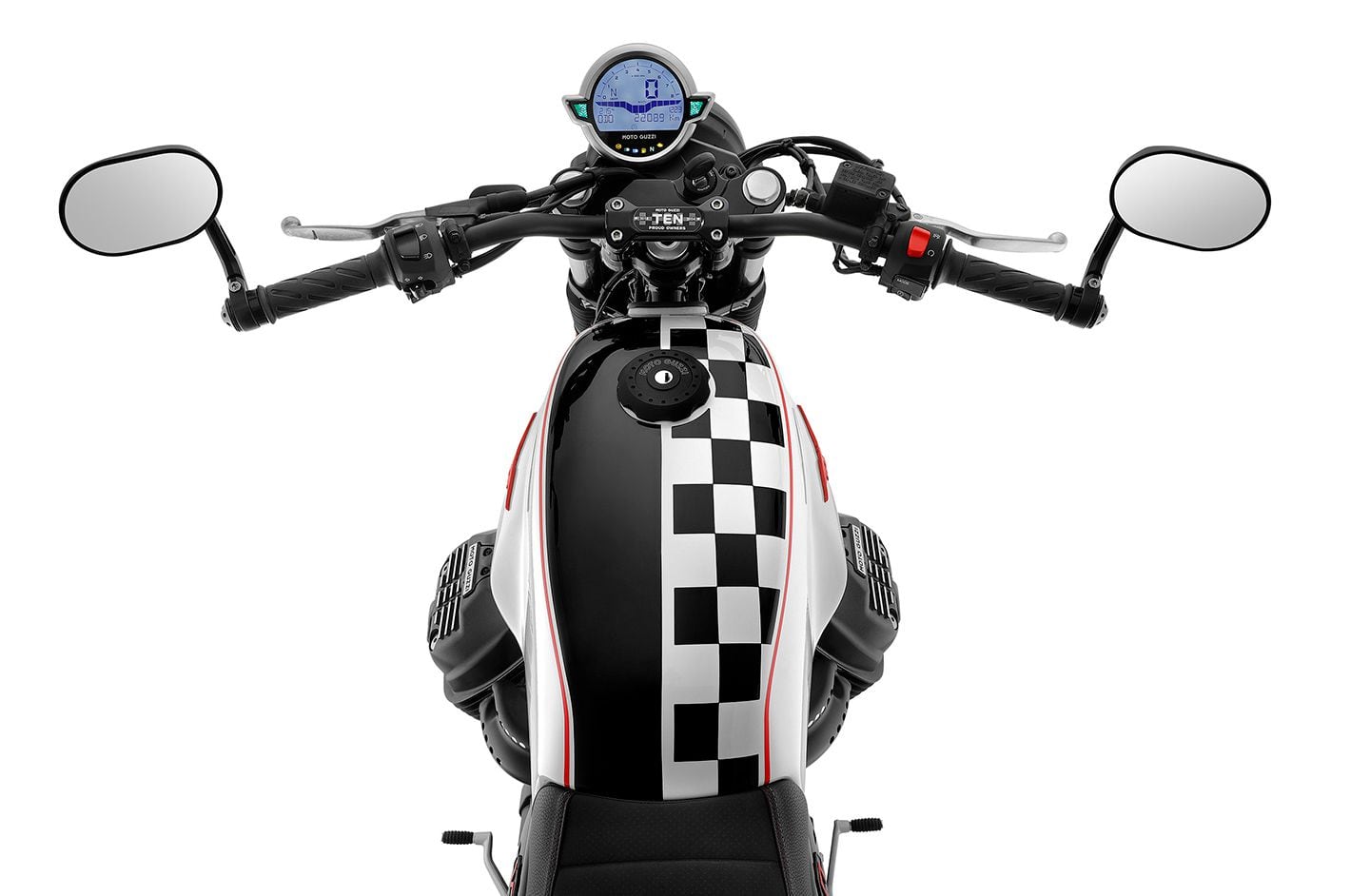
Special paint such as the checkers on the tank set the V7 Stone Ten apart. (Moto Guzzi/)This graphics of the new edition of the V7 Stone possibly is the most elegant and spirited with the top of the tank featuring a longitudinally split treatment with a black-and-white checkered band on the right and a glossy black on the left, the whole surrounded by red pinstriping. The tank sides are painted glossy white, with the Mandello Eagle in red. To underline the sporting spirit of the V7 Stone Ten, the shock absorbers have red coil springs, while the seat trim features contrasting red stitching. To make the V7 Stone Ten even more distinctive, the rearview mirrors are of the bar-end type, for a cleaner front top line. Red Moto Guzzi logo is painted on the wheel rims, while the valve covers are painted graphite gray. Each unit of this very special edition is identified by a plate on the handlebar clamp.
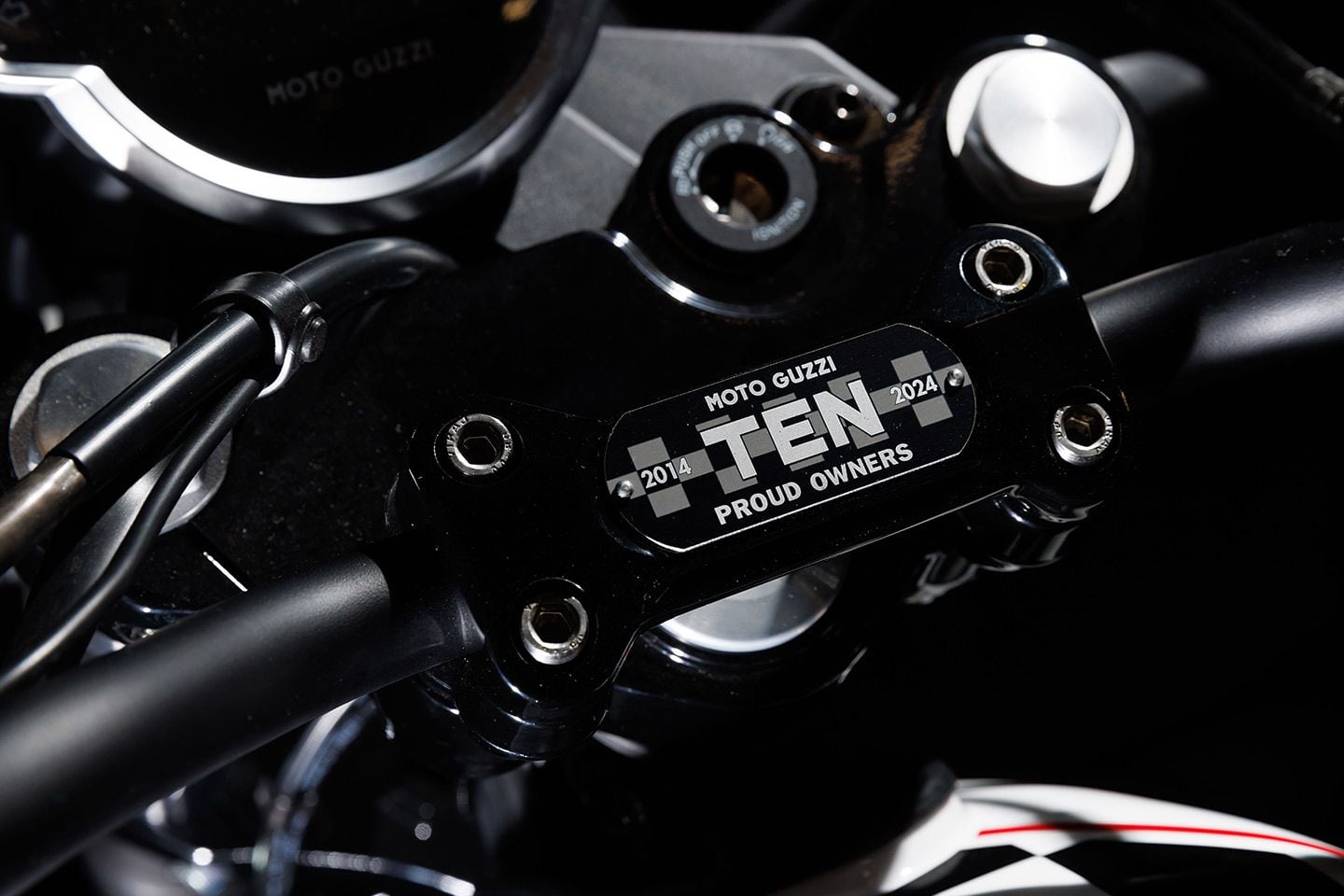
A plate on the handlebar clamp is an unmistakable identifier of the V7 Stone Ten. (Moto Guzzi/)From the technical point of view, the adoption of a special Arrow exhaust system increases peak power to a claimed 66.5 hp at 6,700 rpm and peak torque rises to 55.3 lb.-ft. at 4,900 rpm. It also of course adds a deeper note to the exhaust.
The new Moto Guzzi V7 Stone Ten will be available in the Moto Guzzi dealer network from April 2024 at a price of $9,990 in USA and $12,290 in Canada plus road tax and registration.
-
 1
1
-
-
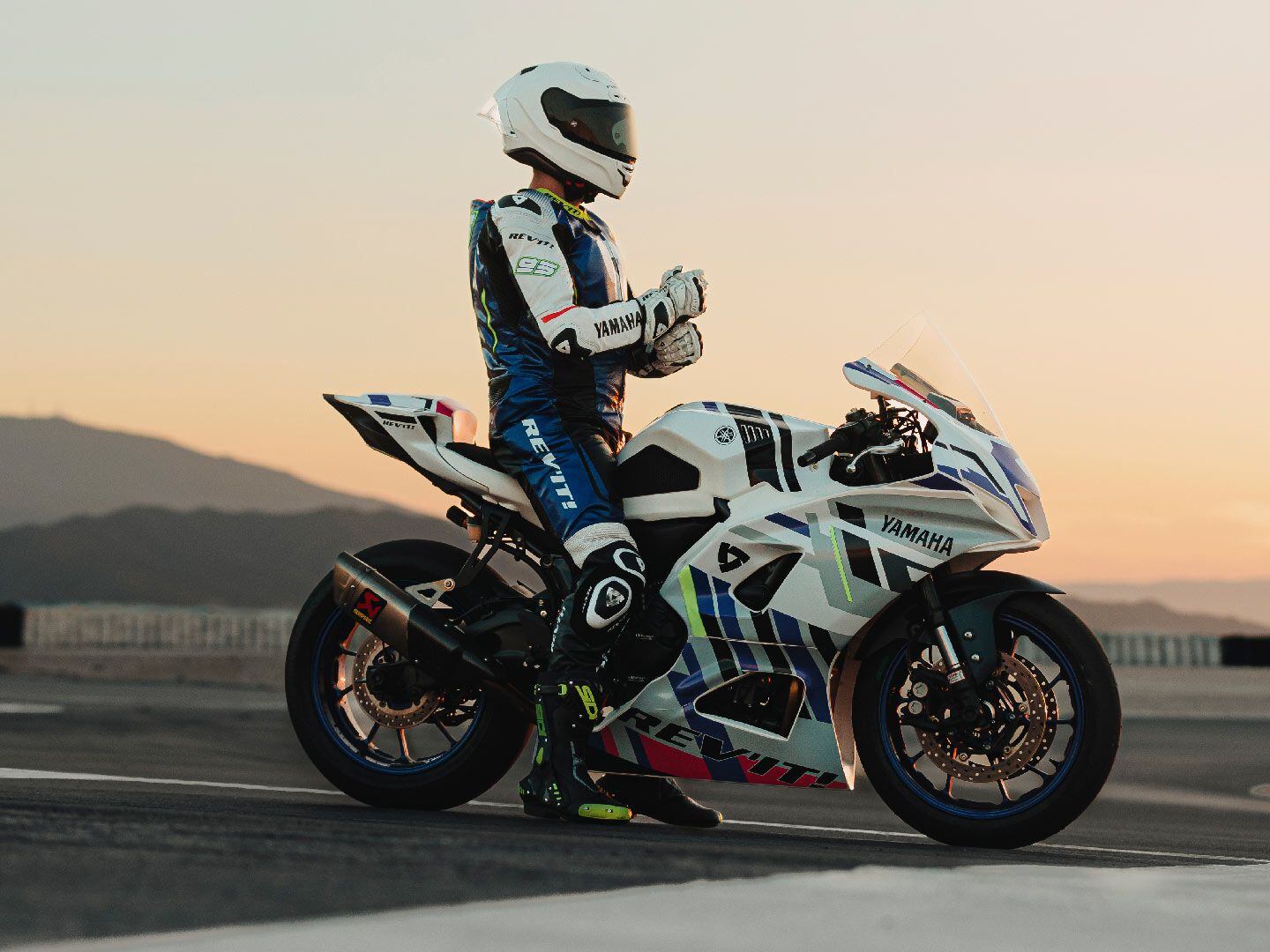
REV'IT! Relaunches Vircos as REV'IT! TAILORTECH (REV'IT!/)REV’IT! Press Release:
Italian custom racing gear specialist, Vircos, will move forward under the new name “REV’IT! TAILORTECH” as of January 2024. This change of name reflects the integration of REV’IT!’s innovative technology and design with the decades of experience, craftsmanship, and service that Vircos has made its name with.
REV’IT! TAILORTECH opens the door to an even wider audience. Providing fully bespoke, track-ready, leather one-piece suits for demanding sportive street riders, amateur track-riding enthusiasts, and budding pro racers alike. So that they, too, can experience the race-ready quality, tailoring craftsmanship, and the same on-point service that REV’IT! offers its professional riders in WorldSBK and MotoGP.
REV’IT! TAILORTECH further allows riders to express their own style with custom measurements and graphics, as well as the assurance riders take to the grid with high-quality fit and professional style, showcasing sponsors and matching bike livery designs. To maintain and even build on maintaining the highest levels possible in safety and service throughout the process, REV’IT! TAILORTECH will start this new chapter from its all-new, state-of-the-art headquarters in Marostica, Italy.
Vircos was originally founded by Aldo De Agnoi as an artisan leather company in 1982, before stepping into the world of producing leather racing suits at the turn of the century. Vircos and REV’IT!’s paths first crossed when the two started working together in GPs over 15 years ago.
A partnership that culminated in REV’IT!’s acquisition of the Italian brand in 2022 and the launch of REV’IT! TAILORTECH in 2024, cementing our new – shared – way forward.
-
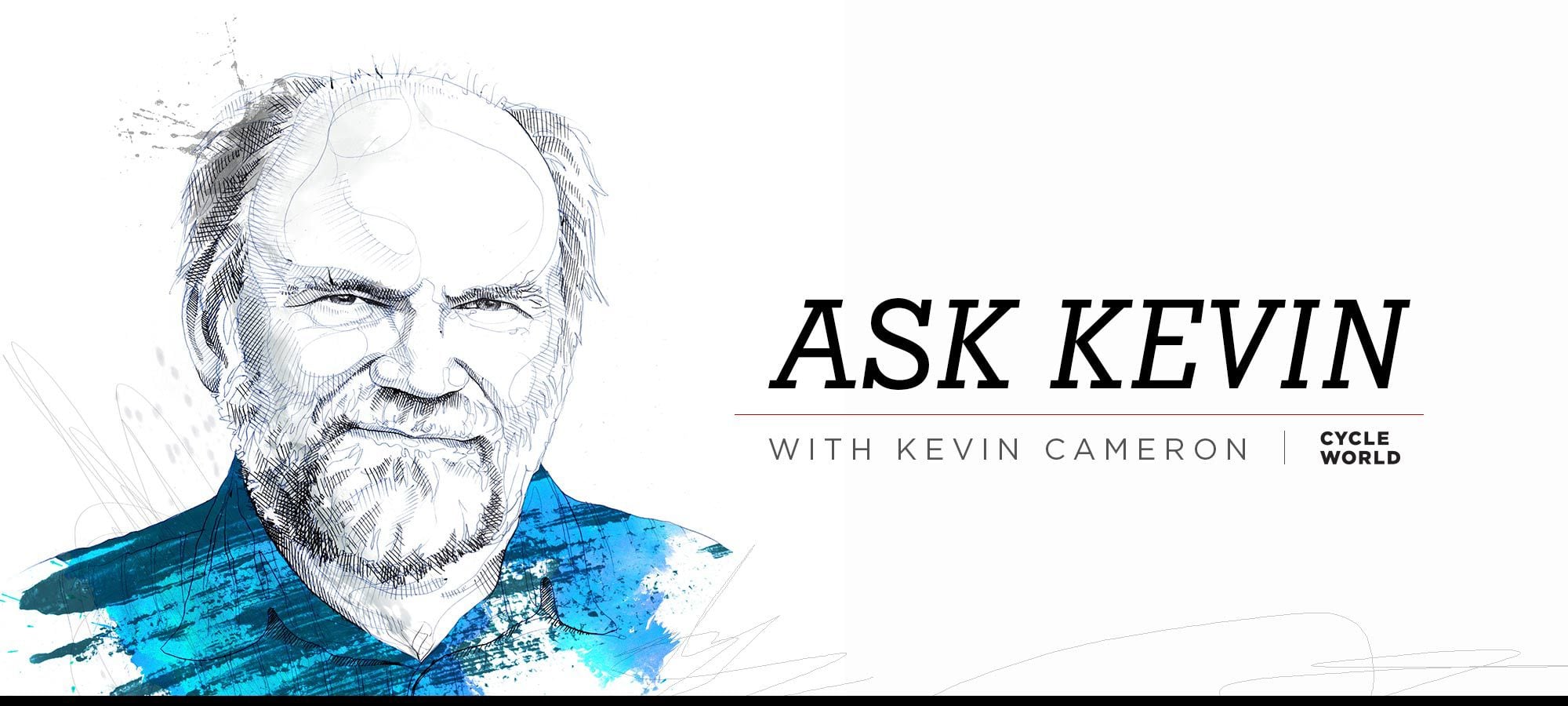
Kevin Cameron has been writing about motorcycles for nearly 50 years, first for <em>Cycle magazine</em> and, since 1992, for <em>Cycle World</em>. (Robert Martin/)Because heat engines are powered by the chemical energy of a fuel, released through combustion, their parts are in varying degrees exposed to high temperatures. This drives the temperature of those parts (piston crowns, exhaust valves, turbine blades, etc.) upward. If nothing limits this process, the parts may rise to temperatures that destroy their function.
Failure of exhaust valves is now rare, but under difficult conditions they may lose pie-shaped pieces of their heads, or break off where the valve stem begins to flare out to form the valve head. Whirling turbine blades slowly elongate via the process of high temperature creep, until they may scrape against nonrotating parts of the engine. Aluminum piston crowns lose strength rapidly at quite moderate temperatures and may sag or be punched through by combustion pressure.
Some form of cooling is therefore necessary to limit the temperature rise of engine parts to levels their materials can tolerate.
Pistons
Pistons must for long periods withstand the gas pressure forces of combustion (rule of thumb: Peak combustion pressure at peak torque can be as high as 100 times the compression ratio) and the often larger inertia forces of the piston’s stopping and starting at top and bottom dead center. Very high-performance 600s of the sportbike era subjected their pistons to peak accelerations as high as 7,000 times the acceleration of gravity (i.e., 7,000 G). At the peak of Formula 1′s V-10 era, peak piston accelerations of 10,000 G were common, and present MotoGP engines are reaching 11,000 G.
The above stresses are large, driving the process of fatigue, in which steady rearrangement of metal atoms under strain can lead over time to crack formation and failure. Fatigue is strongly temperature-dependent, so the hotter the highly stressed parts of a piston operate, the more quickly fatigue progresses to failure. More effective piston cooling slows this process.
Back when nearly all motorcycle engines were air-cooled, pistons were cooled largely by accident:
- By contact with the cooler (you hope!) cylinder wall, especially through the piston rings which have the most intimate contact with the wall.
- By conduction to oil which is naturally flying about inside the crankcase as it is squeezed out of main and con-rod bearings.
- Don’t expect the air in the crankcase to do much piston cooling—oil is about 600 times denser than air!
When liquid-cooling was adopted for most motorcycle engines, pistons gave a sigh of relief because cylinder walls backed by liquid coolant stay at a lower and more constant temperature. They don’t run hotter in summer or cooler in winter.
As engines were pushed to make the annual power increase that has sold us pushovers so many new motorcycles, lighter pistons were needed to reach higher revs without greatly increasing inertia loads on bearings. That meant lighter, thinner pistons containing less metal to conduct heat rapidly to the cylinder wall. The answer has been piston-cooling oil jets, located down at the crankcase mouth and aimed up at the underside of the piston dome. Most production engines have just one jet for each piston, but race engines can have several, or even “many” such jets in the interest of achieving a more uniform piston temperature.
Remember that heat flow is proportional to the temperature difference between the hot object and whatever is cooling it (called “delta-T” by engineers). Vincent designer Phil Irving noted in his autobiography that the rear cylinder of an air-cooled V-twin runs hotter than the front cylinder for this reason.
Cylinder Head
The combustion chamber’s “other half” is the cylinder head, which receives the same heating that the piston does. Yet experimental work has revealed that half of the heat going into the cylinder head enters through the walls of the exhaust port. The reason for this is the high velocity of exhaust gas, which greatly accelerates heat transfer from gas to metal. Some are surprised by this, for the old idea that “The gas goes through there so fast, there’s no time for heat transfer” dies hard. High gas speed accelerates heat transfer because the turbulent and fast-moving heat greatly thins the boundary layer of stagnant gas that has lost energy from frequent collisions with the surface. This, plus the turbulence and speed, assures that every square millimeter of port surface is constantly in contact with fresh hot stuff, as gas that has cooled is so rapidly swept away.
This is why the exhaust ports on modern engines are made as short as possible, and of minimum possible diameter (minimizing its surface area). A cylinder head from one of MV’s “late fours” (the early ‘70s bikes Phil Read rode) was once handed to me: I was delighted to see that it had carefully shaped steel exhaust port liners, insulated from the head material by a 360-degree air gap. Some turbo engines have been designed with insulating ceramic exhaust-port liners.
Not part of the head but closely related is the top few millimeters of the cylinder bore. Exposure to combustion plus the contact of the hot piston at TDC can threaten the oil film on this critical surface (not only does the oil there lose viscosity, it can just plain evaporate). For this reason, designers take special pains to bring coolant as close as possible to it.
Exhaust Valves
Aren’t both intakes and exhausts exposed to hot combustion gas? They are, but exhaust valves receive intense heating from high-velocity combustion gas leaving the cylinder, heating from both sides. High gas speed increases heat transfer.
Because the head of the valve has considerable area it collects the most heat, but fortunately the valve seat on which it typically rests two-thirds of the time is part of the head, which in the present era is usually liquid-cooled. This contact accomplishes most of the necessary valve cooling. If you have worked on engines yourself or have seen them apart, you will have noticed that the width of the exhaust valve’s seating surface is wider than that of the intake. This is to provide plenty of contact area through which valve heat is transmitted to the seat and cylinder head.
In general, bigger valves have bigger problems, made all the worse if the engine is air-cooled (because cylinder-head temperature is higher with air-cooling, there is less temperature difference between the hot valve and its seat, which reduces heat transmission, resulting in higher valve temperature).
Large exhaust valves such as that of a 500cc two-valve single may need more help. In some cases the head and stem of such exhaust valves have been made hollow and two-thirds filled with sodium metal, which melts at just below boiling water temperature. Valve motion causes internal agitation of this liquid, carrying heat from the hot valve head up the valve stem, which is in contact with the cooler valve guide. In the case of Norton’s 1953 500cc factory roadrace bike, the exhaust valve stem was encircled by a spiral passage through which oil from a small cooler was circulated. In some liquid-cooled designs, the middle portion of the exhaust valve guide is directly exposed to engine coolant.
Engine Bearings
Modern engines have plain bearings rather than the heavier and more fatigue-prone rolling element bearings of former times. As the clearances in plain bearings are measured in thousandths, the volume of oil in them is tiny and in operation would therefore rapidly overheat, lose viscosity, and suffer lubrication breakdown were it not being constantly replaced by fresh, cool, and filtered oil from the oil pump.
Valve Train
Valve train friction is a small fraction of engine friction as a whole. Yet the pressure between the cam lobe and tappet is high. As the rotating cam lobe takes up the clearance to the valve tappet and then begins to accelerate the valve up off its seat, the oil film between lobe and tappet must carry the valve’s inertia and the force of the valve spring(s). In modern designs the camshaft is usually made hollow and is kept filled with oil from the pump. Each cam lobe has a drilled hole to keep it and its tappet supplied with oil adequate for both lubrication and cooling.
Eugene Goodman of Velocette discovered in the mid-1920s that pumped circulating oil systems tend to level the temperatures of engine parts. Hot-running parts are cooled and cool-running parts are warmed.
Electric Motors
Electric motors convert electric power to mechanical power efficiently (94 percent or higher) but losses exist and do generate heat—sometimes enough to require active cooling. The way it works is that power in watts (1 hp = 746 watts) equals voltage times current, or V x I. The biggie in electric motor losses is resistive heating, whose familiar example is the glowing wires in any kitchen toaster. Resistive loss is proportional to I, the current, squared, times the electrical resistance, R. This is why electricity is transmitted over long distances at very high voltage—because this reduces the current to low values, greatly reducing resistive loss. This is also why electric vehicles are generally using the highest voltage that the insulation inside their traction motors can safely withstand (400V was normal but 800V systems are beginning to appear).
Some electric motors are even constructed with liquid-cooling lines wound into their coils. Coolant is circulated through a heat exchanger to prevent wire insulation from reaching temperature at which voltage from the vehicle’s power supply may punch through it, creating a short circuit and failure.
Eddy current loss occurs as magnetization reversals occur in iron magnet poles and is proportional to frequency, squared. Internal windage and bearing losses are also present.
Heat is also generated in the variable frequency AC power supplies of electric vehicles, but efficiency has fallen from 90 percent in early days to recent IGBTs at 95 percent and now to the 97 percent of silicon carbide switching devices.
As laptop users know, batteries generate heat during charge/discharge. To prevent shortening of battery cycle life or other disagreeable outcomes from overtemperaturing, battery cooling by air or liquid may be required.
It all comes down to this: Heat accumulating in power system elements raises their temperature. If temperature rise threatens reliable function, some form of cooling will be required to take away waste heat as fast as the system generates it.
-
 2
2
-
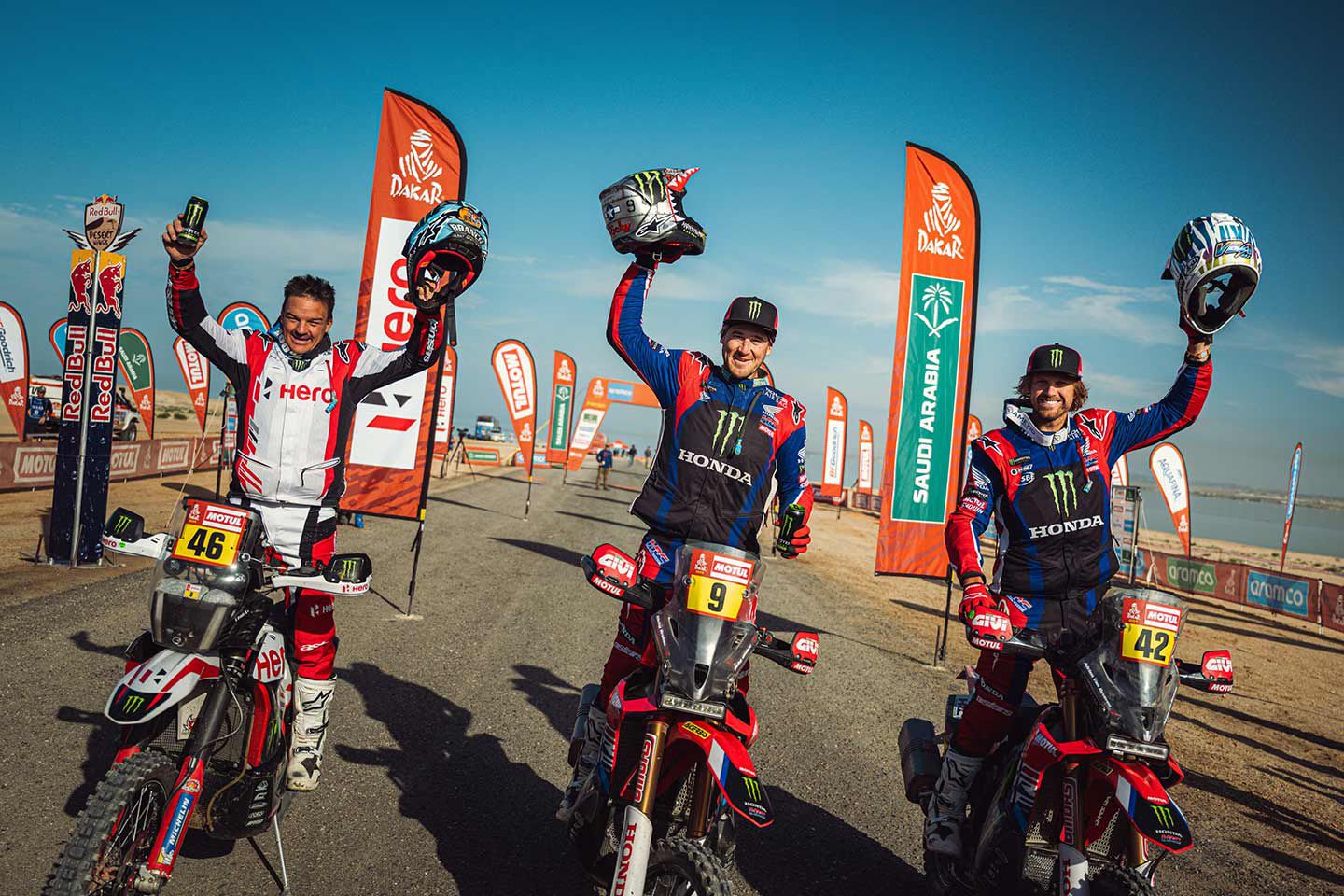
Friends at the end: Ricky Brabec, Ross Branch, and Adrien Van Beveren celebrate the podium of the 2024 Dakar Rally. (MCH Photography/)Ricky Brabec, Ross Branch, and Adrien Van Beveren arrived at the Dakar Rally finish line together—standing up on their bikes, helmets raised to the sky, and big smiles on their faces. Three tough racers who survived the toughest rally in the world—three friends. This is the final postcard of the 2024 Dakar Rally: a very emotional image that embodies the spirit of this amazing sport.
With a 10-minute advantage in the overall standings on the eve of the final rush, Brabec was in full control—but there was one more stage to go: a final sprint of 175 kilometers (109 miles). At the finish of that timed section on the shore of the Red Sea, the Monster Energy Honda rider couldn’t hide his emotions. After a year of training and two tough weeks of racing, the Californian could finally be Ricky Brabec, a 32-year-old boy living his dreams. On his right Ross Branch, the Botswanan from Hero Motorsports who did not make it easy on Brabec till the very last stage. He gave it his all and arrived 10 minutes, 53 seconds back—after two weeks of racing. Third was Frenchman Van Beveren of the Monster Energy Honda squad, 12 minutes, 25 seconds behind the winner.
For Monster Energy Honda, Dakar was a great success: two riders on the podium, and if it was not for Nacho Cornejo’s suffering technical problems (the fuel pump) on the last two stages, it might have been an historical triple podium.
Ricky Brabec: Double Dakar Winner
Winning is difficult, repeating is even harder. How do you feel?
“I’m really happy to be here, it’s difficult to describe this feeling with words. The first win in 2020 was special as every first time. I was also the first American to make it. We had a bigger advantage (in 2020), while this time it was a tight duel till the end between me and Ross [Branch] but also my teammates Nacho [Cornejo] and Adrien [Van Beveren].”
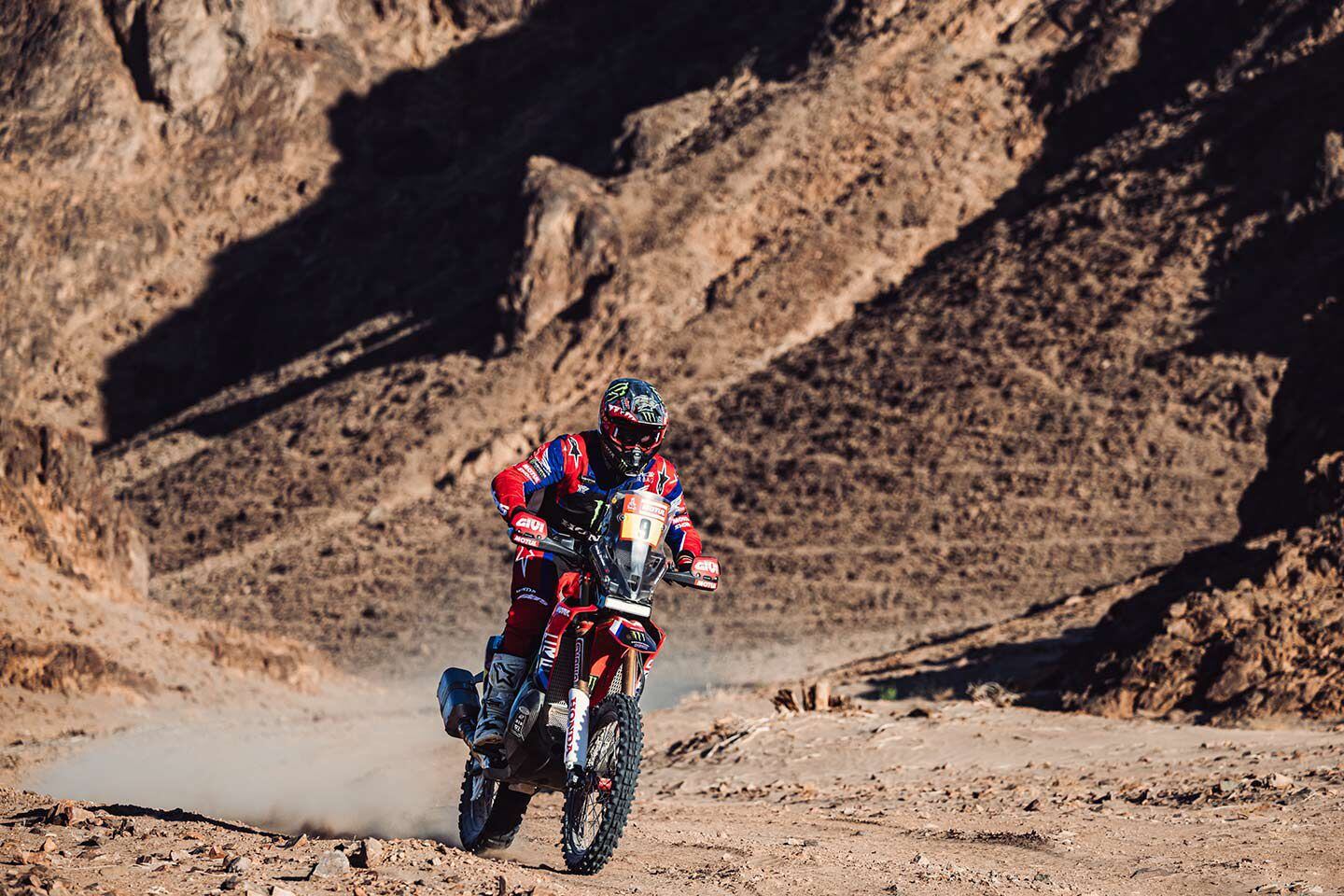
Brabec maintained his lead on the last day of the Dakar, winning his second overall title. (MCH Photography/)I guess it was very emotional crossing the finish line?
“The last 10 kilometers [6 miles] gave me a chill the whole time. I was really happy—I made it to the finish line. It was emotional. My body was shaking. I haven’t been nervous these last few days, I knew I had to hold myself together because the final sprint would not have been easy. You need to finish the race before celebrating.”
What was your first thought?
“I thought about all the hard work I have done to arrive here. This victory is dedicated to myself and then the whole team and my mechanic Carlos. He has done countless Dakars, and has helped me a lot with his huge experience. So this victory is also dedicated to him.”
You won in style, surrounded by friends.
“It’s true. This is the Dakar family. With Ross, we had an incredible duel. I’m happy for my teammate Adrien. It would have been great to have Nacho too.”
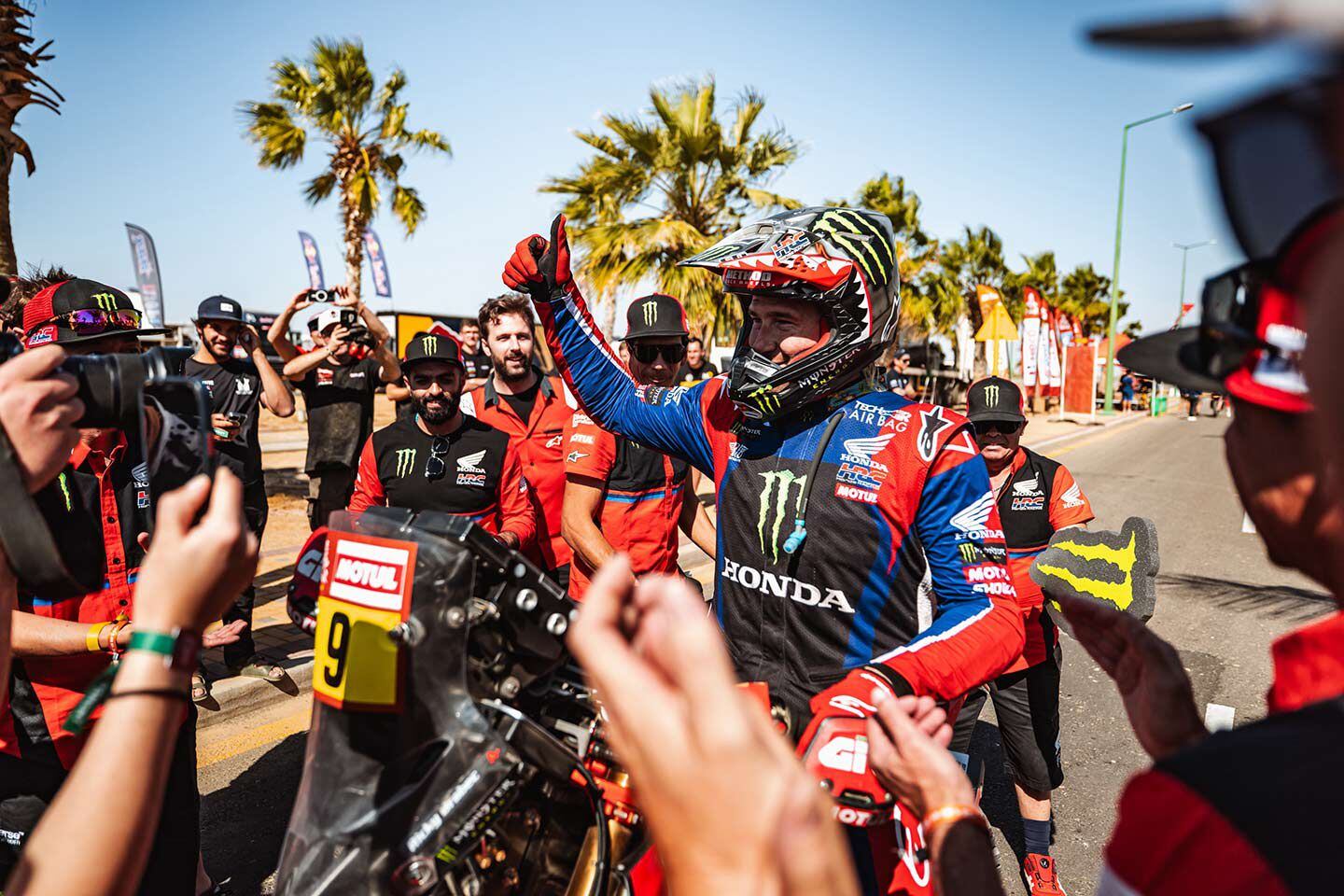
Brabec will add another Tuareg trophy to his growing collection. (MCH Photography/)Where will you put the Tuareg?
“Next to my other two: the victory in 2020 and the second place. They are next to the TV so it’s the first thing I see in the morning when I wake up.”
What will you do once back home?
“I don’t know, I haven’t had the time to think about that. I don’t have any plans. Maybe just go out riding dirt bikes!”
Ross Branch: A Winner Nonetheless
Hero Motorsports versus Honda HRC is very much David versus Goliath. Branch won two stages and led for four. Regardless of his runner-up result, he won fans with his speed, consistency, and a unique and contagious positive attitude.
How do you feel?
“I’m really happy. It’s one of the best days of my life! We worked hard, this rally. It was tough and we had some challenges along the way. We led, we won some stages, but all in all Ricky was better than me, and I can only show my respect for Ricky. He deserved to win. Now I know what I have to work on once back home for the next 11 months. The Hero team is amazing and I’m happy to give them a good result.”
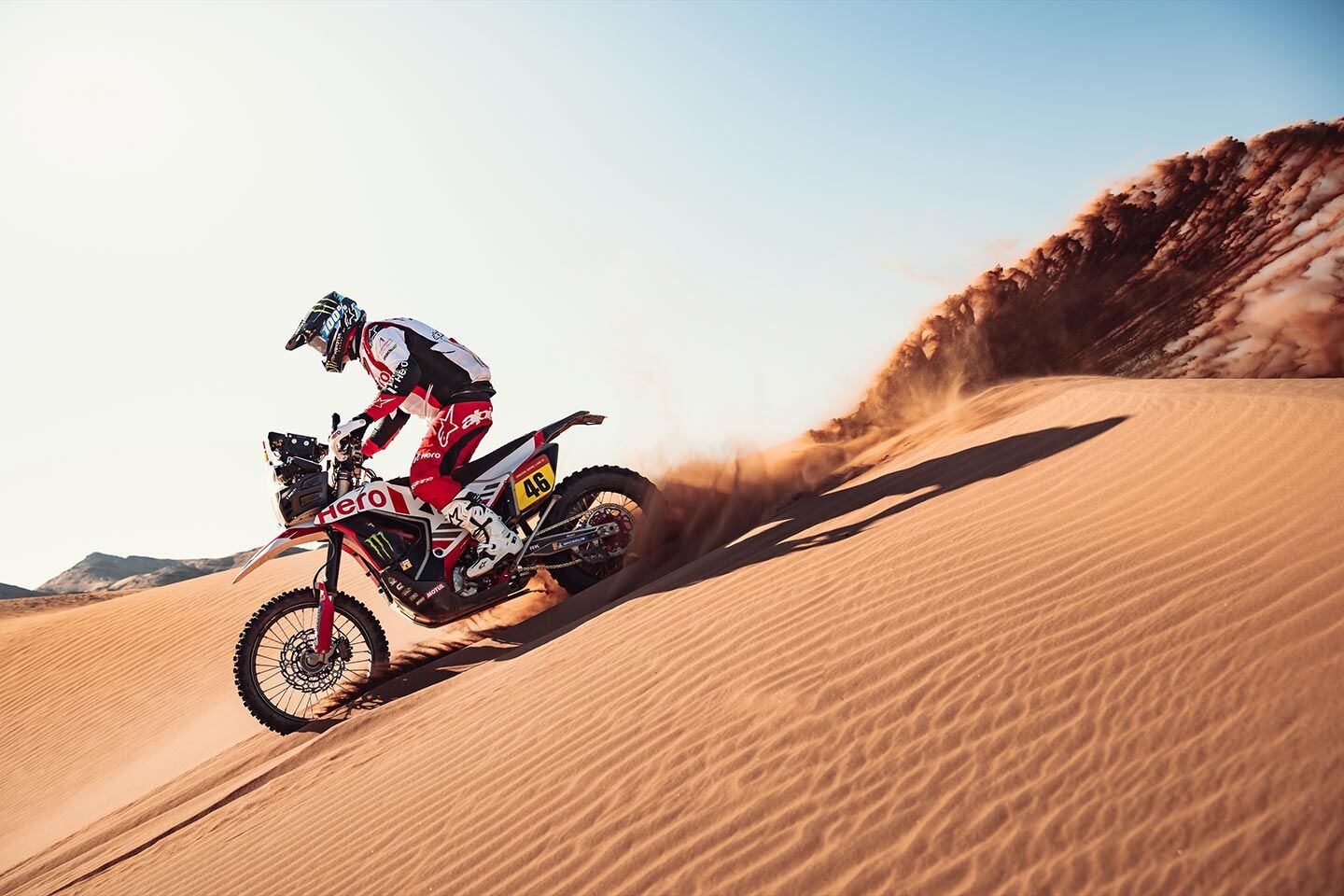
Branch finished second overall, gaining fans with his underdog performance. (MCH Photography/)Now what is the challenge?
“The challenge is to better myself and come back stronger next year.”
Where did you struggle the most?
“I think I lacked a bit of self-confidence in the camel grass and some self-confidence in the navigation. I will work on that.”
Is there anything you regret?
“Nothing at all. I tried hard.”
What a podium finish among friends!
“Yes, it was great to be there with Ricky and Adrien. We are friends. Actually the whole bivouac is a family. We race each other very hard, but we are super friends. My thoughts also to my teammates, hopefully we are all together at the Abu Dhabi Desert Challenge.”
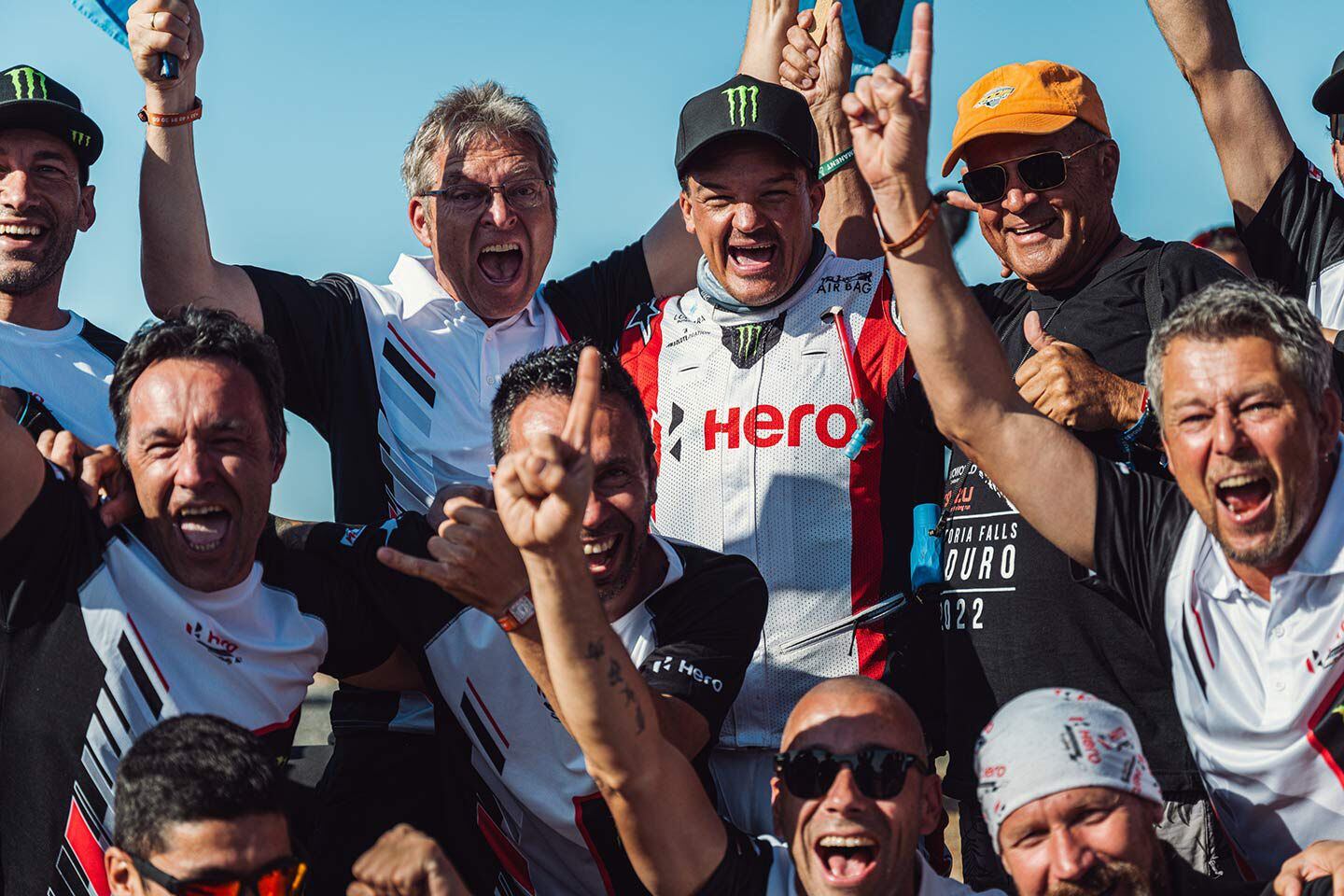
Branch fought to the end as the lone Hero Motorsports rider left in the rally. (MCH Photography/)Adrien Van Beveren: A Well-Deserved Podium
Adrien Van Beveren has finally secured his first podium finish of his Dakar career after two finishes just outside the top three.
How do you feel?
“After the last years and the difficulties I had—the crashes, all of that—overall, to be on the podium, finally, on the podium of the Dakar, it tastes really good. I’ve been fighting until the end. We finished third, but we were in the fight for victory. We are closer than ever to the dream. To step onto the podium is a step toward my dream of victory.”
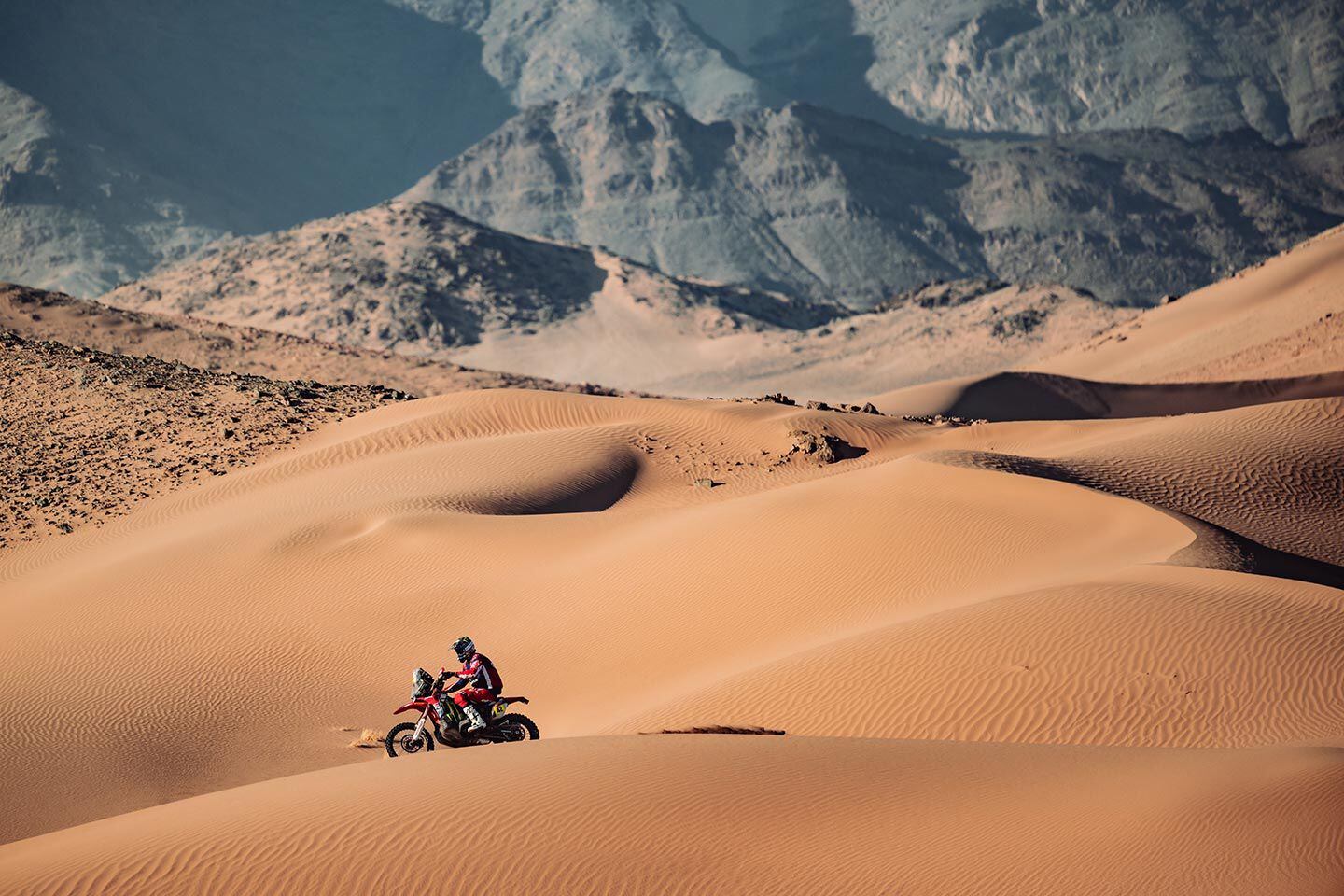
Van Beveren's podium finish at Dakar 2024 puts him one step closer to his goal of winning the overall in the future. (MCH Photography/)Do you have some regrets?
“I have no regrets, I gave it my all at every moment. It feels good to be on the podium. I fought for it right to the end, and that’s what I’m going to keep in mind so that I can continue to live my dream. I just realized—I was in Ricky’s dust right up to the end. I have to appreciate this moment. It’s been years of hard work—of questioning myself especially after big incidents.
“Nothing to regret. I train hard; I try to be better every day, to keep my dream alive. It’s not a free third place, I fought hard and went for it.”
How do you feel with the new Honda bike?
“This Honda really gives me a lot of confidence; I’m capable of winning on any type of terrain, even in rocky terrain. I’m proud of my work and I want to thank the Japanese for all their support. Even after Morocco, they made further adjustments to meet my requests. We are a great team!”
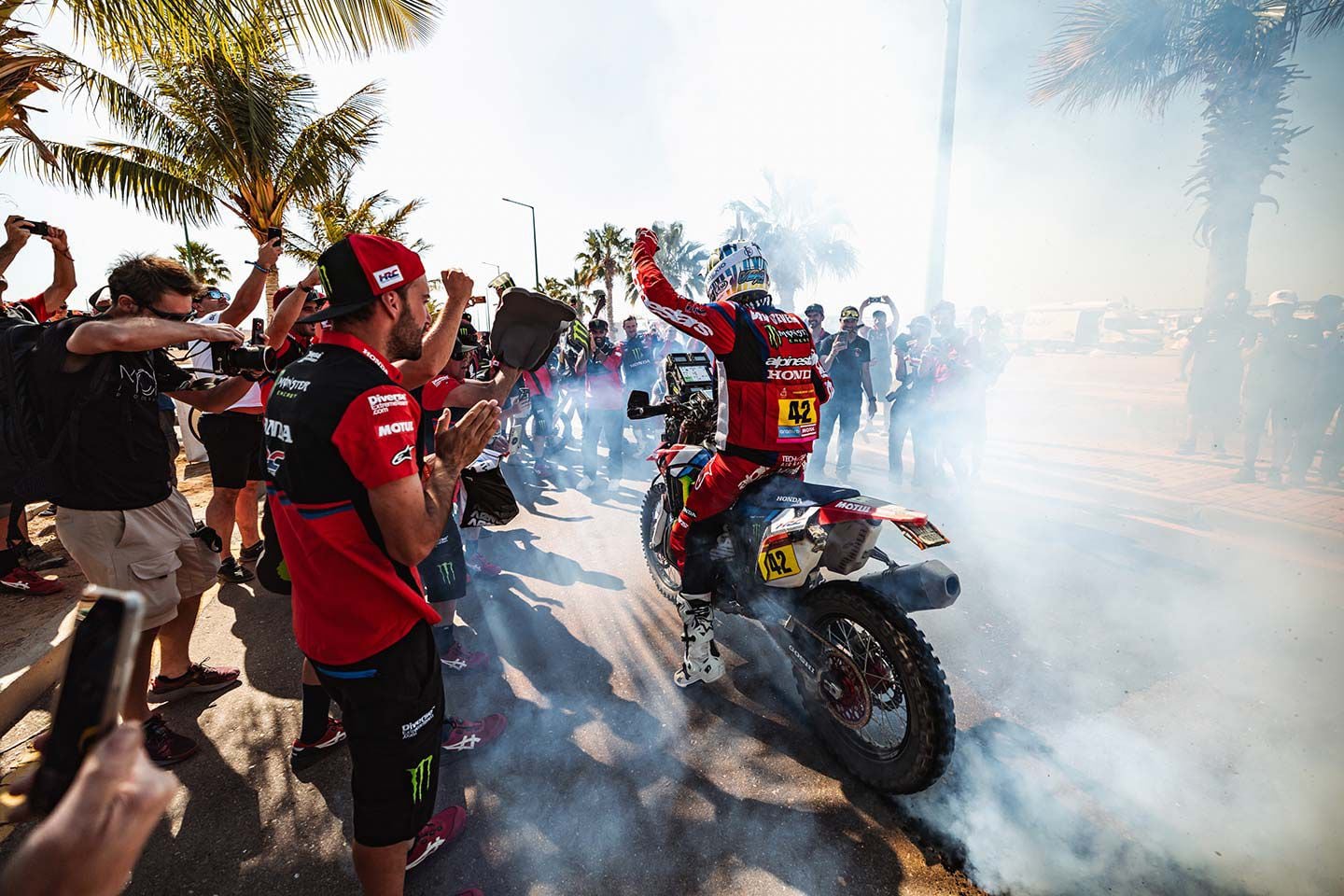
Van Beveren celebrates with some tire smoke at the finish of the Dakar Rally 2024. (MCH Photography/)The end of a Dakar is always emotional.
“Being here is huge. It was necessary to take this step to perhaps climb the last two steps. Looking back I can say it gave me a good mark. I feel I did very well, but I was not the best strategically. I opened 7, the most complicated to open, where the first 50 kilometers [31 miles] were hell.
-
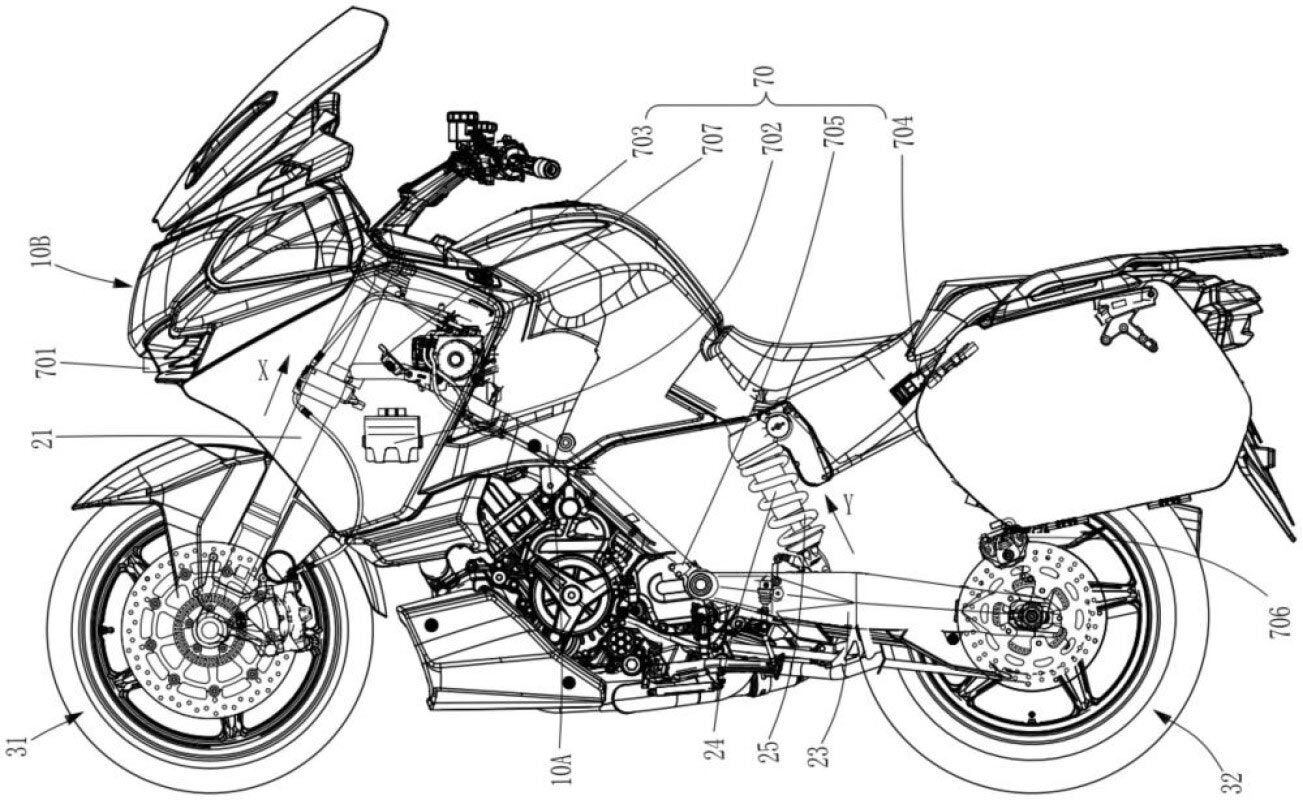
CFMoto is working on a new semi-active suspension system that utilizes a camera to add additional information to the computer for interpreting road conditions. (CFMoto/)Electronically adjustable semi-active suspension is rapidly becoming a must-have feature for any motorcycle that’s targeting the higher end of the touring, adventure, and even sportbike markets. Now CFMoto aspires to make an even more advanced version of the system that scans the road ahead and adjusts the suspension before you even get to a bump.
A newly published patent application, first filed back in 2022 but only made public now, explains how the company intends to use a front-facing camera to feed images of the road to a computer that can interpret them and adjust the suspension to suit, all in a fraction of a second. It’s an idea that’s already being used in cars. Mercedes first introduced a camera-based road-scanning system a decade ago with its “Magic Body Control” and “Road Surface Scan” features on high-end models, and as early as the 1980s Nissan offered a sonar-based adaptive suspension that used an ultrasonic sensor under a car’s nose to sense bumps or dips before the wheels reached them. On motorcycles, however, the semi-active suspension systems offered today tend to use stroke sensors in the suspension itself to monitor the distance and speed of suspension movements, feeding back to a computer that adjusts the damper settings to suit in real time.
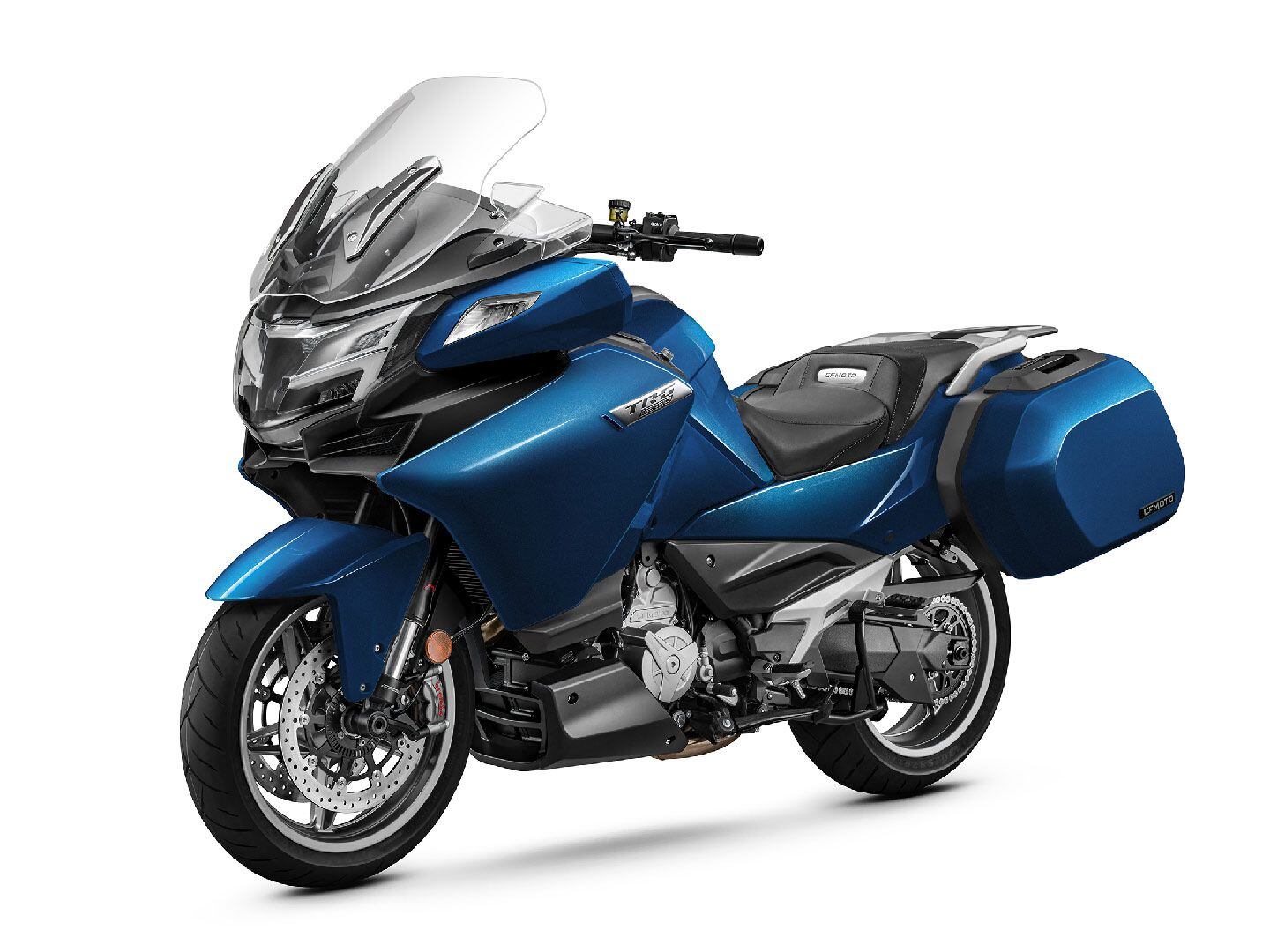
CFMoto’s 1250 TR-G is a Chinese-market touring model powered by KTM-derived 1,279cc V-twin. (CFMoto/)The new patent illustrates the active suspension setup on CFMoto’s range-topping, Chinese-market 1250 TR-G. Made in small numbers and mainly used by police, the 1250 TR-G is already something of a technological tour de force. Under its BMW-like styling lies a 1,279cc V-twin that CFMoto has developed as an evolution of the KTM LC8 engine. CFMoto and KTM are partners, with a joint venture in China to build KTM engines and complete bikes, with CFMoto borrowing the Austrian company’s engine designs for its 800 MT and 800 NK models as well as the 1250 TR-G. The existing version of the bike also has the biggest TFT instrument panel yet seen on a bike, coming in at 12.3 inches, with features including keyless start, tire-pressure monitoring, and built-in navigation. The bike already has a built-in radar system too.
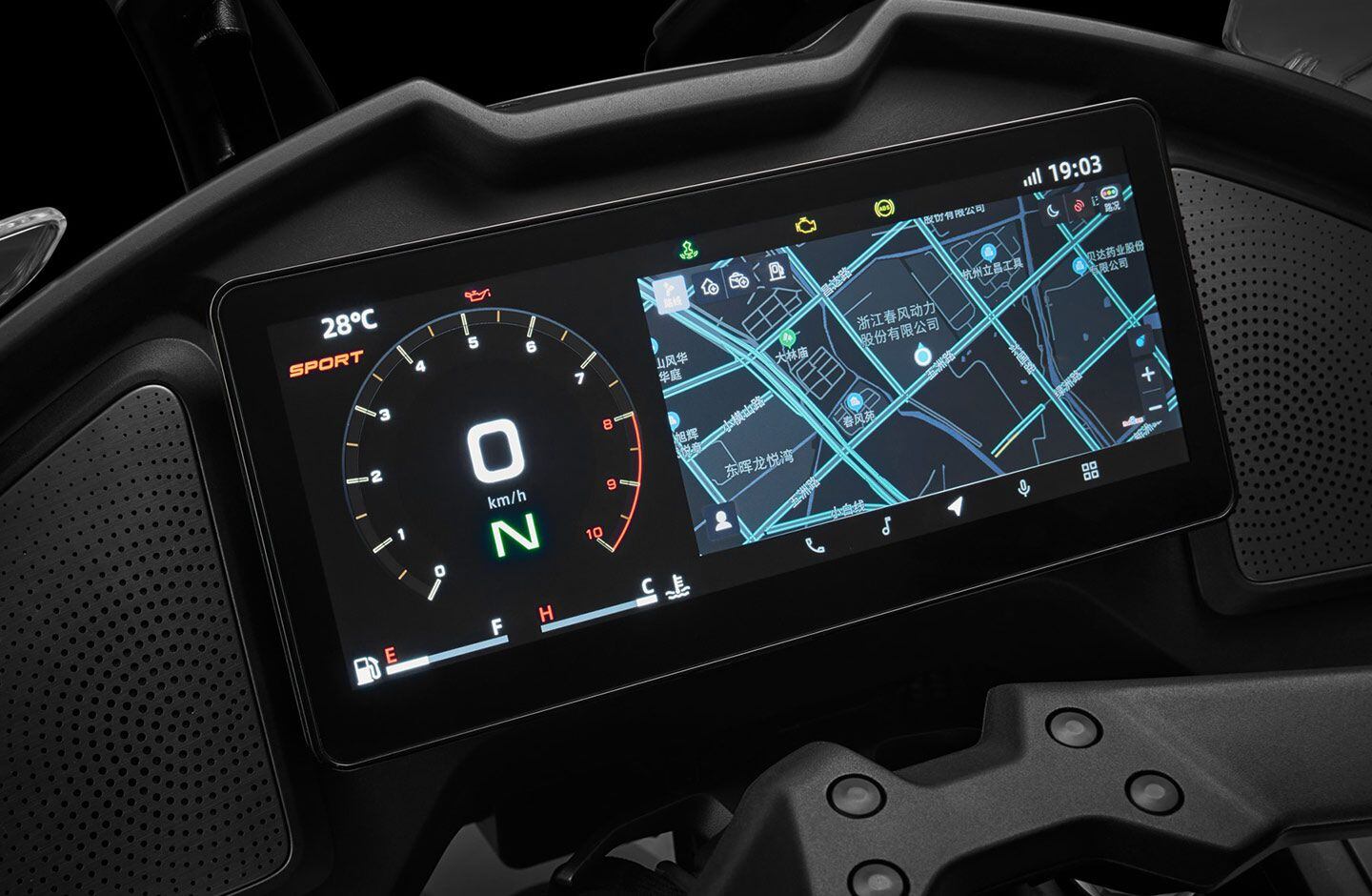
The 1250 TR-G utilizes the largest TFT dash in production. (CFMoto/)Although originally announced with WP semi-active suspension, as used on some KTMs, the current production TR-G uses non-active Marzocchi parts, having been mildly revised since it was first launched in 2020. But active suspension is clearly in the cards, as evidenced by the latest patent. The document explains that the planned system has “a shock absorber control system, which includes a camera” and goes on to say “the camera is used to capture the road surface information in front of the motorcycle and can transmit the information to the shock absorber controller.” Finally, it says: “The information controls the front and rear shock absorbers to adjust their respective shock damping.”
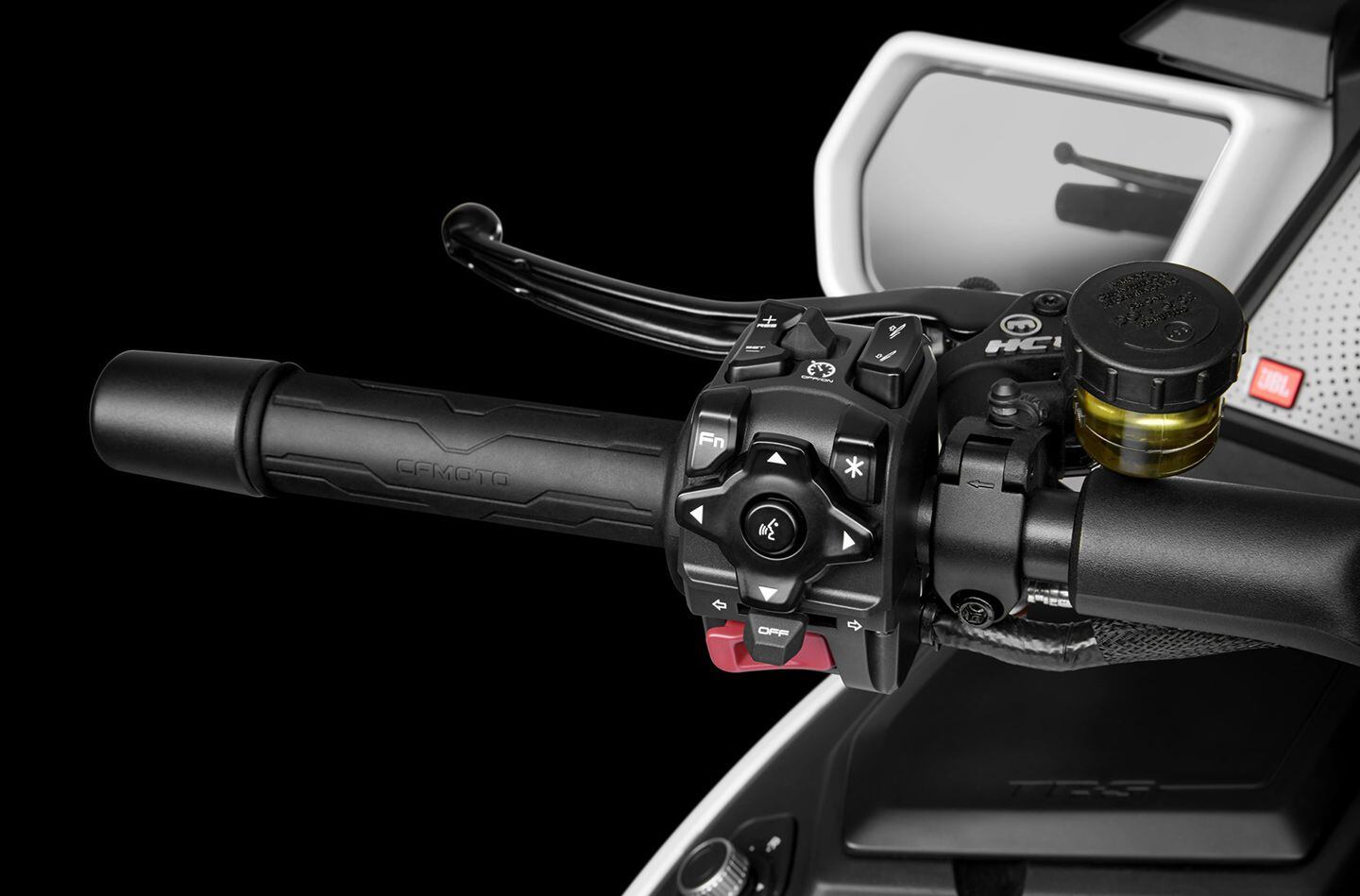
A view of the 1250 TR-G’s control pod. (CFMoto/)Much of the patent application is dedicated to explaining the intricacies of the damping adjustment itself, including adjustable valves in the fork and an actuator in the rear shock that moves a piston inside the remote reservoir to change its volume and the pressure of the oil in the shock. However, it’s the use of a camera to “read” the road surface that really distinguishes the system from other systems. Since built-in cameras are already becoming increasingly widespread—particularly on bikes sold in the Chinese market—it’s a logical step to incorporate them into future adaptive-damping systems.
While the patent illustrates the system on the 1250 TR-G, there’s no reason that the same idea couldn’t be incorporated into other CFMoto models, including those that are offered in the USA, in the future.
-
 1
1
-
-
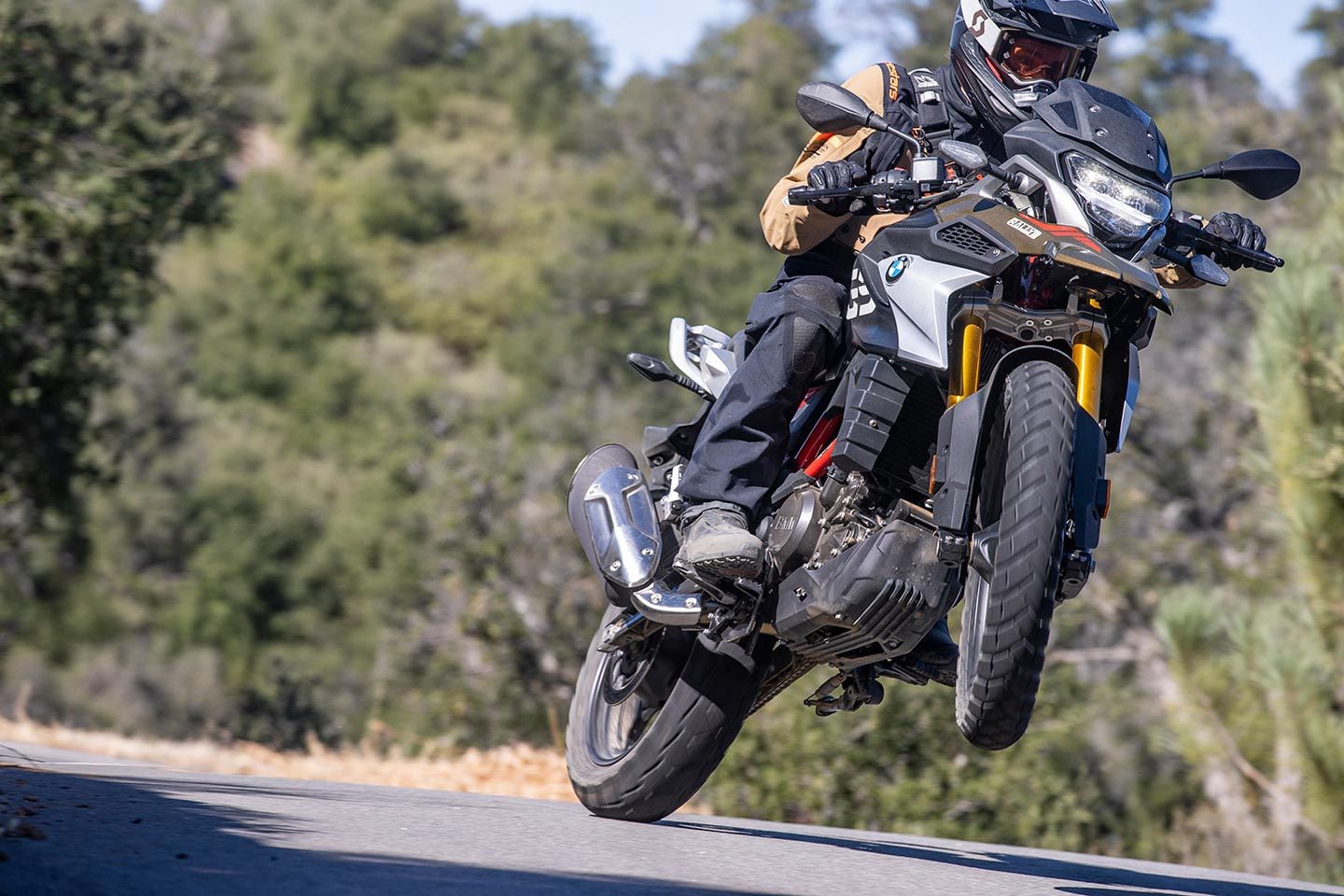
The BMW G 310 GS can be described in one word: playful. (Jeff Allen/)Originally available to US riders in 2018, the G 310 GS is BMW’s take on the lightweight adventure bike segment. BMW developed the G 310 GS on the already existing G 310 R platform manufactured in India, but configured this dual-purpose machine with off-road friendly components. The G 310 GS has seen small revisions throughout the years, mostly for Euro 5 compliance. In 2021, the bike received full LED lighting, adjustable levers, anti-hopping clutch, automatic idle boost, and an electronic throttle.
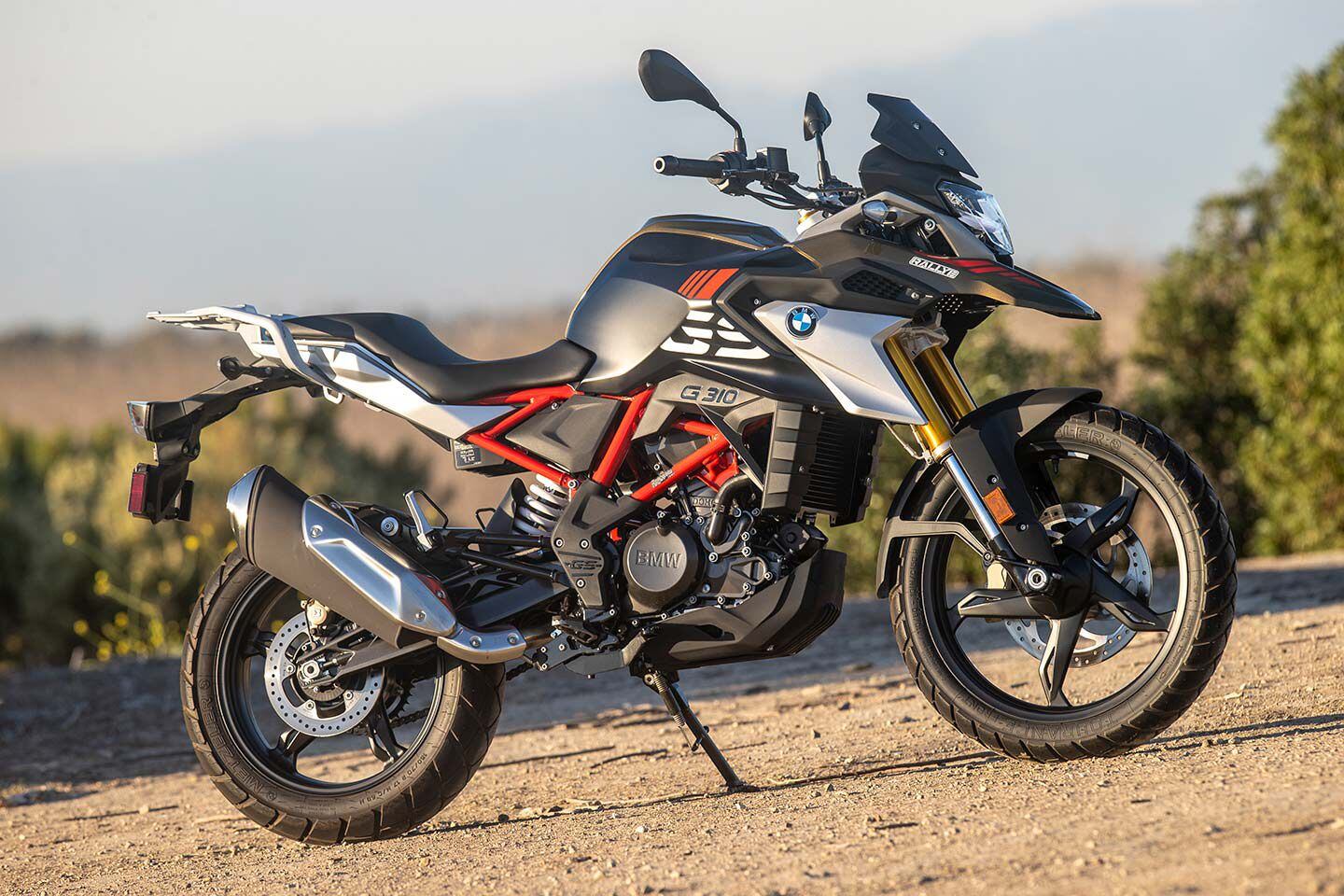
The 2023 BMW G 310 GS Rallye in Kalamata Dark Gold Metallic ($6,485). (Jeff Allen/)For 2023, the BMW G 310 GS ($6,485 with Rallye paint) utilizes the same 313cc DOHC liquid-cooled single-cylinder engine with a backward-facing cylinder and cylinder head found in the G 310 R. But the ADV variant has more suspension travel (7.1 inches of suspension travel whereas the R offers a little over 5 inches), 19-inch front wheel, longer wheelbase, and a more relaxed steering head angle of 26.7 degrees (310 R: 25.1 degrees).
BMW’s G 310 GS follows design cues from its larger sibling, the R 1250 GS, giving the lightweight adventure bike full-size aesthetics with a relatively low seat height of 32.8 inches. No ride modes are present and the only electronic rider aid is non-switchable ABS (2020 and previous models benefit from switchable ABS).
Related: The Different Types of Motorcycles
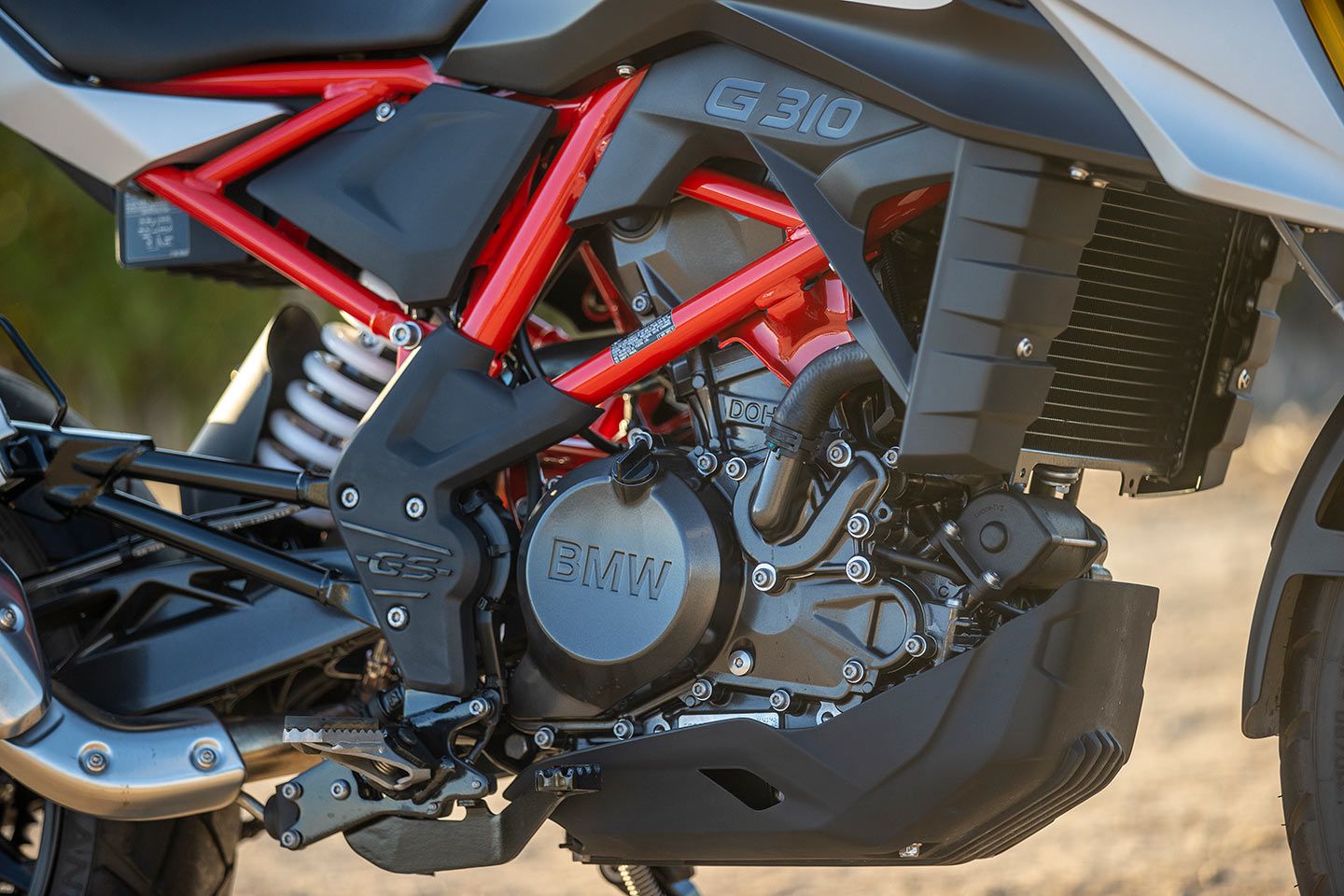
The BMW G 310 GS’s top-end performance may be attributed to its bore and stroke of 80mm x 62.1mm. (Jeff Allen/)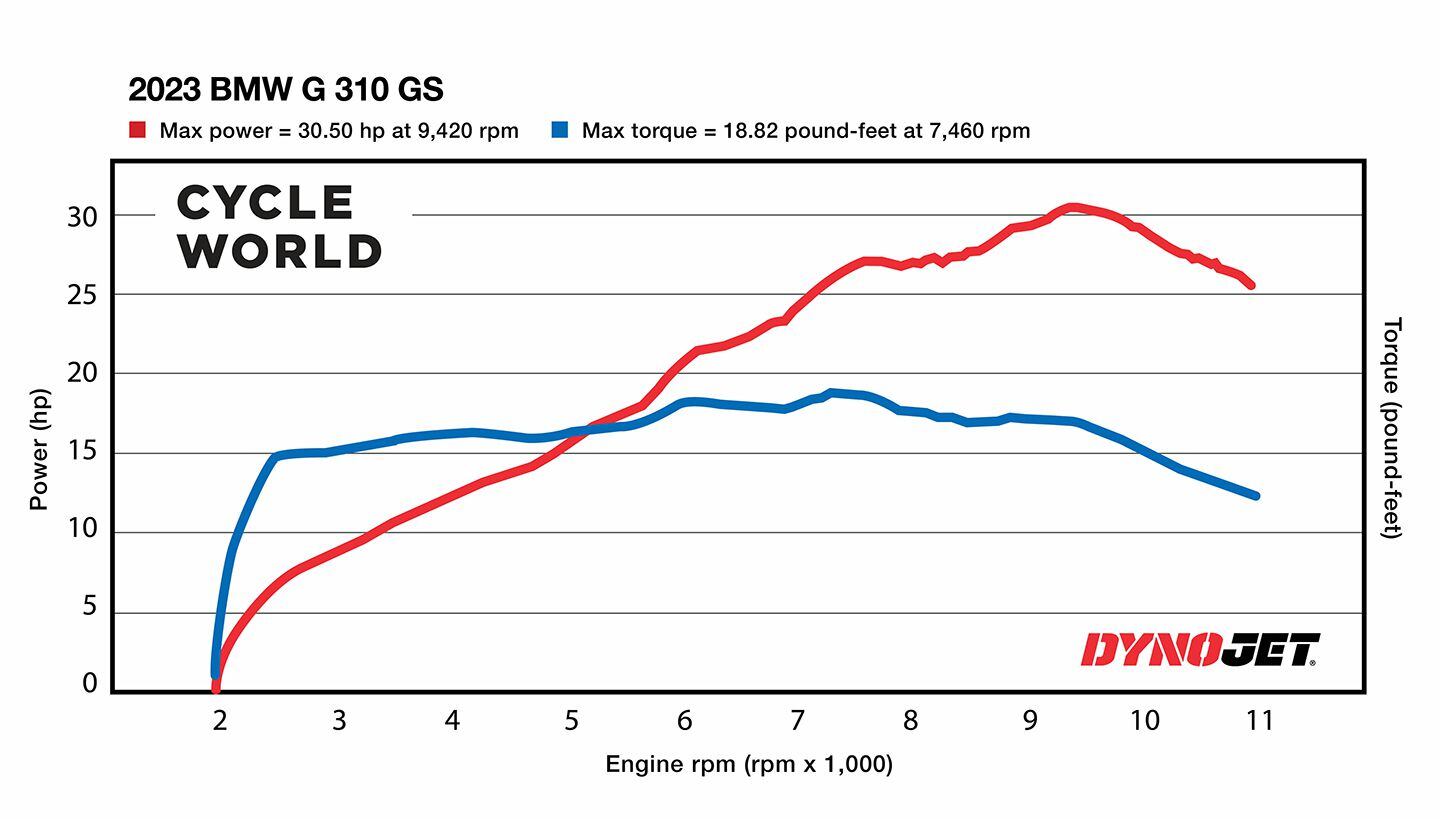
2023 BMW G 310 GS dyno chart. (Robert Martin/)The 313cc single offers an extremely linear power delivery all the way up to its approximate 11,000 rpm redline. On our in-house Dynojet 250i dynamometer, the 2023 BMW produced 30.5 hp at 9,420 rpm and 18.8 lb.-ft. of torque at 7,460 rpm. Peak power is produced after 9,000 rpm—and that is felt on the road. Revving the engine to its cutoff provided the most drive out of corners. But its soft bottom-end proves useful with easy modulation for less experienced riders. Off-road the powerplant offers usable low-end torque that helps keep the road-biased Metzeler Tourance rear tire hooking up. Throttle response is soft but direct. Sliding corners or chugging up a hill, inputs applied at the throttle predictably translate to power delivery at the rear wheel.
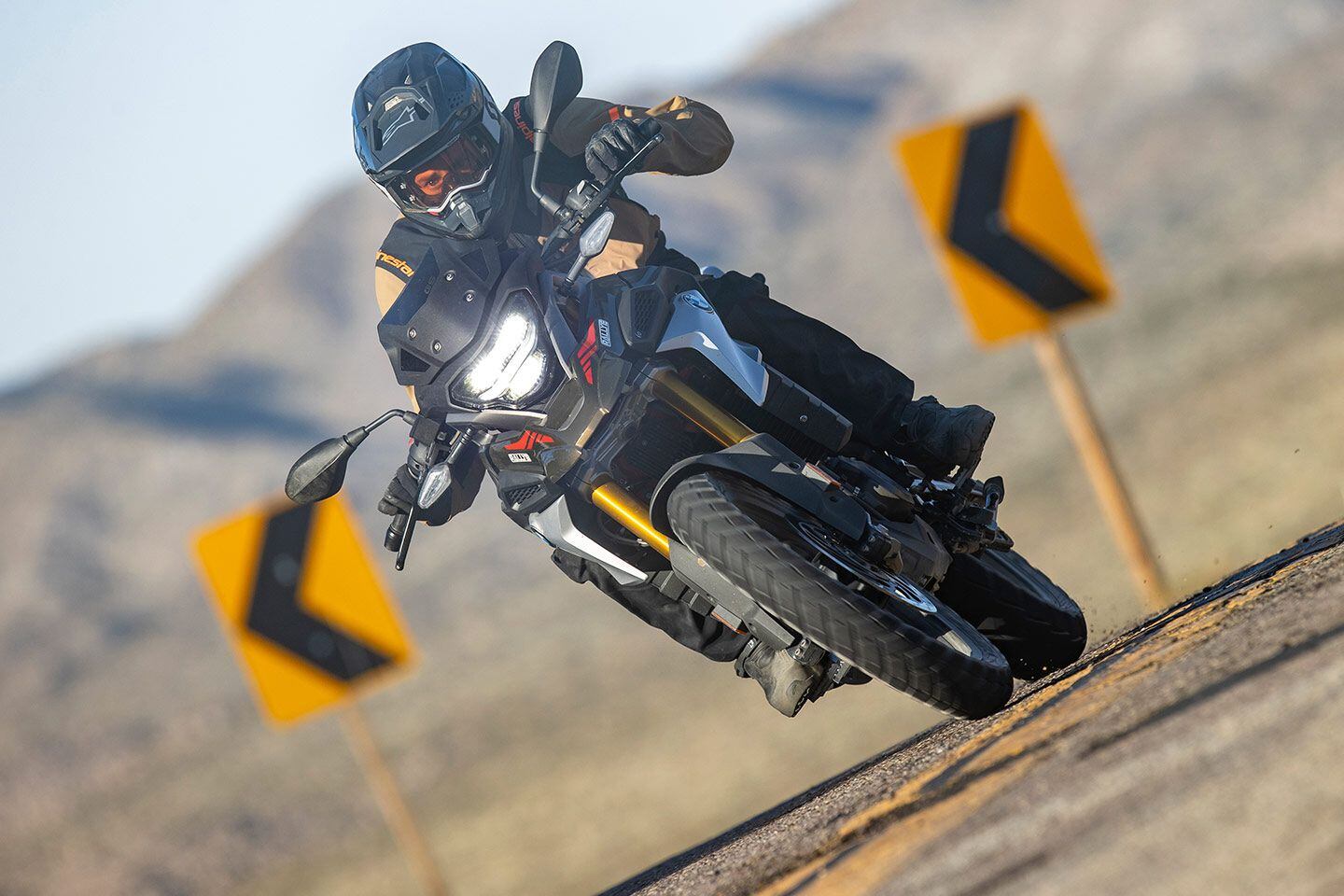
Putting the power down. Nailing shifts on a twisty uphill is imperative to maintain drive out of a corner. (Jeff Allen/)Suspension settings are soft and comfortable. Cruising around town or traversing a canyon road at moderate speeds, the components provide heaps of feedback, giving the rider a sense of control as well as increasing the available grip the surface has to offer. But aggressive riding will quickly find the limits of the BMW’s suspension. Charging down a twisty road, the suspension blows through the stroke and generates a lot of weight transfer, causing the steering to feel vague. Off-road, the supple suspension comfortably absorbs rocks and other small obstacles. But again, plowing through a rough section will quickly find the components’ limitations and make the bike a handful.
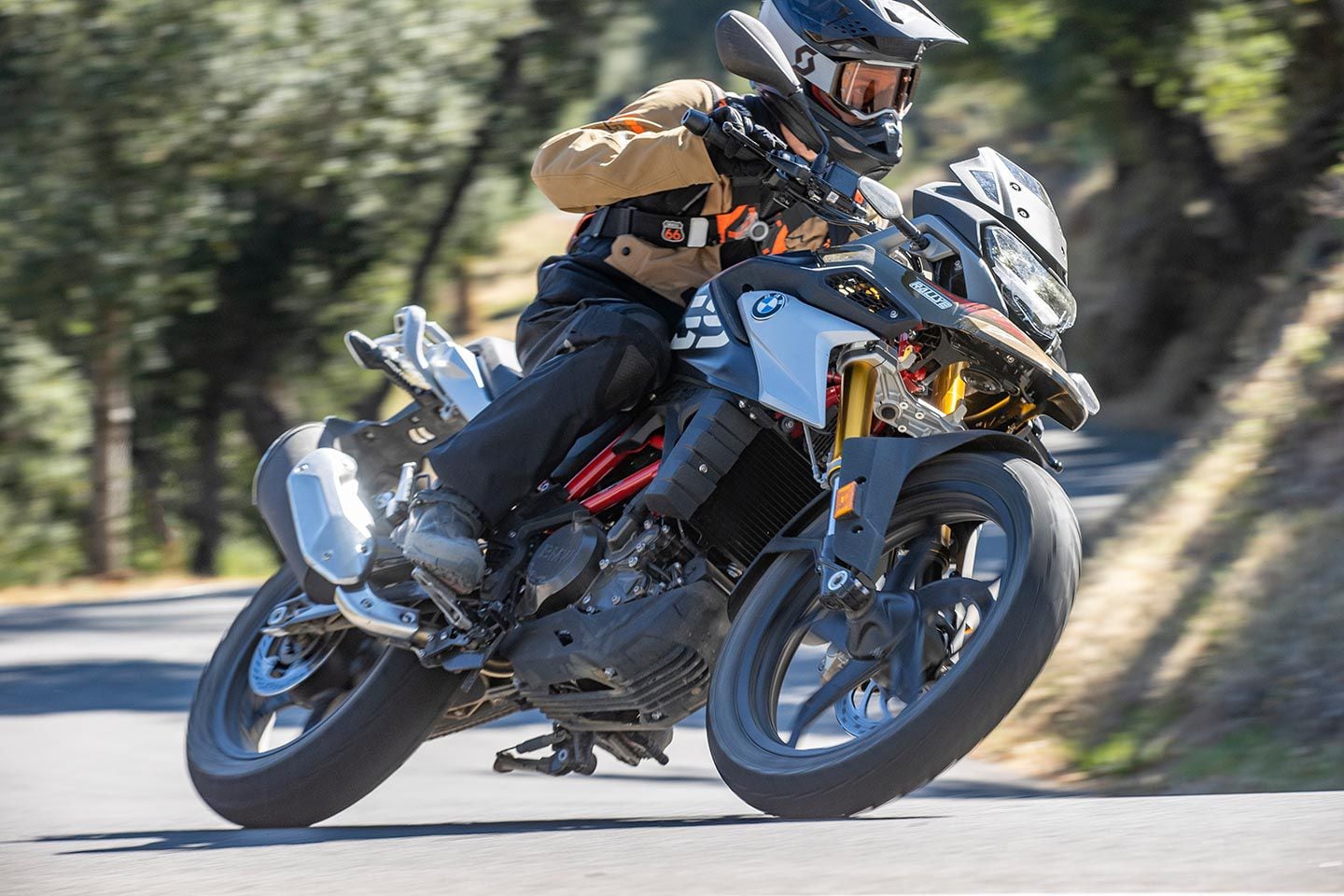
Carrying its weight well, this mini GS effortlessly rolls onto the side of its tire. (Jeff Allen/)On the Cycle World automotive scales, the 2023 BMW G 310 GS weighs in at 384 pounds. For reference, the 2020 KTM 390 Adventure is 387 pounds on our scales. Although the BMW may be hefty on paper, in motion the bike is agile and quick steering. There may be no better bike to navigate a crowded parking lot or busy side street.
An extremely light clutch lever pull further adds to the vehicle’s ease of use. Neutral ergonomics put the rider in an upright seating position that is comfortable on all-day excursions. But in the dirt, the G 310 GS’s close relation to the G 310 R is apparent. Standing up, the handlebar is uncomfortably low and the footpegs are too small. Resting your boot on the exhaust heat shield is inevitable. The BMW’s large rally-style fairing provides good wind protection for the body but the small windscreen doesn’t offer much protection near the helmet.
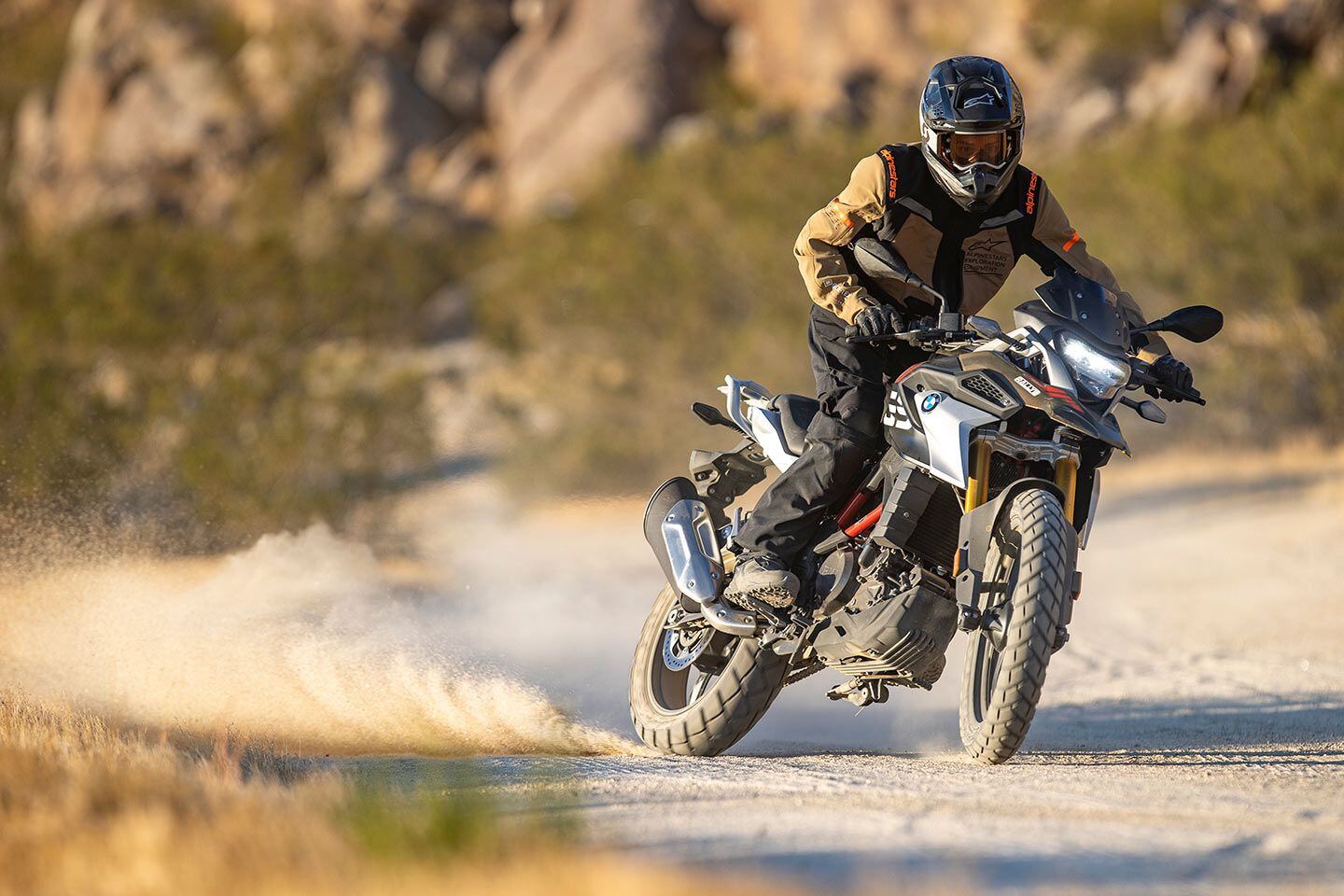
With no traction control rider aid, managing rear wheel grip is solely dependent on the pilot. (Jeff Allen/)ByBre braking components are fitted at both ends of the motorcycle. Up front is a single four-piston radial-mounted caliper with a 300mm disc. At the back is a single-piston caliper with a 241mm disc. The components are responsive and progressive, but pronounced fork dive is present. Entering corners under hard braking the fork inevitably lives at the bottom of the stroke. No fault of the binders, just soft suspension.
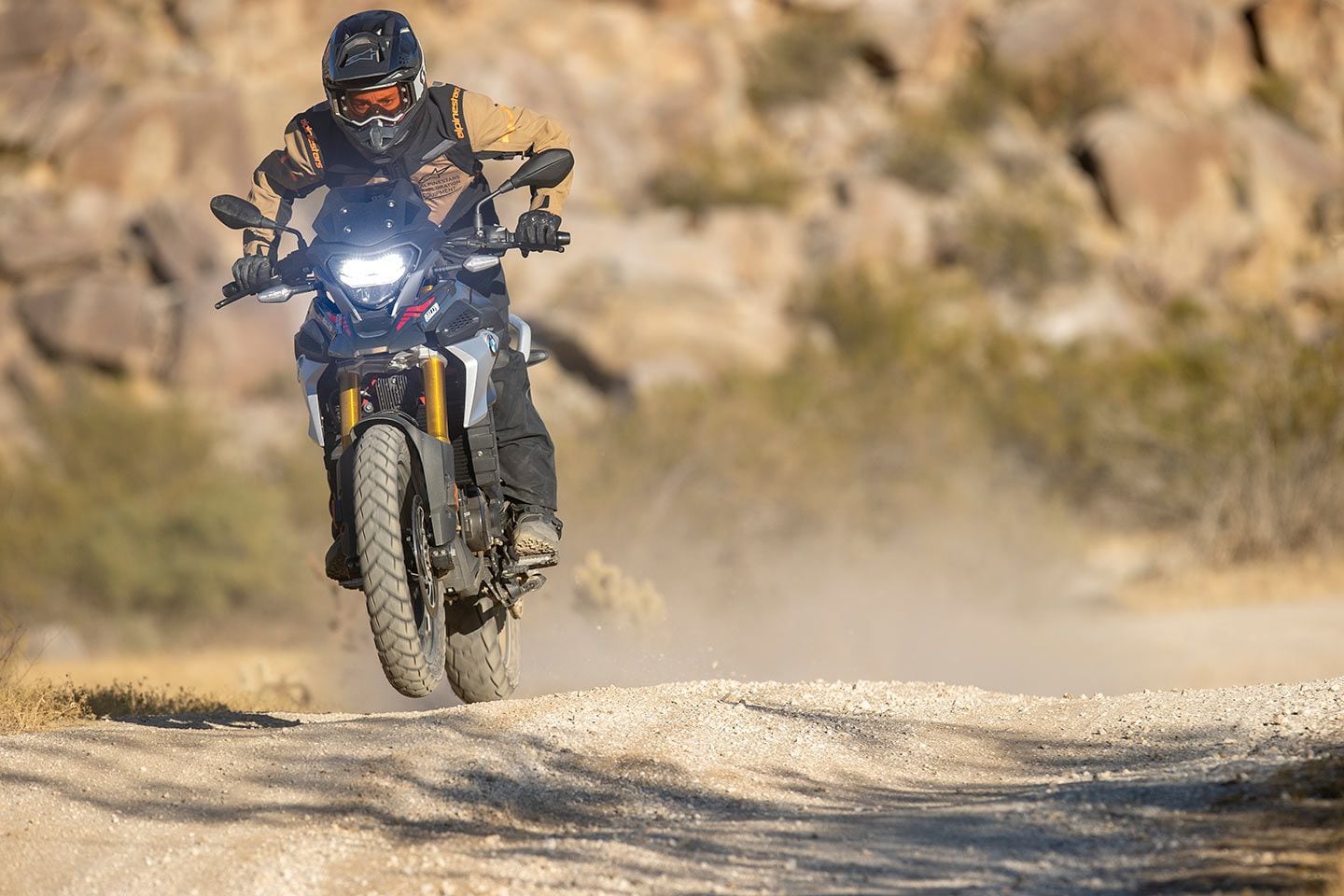
The GS’s short windscreen allows the rider to get their head over the front of the bike in an off-road setting. (Jeff Allen/)BMW’s G 310 GS is not a hardcore adventure bike. And it was never intended to be. Instead, the German manufacturer developed an urban dual sport based off of the already existing G 310 R roadster, with moderate off-road abilities. Any rider looking for a true off-roader at a similar price point should consider a small-displacement dual sport such as Kawasaki’s KLX300 or Honda’s CRF300L. But anyone who wants an accessible adventure motorcycle with BMW pedigree in an approachable package, look no further than the BMW G 310 GS.
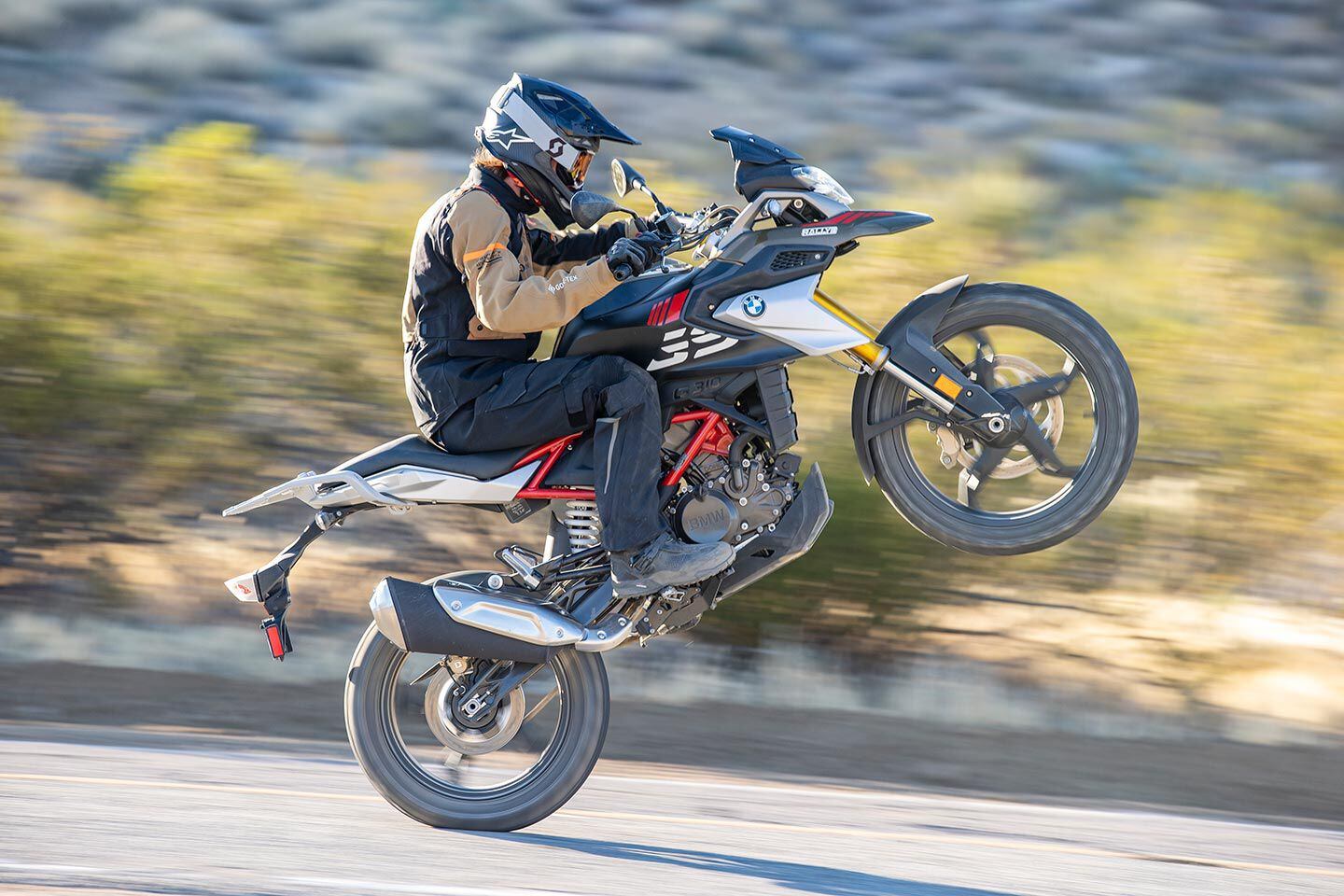
Yes, the G 310 GS is certainly capable of wheelies. (Jeff Allen/)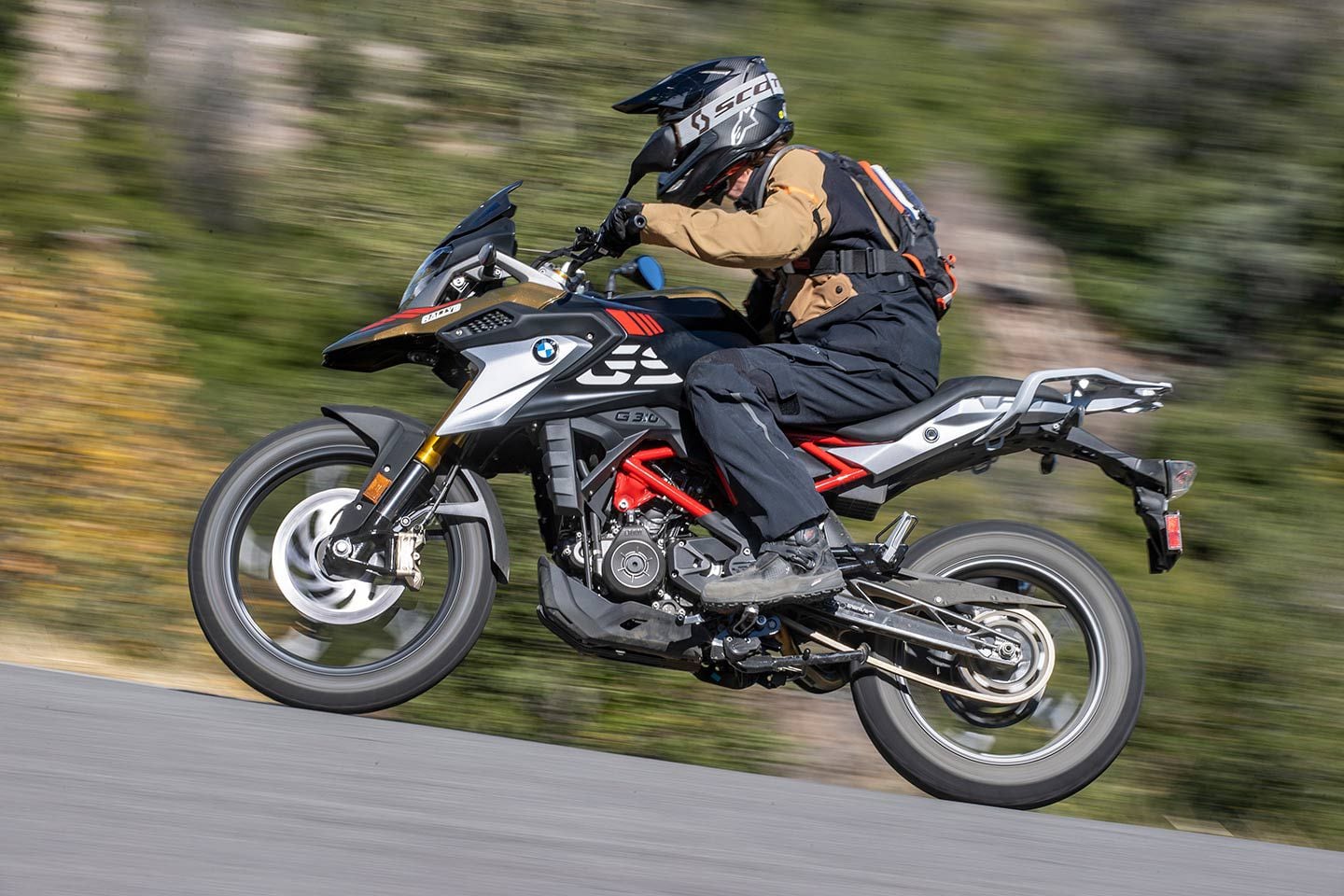
The six-speed gearbox is tight and slick making it easy to change gears at any speed. (Jeff Allen/)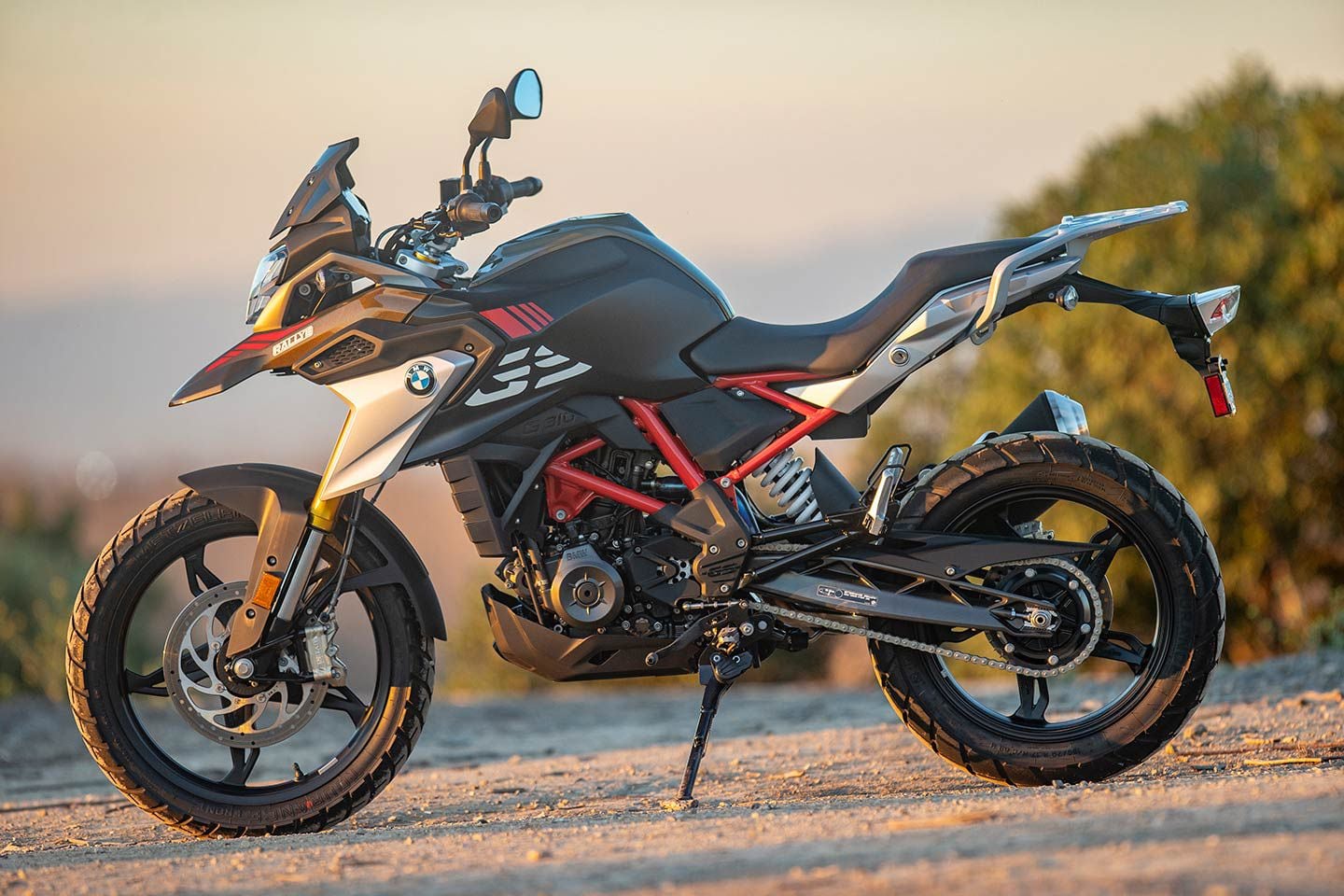
Standard seat height on the 2023 BMW G 310 GS is 32.8 inches. BMW offers a low seat option of 32.3 inches or a high seat option of 33.4 inches. (Jeff Allen/)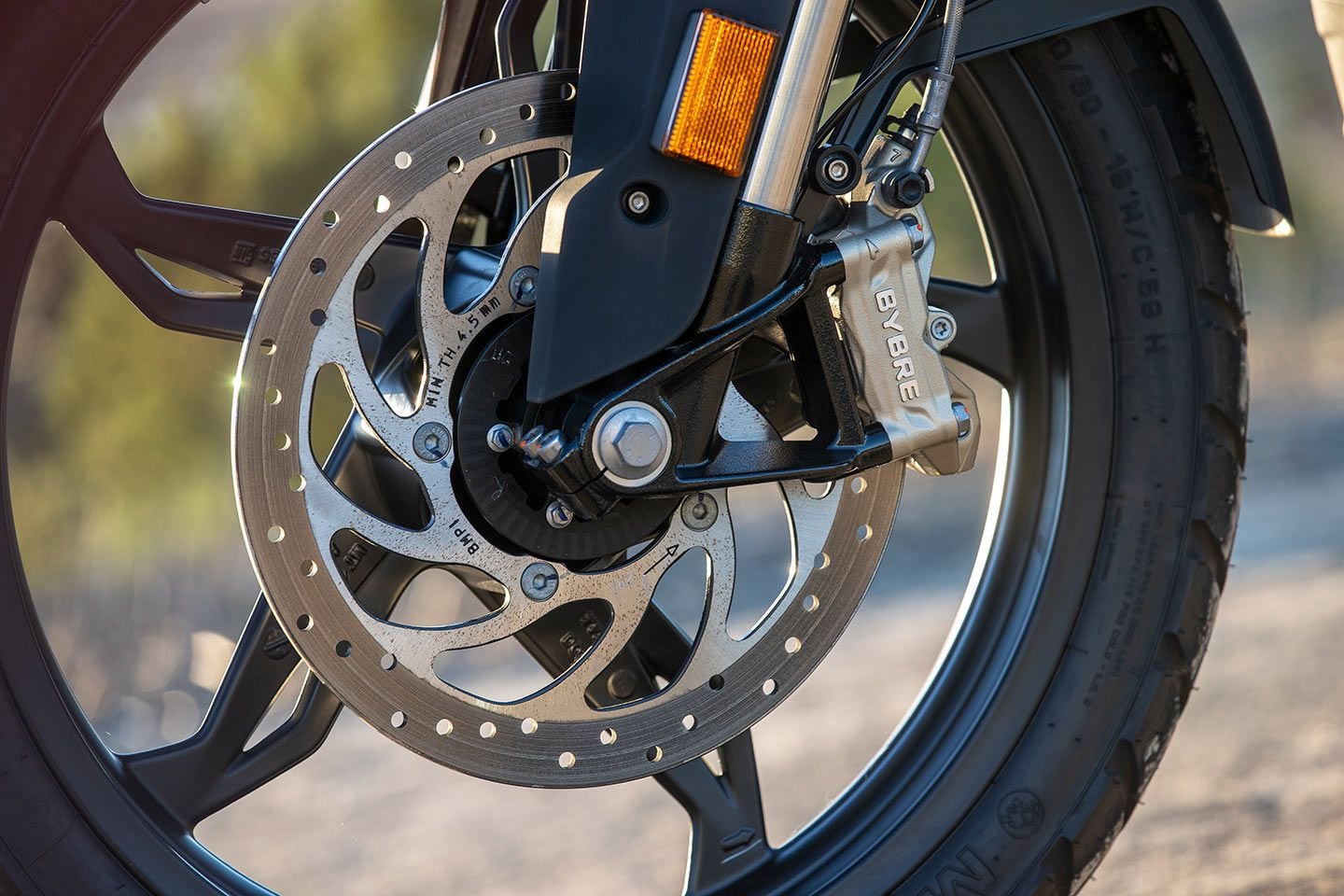
BMW fitted the G 310 GS with a four-piston ByBre caliper, resulting in ample stopping power from the 300mm disc. (Jeff Allen/)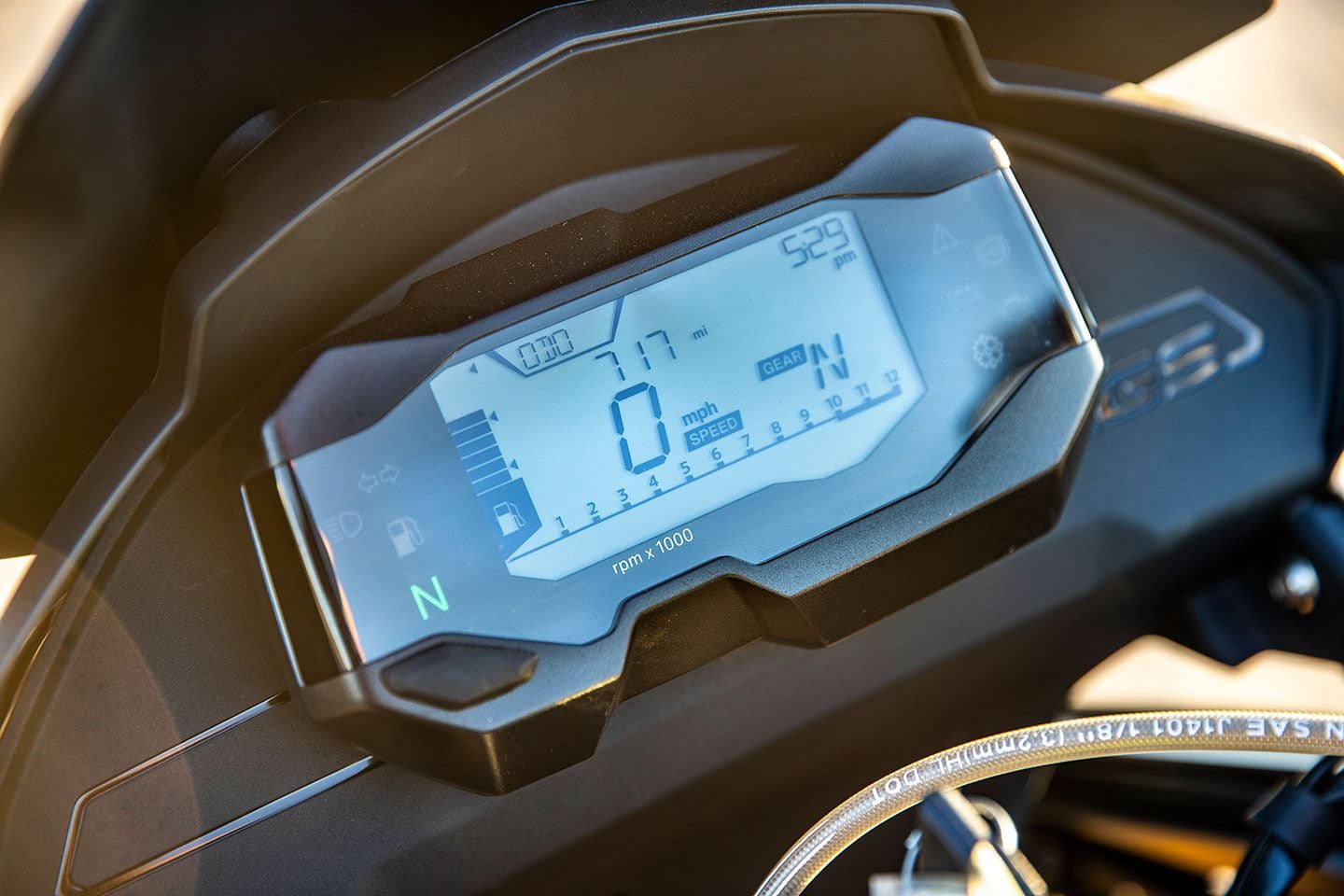
The digital dash is rudimentary but very functional. And the gear position indicator is a nice touch. (Jeff Allen/)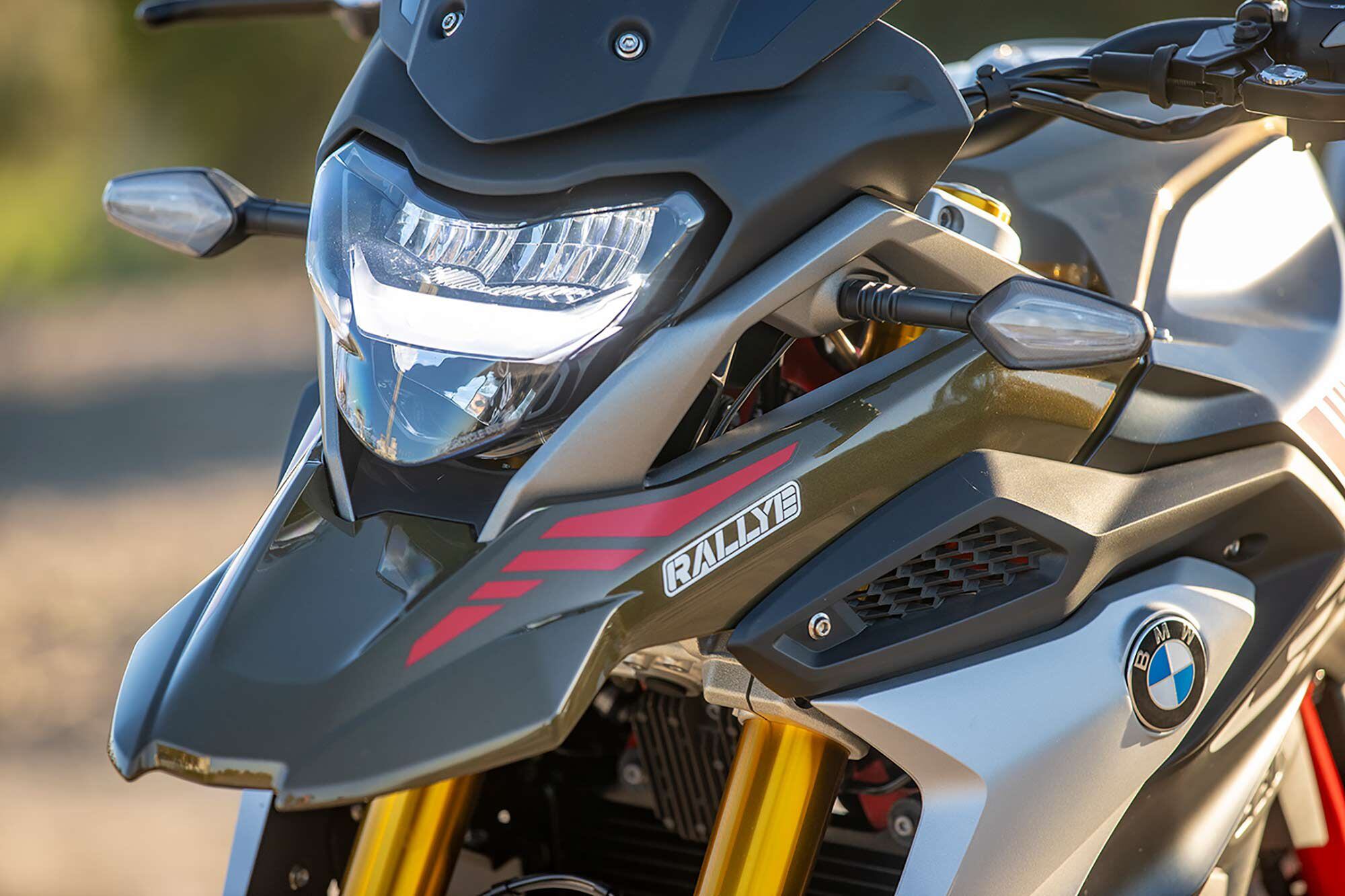
BMW equipped the G 310 GS with a LED headlight, taillight, and turn indicators. (Jeff Allen/)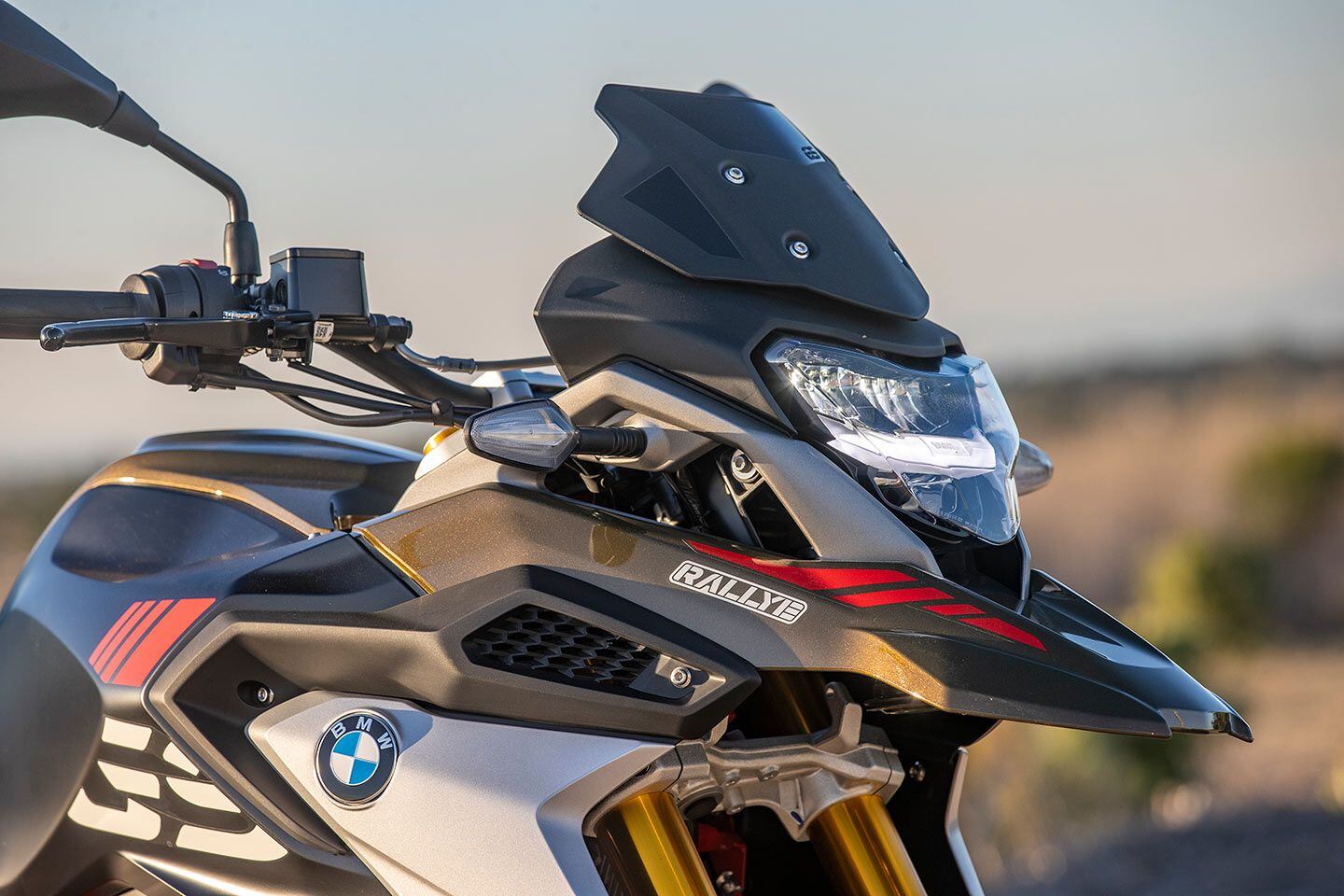
BMW gave the G 310 GS traditional ADV beak styling. The Kalamata Dark Gold Metallic paint and red frame are a nice touch too. (Jeff Allen/)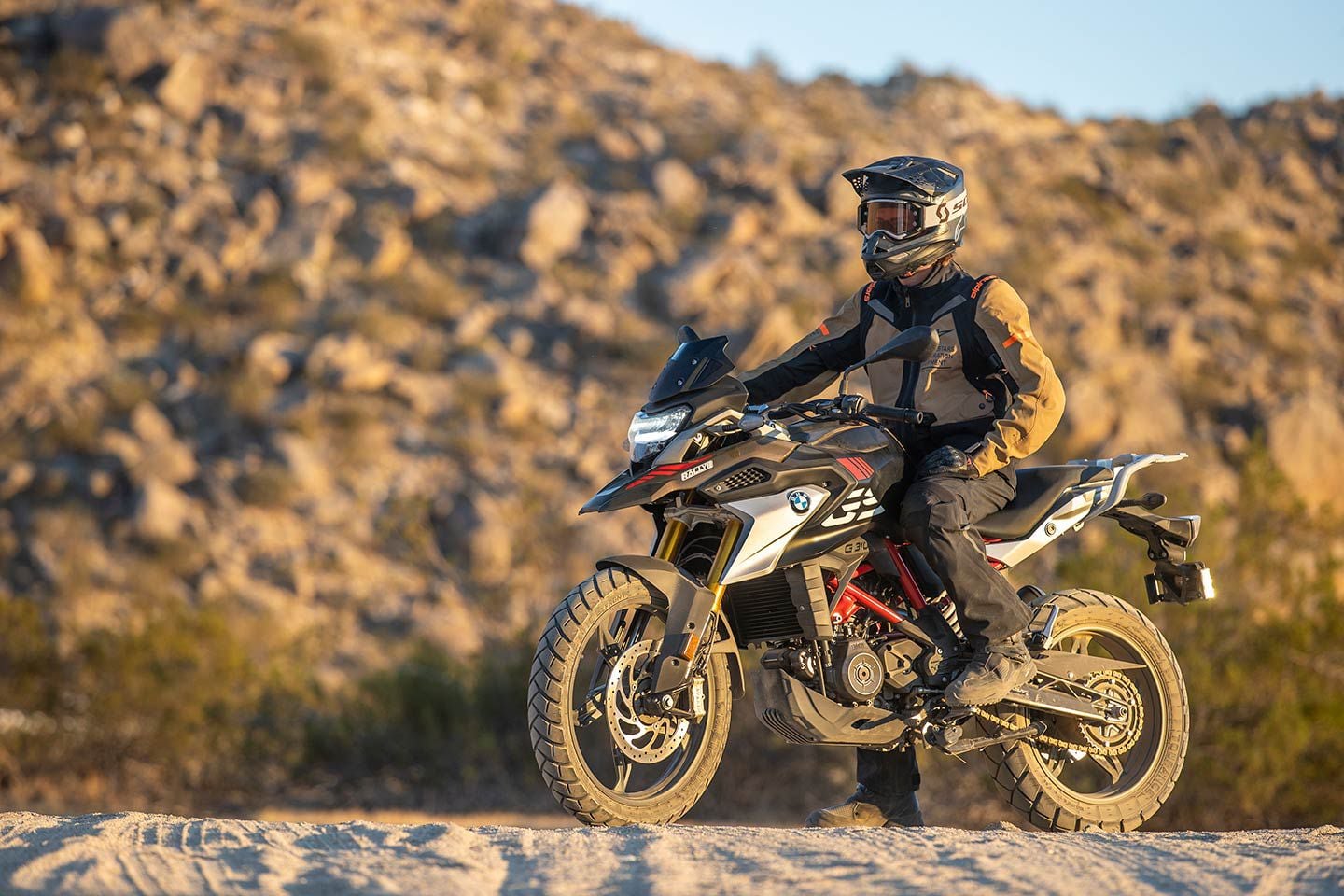
The BMW G 310 GS is not all bark and no bite. For modest off-road adventures, the lightweight ADV will surely get you there. (Jeff Allen/)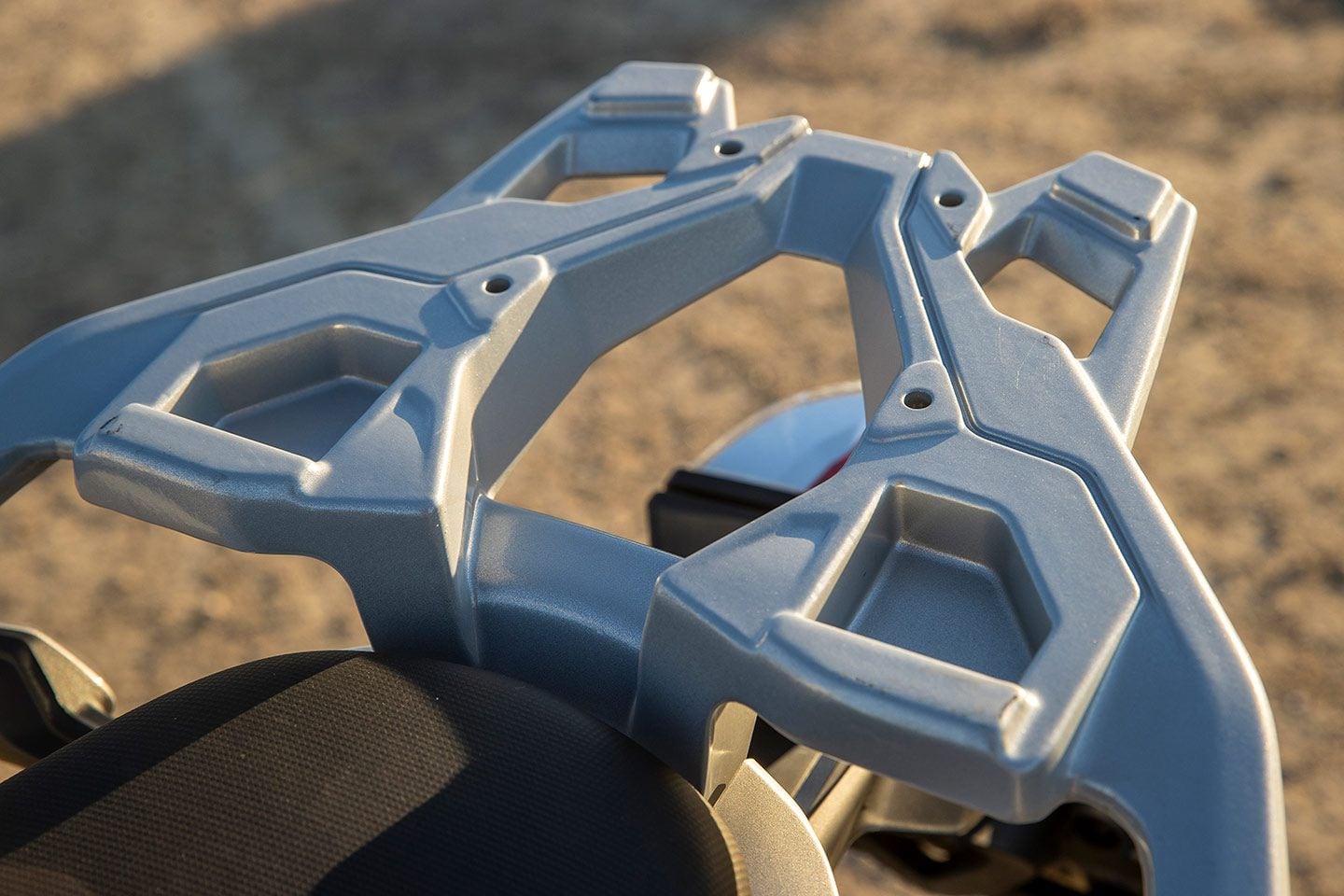
Adding to the vehicle's utility is a large luggage rack. BMW offers a hard, 29-liter top case as an accessory. (Jeff Allen/)2023 BMW G 310 GS Rallye Specs
MSRP: $6,458 Engine: DOHC, liquid-cooled, 4-stroke single cylinder; 4 valves/cyl. Displacement: 313cc Bore x Stroke: 80.0 x 62.1mm Compression Ratio: 10.9:1 Transmission/Final Drive: 6-speed/chain Cycle World Measured Horsepower: 30.5 hp @ 9,420 rpm Cycle World Measured Torque: 18.8 lb.-ft. @ 7,460 rpm Fuel System: Electronic fuel injection w/ ride-by-wire Clutch: Wet, multiplate anti-hopping Frame: Tubular space Front Suspension: 41mm inverted; 7.1 in. travel Rear Suspension: Central spring strut, spring preload adjustable; 7.1 in. travel Front Brake: 4-piston radial-mounted ByBre fixed caliper, 300mm disc w/ ABS Rear Brake: 1-piston ByBre floating caliper, 241mm disc w/ ABS Wheels, Front/Rear: Cast aluminum; 19 x 2.50 in. / 17 x 4.00 in. Tires, Front/Rear: 110/80-19 / 150/70-17 Rake/Trail: 26.7°/3.9 in. Wheelbase: 55.9 in. Ground Clearance: N/A Seat Height: 32.8 in. Fuel Capacity: 3.0 gal. Average MPG: 53.8 mpg Cycle World Measured Wet Weight: 384 lb. Contact: bmwmotorcycles.com Gearbox
Helmet: Alpinestars Supertech M10 Fame
Goggles: Scott Prospect
Jacket: Alpinestars ST-7 2L Gore-Tex
Gloves: Alpinestars Megawatt V2
Pants: Alpinestars Revenant Gore-Tex Pro
Boots: Alpinestars XT-8 Gore-Tex

BMW Working on Superbike Aero
in Motorbike news
Posted
BMW has been working on advanced aerodynamics on its M 1000 RR for years, but the next goal is to help push the bike down into the corner via crossover air ducts. (BMW/)
Motorcycle aerodynamics have entered a completely new era over the last few years as MotoGP teams develop increasingly complex and effective solutions to boost speed. But the latest innovation comes from a company that isn’t involved in the MotoGP arms race, BMW.
While most aero innovations in motorcycling aim at increasing downforce, or at least counteracting lift, to push the tires into the asphalt, BMW is taking a different route and trying to use airflow to counteract centrifugal forces, reducing the work that the tires have to do and increasing cornering speeds in the process.
The Bavarian company has filed a patent application for a system of ducts that take air from one side of a bike and route it through to the opposite side, where it’s expelled through jetlike outlets. The single image accompanying the patent shows a simplified view of the underside of a bike fitted with the system and demonstrating the route that the air takes. The bike in the illustration is moving from right to left, so the wider section of fairing is toward the front.
In order to be able to race with winglets and advanced aerodynamic features, motorcycles must be fitted with them on the stock bike that the racing bikes are derived from. (BMW/)
You’re probably thinking that the two air ducts and their corresponding jets must surely counteract each other? The patent explains that when the bike is going in a straight line, that’s true: The air on each side of the bike moves at the same speed, so the two ducts cancel each other out. But all that changes when the bike leans over into a corner.
A patent illustration of the underside of a faired motorcycle, like the M 1000 RR, that shows how the air ducts cross over intaking air on the side closer to the road surface and exhausting it on the higher side to help push the bike down into the road. (BMW/)
This is the clever bit. When you’re cornering (for example turning left) the airflow on the opposite side (the right) can separate from the fairing, reducing the pressure on that side. Meanwhile, the pressure on the side that’s closer to the ground (the left in our example) increases. Essentially, it’s like the road surface and the fairing’s side act together to become an extended, wider channel for the duct on that side, squeezing the air toward the intake. Because the ducts cross over, that means the “jet” outlet on the opposite side expels more air, at higher pressure, pushing the tire toward the ground and the bike into the corner.
BMW’s patent goes on to explain that by making the intake larger than the outlet, and giving the outlet a nozzle-like design, you can increase the velocity of the air exiting from the “jet.” The document gives the example of having a 5,000mm2 intake (7.75 square inches) and a 1,000–2,000mm2 outlet (1.55 to 3.1 square inches).
Since BMW doesn’t compete in MotoGP, where an idea like this could be applied on a purely prototype machine, it’s possible the company is considering using the technology on a road-going superbike. The M 1000 RR would be the logical machine to adopt it since it’s a track-oriented bike that competes in WSBK racing.
View the full article